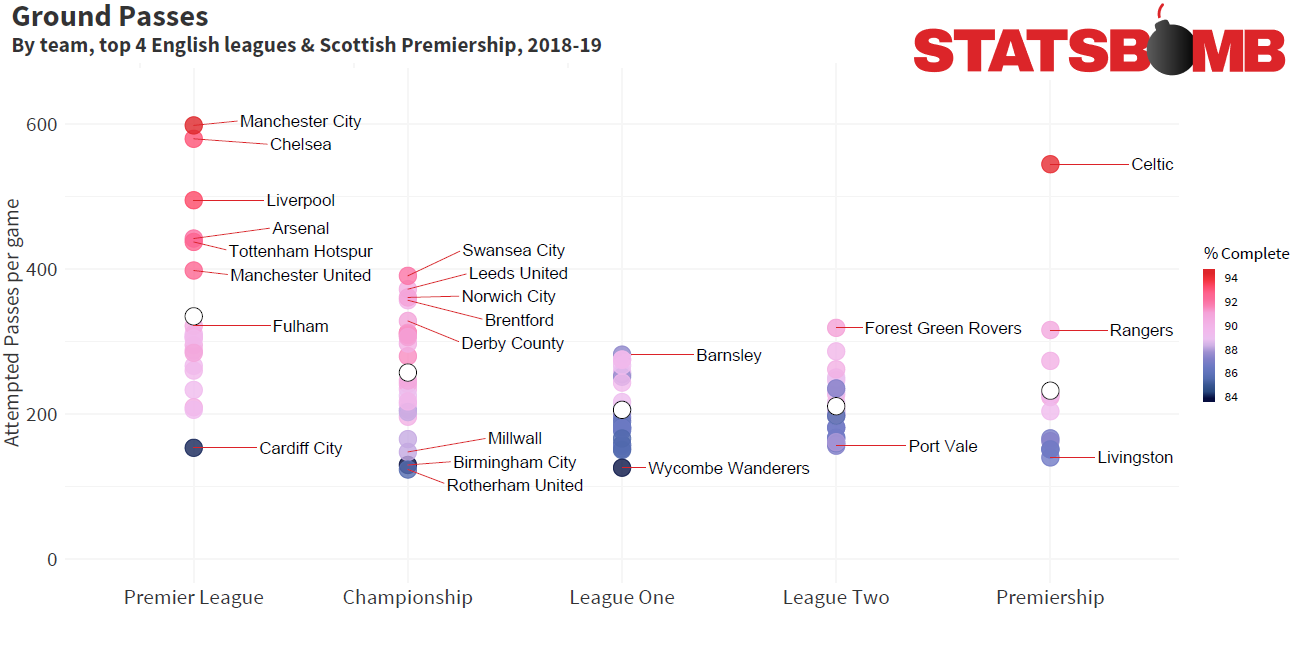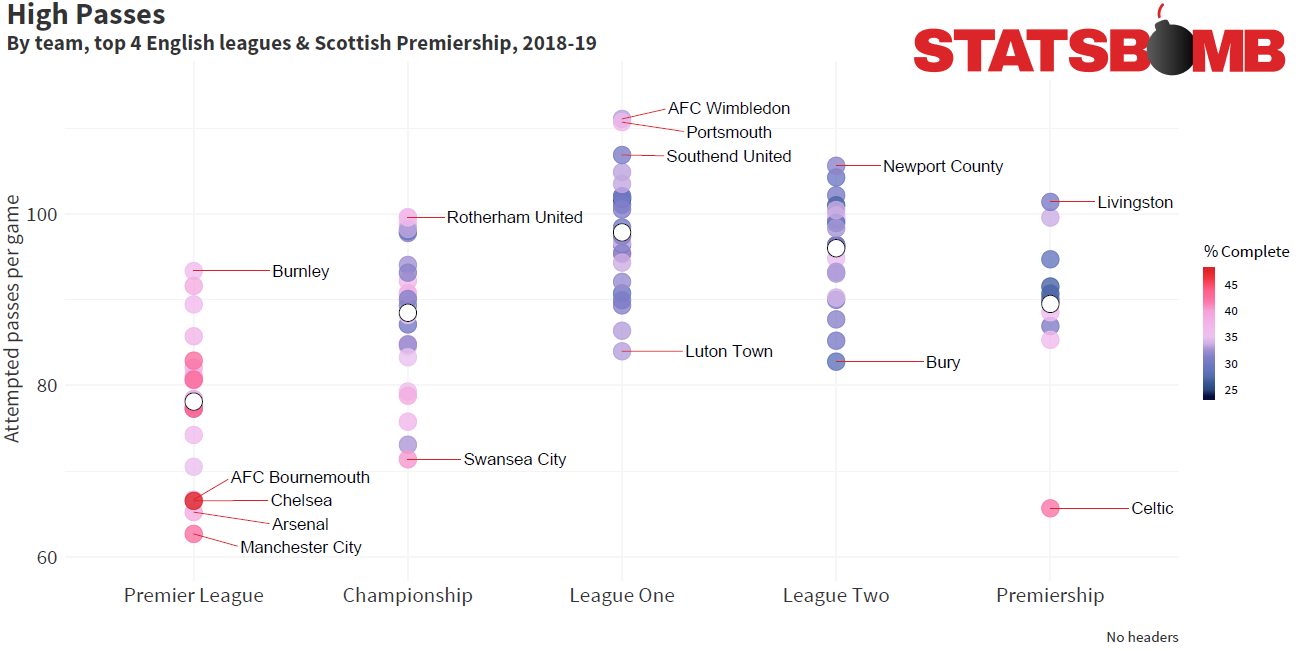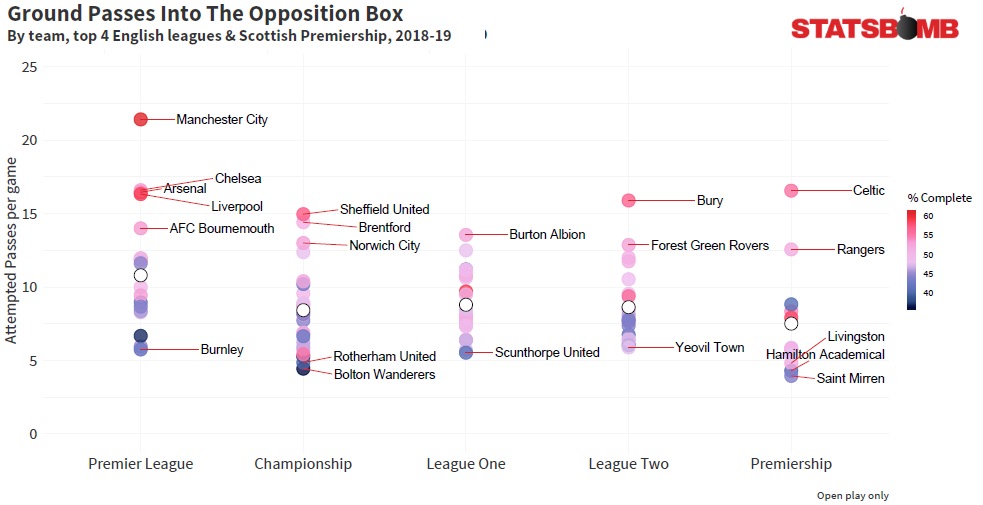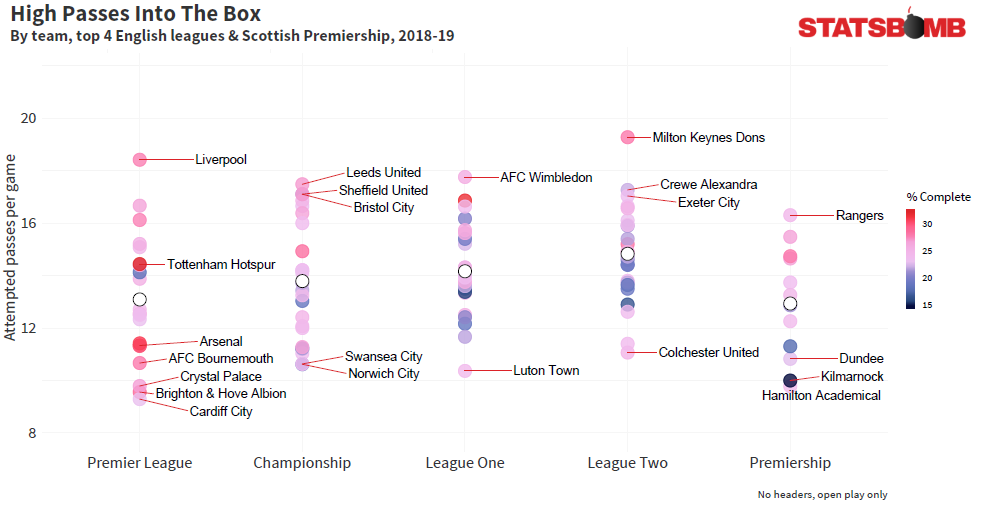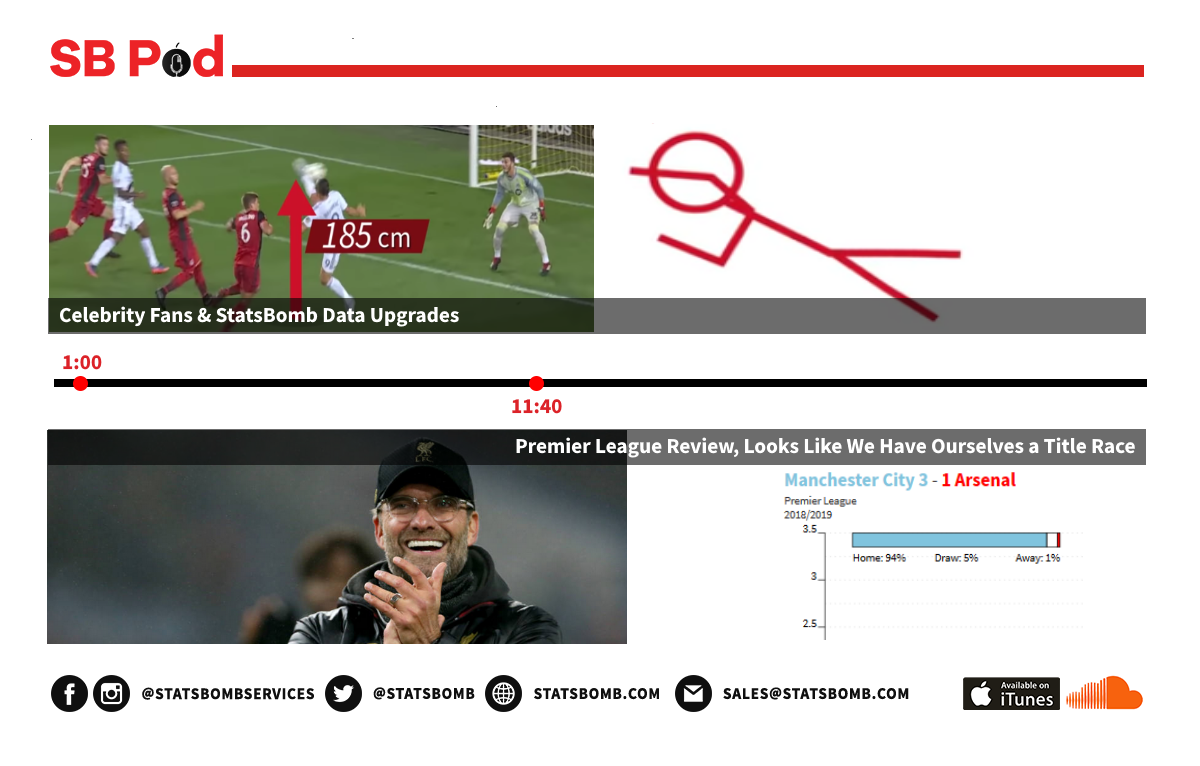On Thursday, Diego Simeone inked a new deal with Atletico Madrid, one that will see him stick around in Madrid until 2022. The deal was announced shortly after Spanish media had begun writing their obituaries about Simeone’s team -- claiming it was the end of an era, and that we’re no longer witnessing the greatness of Atletico, the team that was so tactically sound just a couple of years ago.
But that Atletico are deemed as a team that’s suffering a painful death, all at a time where they lie third-place in La Liga and are going into a Champions League knockout tie against Juventus, only illustrates the bar they’ve set for themselves -- a bar which was non-existent before Simeone’s arrival.
In the 1999 - 2000 season, Atletico Madrid beat Real Madrid at the Bernabeu. They didn’t beat their cross-town rivals again for another 13 seasons -- a staggering streak that finally ended when Simeone came along. They followed that up by going undefeated against Real in La Liga for three years, outscoring them 11 - 4 in the process. During Simeone’s reign, Atletico became league champions, never finished below third, and made two Champions League final appearances. That’s the bar.
Somewhere along the way, Atletico stopped exceeding old expectations and started falling short of new ones. This is a team built on their defensive identity and a “we’ll outwork you and win every 50/50” mindset. They’ve consistently scraped narrow wins through tenacity and defensive organization; and despite creating very little offensively, have had efficiency in front of goal. As expectations rose, as Antoine Griezmann gained stardom, and as the club began spending, Simeone felt pressure to make the team look better offensively. They’ve yet to improve.
For years, Atletico’s defensive scheme was almost impenetrable. No team showed more patience without the ball than them. They closed the half-spaces and coaxed teams into switching the field to an open player, only to snuff out space as soon as the ball got there. Against Barcelona in the 2016 Champions League quarter-finals, they churned out one of the greatest defensive performances from a side this decade.
They are not that far removed from that side defensively. This season, they’ve conceded the fewest goals in La Liga until now, and have the second lowest xGA of anyone in the country. But they’ve failed big tests. They were blown away by a rampant Borussia Dortmund side 4 - 0 earlier this season, where their wing-backs were exposed and unable to deny overloads, and Griezmann -- Atletico’s only consistent attacking threat -- was denied space by Favre’s suffocating press.
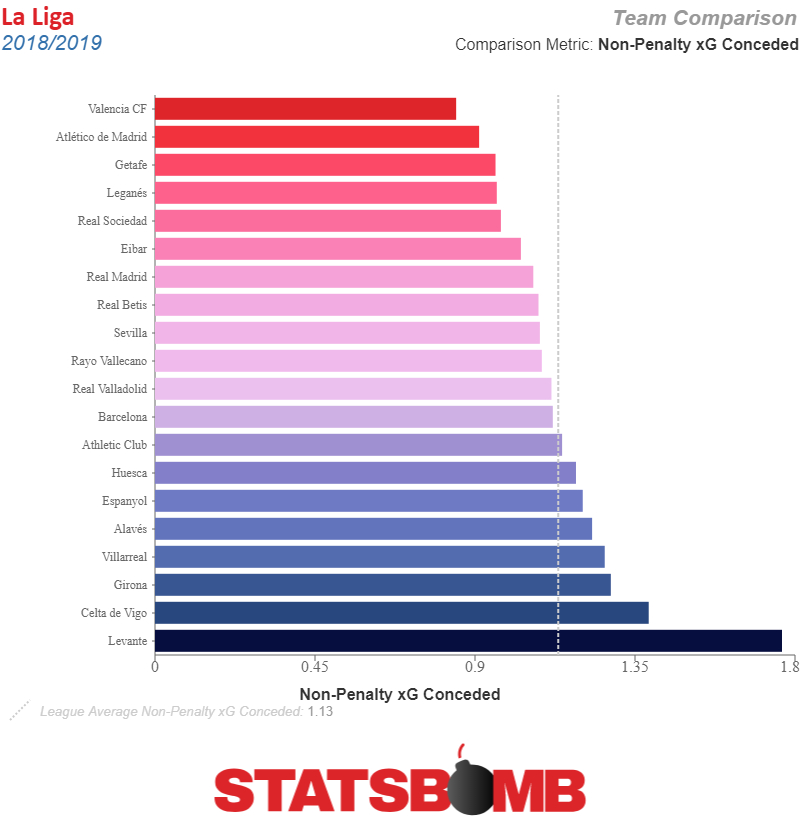
Nearly four months later, Atletico conceded three at home to Real Madrid in a game where they pressed aggressively and unnerved Santiago Solari’s men early; but had their right flank torn apart by Vinicius Jr before capitulating defensively in the second half -- falling apart vertically and spreading themselves thin defending counters.
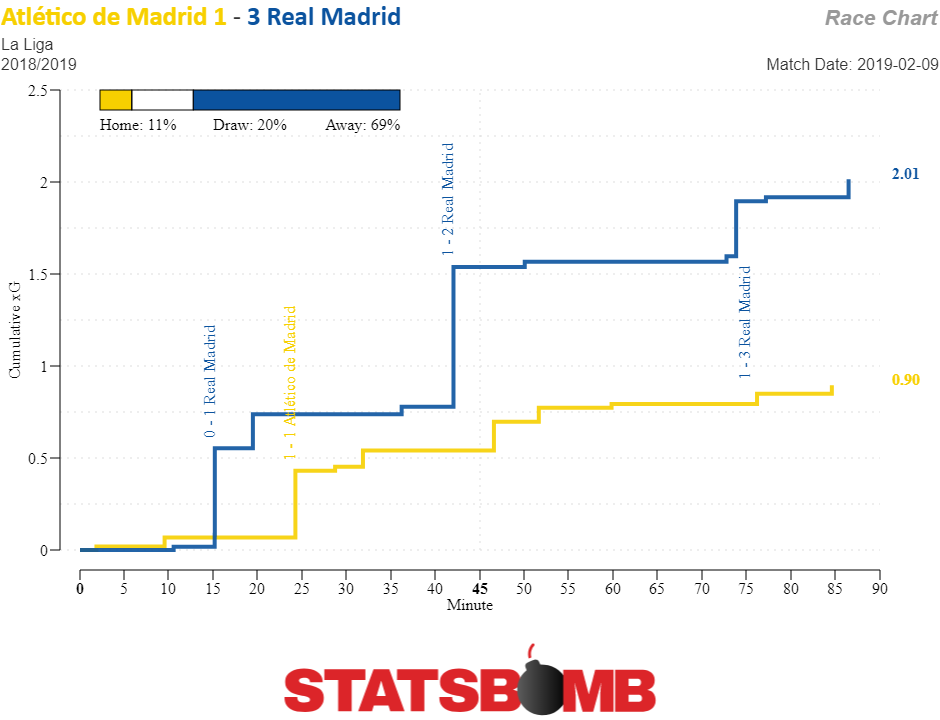
Atletico are still fine as an elite defensive side. They coast through the majority of La Liga games unscathed at the back. It remains all the more impressive when you realize how much time their defensive stalwarts have missed through injury this season. Juanfran, Lucas Hernandez, and Diego Godin have all missed nine games; Gimenez has missed 12; Felipe Luis has missed 10; Stefan Savic has missed 14. That Atletico have maintained such good defensive numbers despite their health issues is remarkable.
Those defensive numbers bode well for Atletico -- they haven’t yet let their identity slip. They now have their defenders healthy, and the first half against Real Madrid was encouraging enough to think they can maintain their defensive control against a dangerous side like Juventus in the Champions League..
Atletico’s struggles will come mostly on the offensive end, where they just don’t create nearly enough as they should as an elite side. Simeone has tried possession-based schemes in the past two seasons and it hasn’t looked convincing. He’s tried to decrease the offensive load of Griezmann by surrounding him with technical midfielders, fast wingers, and traditional finishers -- but none of the offensive pieces around him have been on the Frenchman’s level. Atletico’s xG is currently lower than all but five La Liga sides.
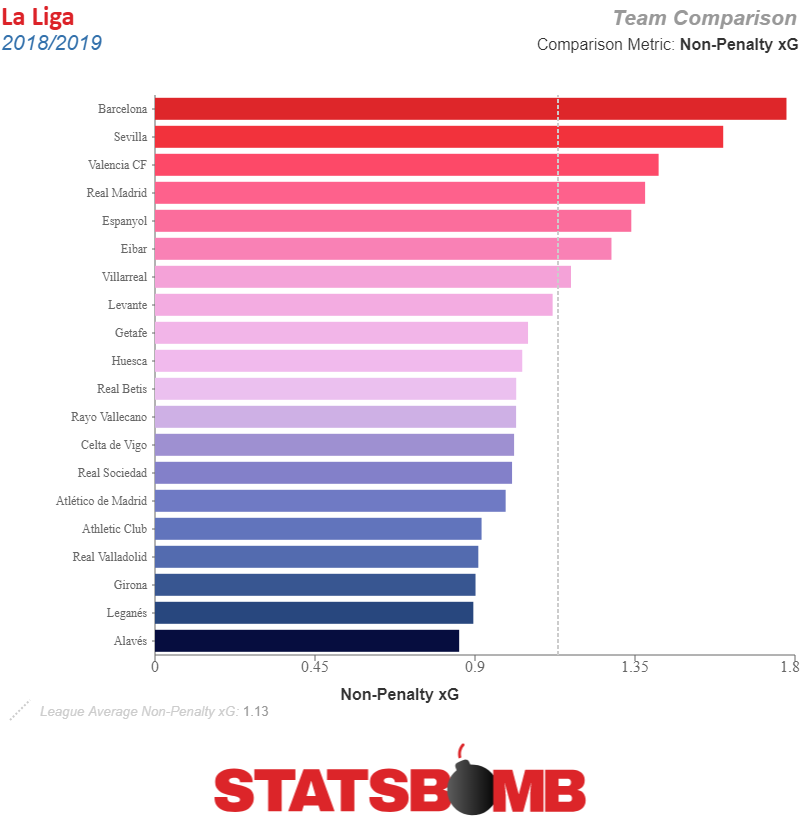
Griezmann has been really good, but he’s alone. Even with an Alpha-Grizzy pulling the strings offensively, the team labors to spring efficient counterattacks after their defensive line comes away with an intervention. The attack is slow. The team just doesn’t have a high enough block to get numbers in transition quickly, meaning Griezmann, or one of the other attacks in question, has to slow the tempo and wait for others to catch up. The scouting report is out -- most teams have a good enough transition defence to stifle Simeone’s slow counters.
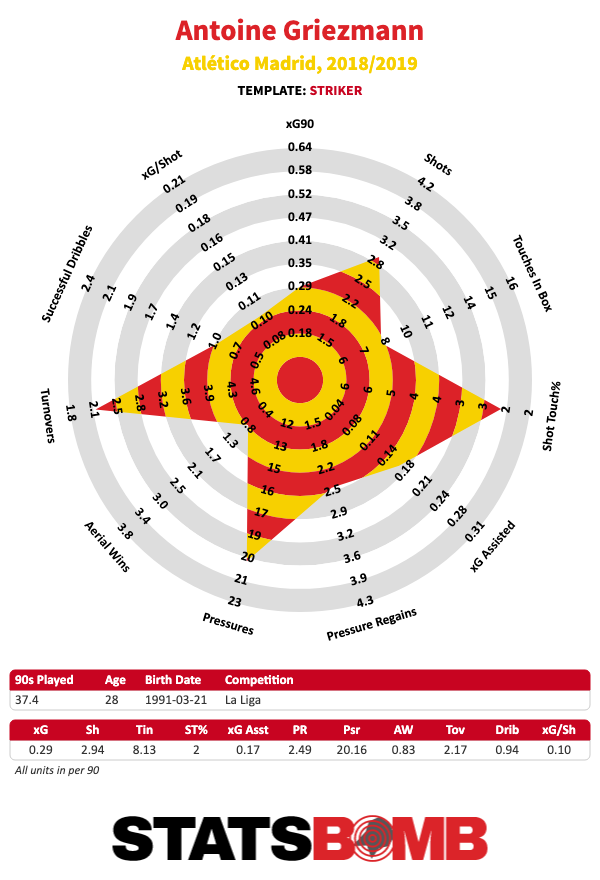
New signings Thomas Lemar and Gelson Martins were supposed to help bridge that gap -- but Lemar has been underwhelming, and Martins has already been sent out on loan. Angel Correa has brilliant moments, and is quick and dangerous, but he’s not been consistent. Thomas Partey has a stinging long-distance shot and has chipped in sporadically, but he’s ghosted during big games. Diego Costa is not the same Diego Costa as before, and Alvaro Morata is, well, it’s unclear if even the supreme motivator Simeone can light a fire under him and unearth his form from two seasons ago. Morata is low on confidence, extremely self-critical, and has made a habit of missing sitters.
That leaves Saul, who’s been dangerous arriving at the top of the box to meet a cut-back. But he’s scored just two goals this season, and no Atletico player other than Griezmann has scored more than two goals total this campaign. The Frenchman leads the team in goals, assists, and key passes, and it’s not close.
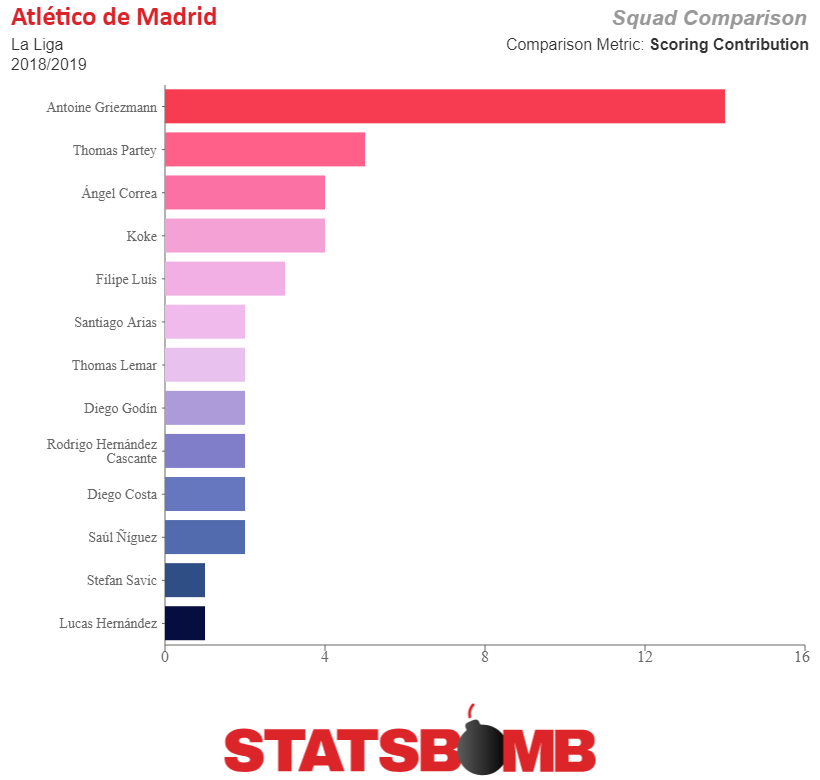
Griezmann needs help, but getting him a wingman is easier said than done given the tough market. Atletico’s budget has increased over the years, but it’s been hard for them to attract stars to play alongside their main man, which has led them to overpay for players like Lemar (Lemar’s signing in a vacuum made sense. He can get the ball up the field quickly, play as a two-way winger, and put in accurate crosses to Diego Costa and Morata. He had one flash of brilliance against Real Madrid, but not enough, and certainly not enough over the course of the season). That Griezmann resigned with the team this summer was a huge victory for them in itself.
None of their offensive problems will get any easier against Juventus in a fascinating Champions League encounter. Juventus are not a high-pressing team, nor do they care to counter-press much (although, head coach Massimiliano Allegri will implement a press sporadically throughout certain games, he just doesn’t use it as the focus of his defensive scheme). They will put emphasis on slowing Atletico’s already sluggish counters. They’ll put bodies behind the ball. Leonardo Bonucci has had his moments switching off when defending crosses, but both he and Giorgio Chiellini have been brilliant. It will be tough for Simeone’s men to crack Juve, and if they do, they’ll have to be air-tight defensively while coming away with a narrow victory with a goal from… somewhere.
Juve may look to man-mark Rodri Hernandez -- a tactic they’ve used in the past to unnerve the opposing team’s defensive midfielder while thwarting the offensive funnel. There are a lot of different tools Allegri can use to make it tough for Atleti to transition into a fluid offense.
Atletico have also had trouble defending pacy full-backs who bulldoze the flank. As Juve hunt for overloads with Joao Cancelo and Alex Sandro, they’ll look to get the ball into two behemoths in Mario Mandzukic and Cristiano Ronaldo. That’s tough to defend, but not impossible, given Simeone’s resources and tactical acumen. Atletico can pack the flanks, as they’re good at doing. They may also look to press and hound Miralen Pjanic to make those cross-field switches less possible -- daring Bonucci or Chiellini to act as a ball-carrier from the backline instead. That’s fascinating about this entire tie is that neither of these teams are prone to exposing themselves defensively.
Whether they get past Juventus or not, Atletico have a ton of questions that need answering. This may not be a dead team yet, but they are an aging one. The heartbeat of the club, Diego Simeone, has signed a new deal. His tactics may have grown stale and unimaginative, but letting him guide the ship he did so well to navigate in the first place was the right move.
But what of the ageing core? Gabi already moved on. This is likely Diego Godin’s last year with the club. Felipe Luis is one of this generation’s most underrated full-backs, but both he and Juanfran are the wrong side of 30. Diego Costa has regressed. All of those important pieces need replacing, and doing so is going to be difficult.
Now it’s on the board and Simeone to get the transfer market right. They already won big by resigning Griezmann, purchasing Rodri from Villarreal, and striking gold with Lucas Hernandez who’s been a revelation for them. Saul will be at the Wanda long-term, and Koke is still young. But other pieces need filling. Simeone has a big job to ensure those obituaries don’t resurface.
Header image courtesy of the Press Association
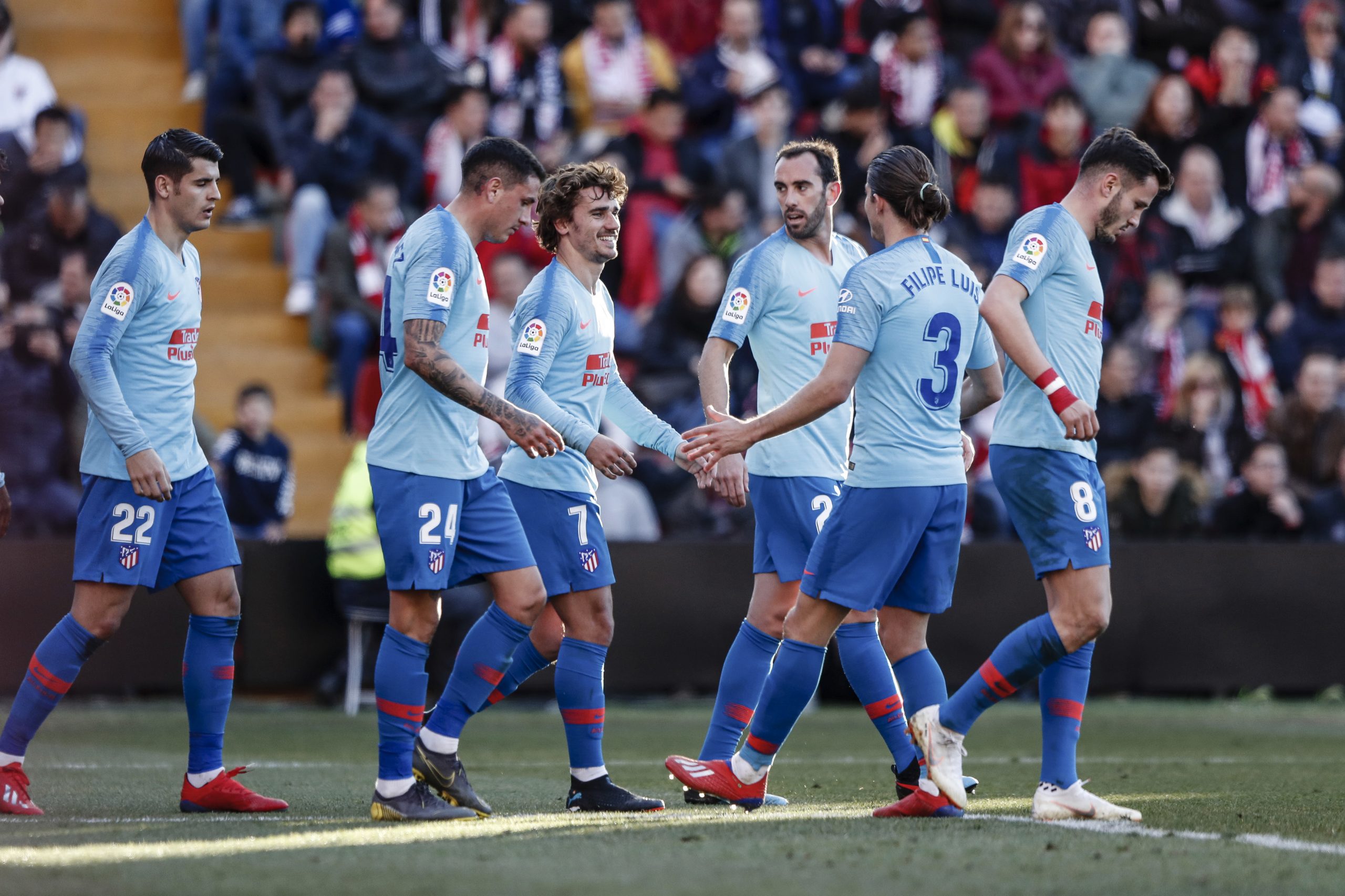
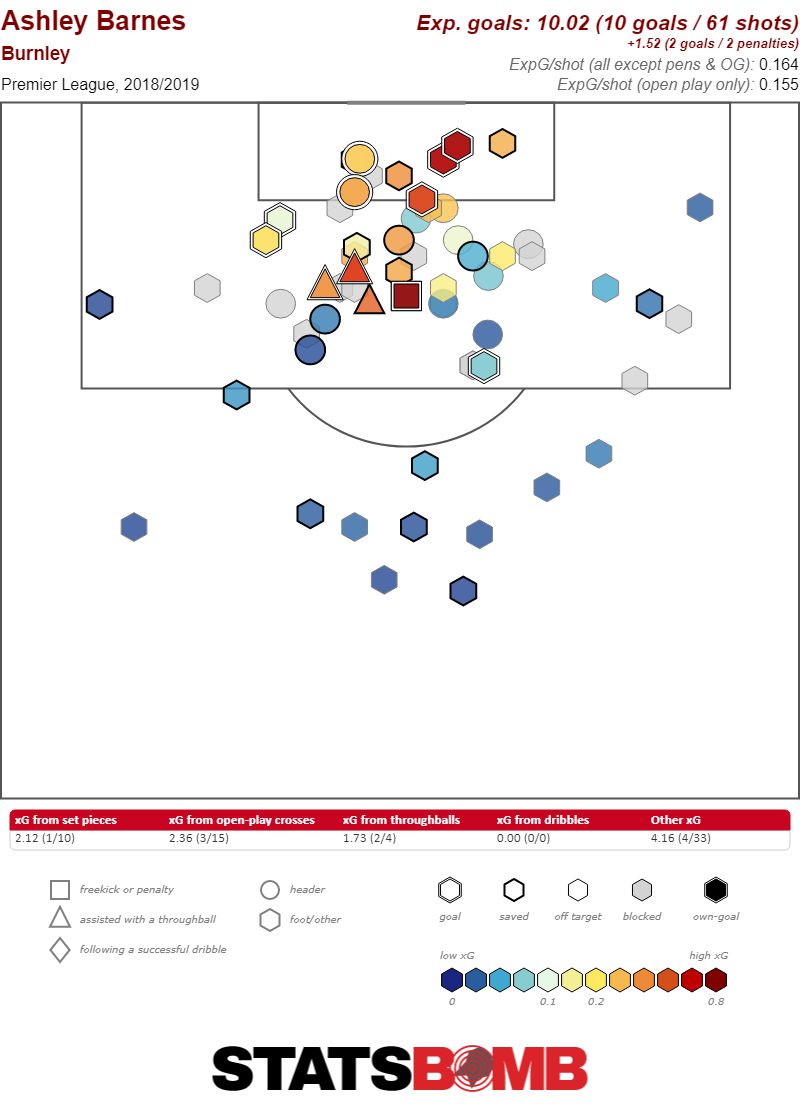
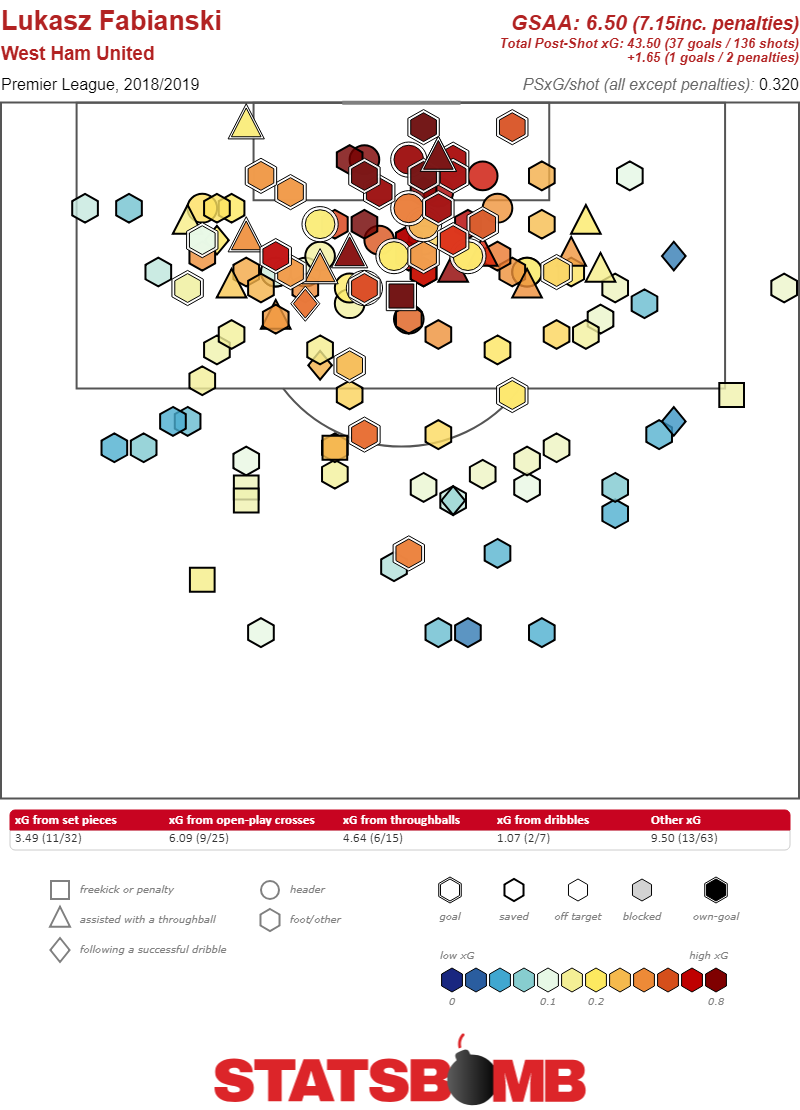 Forward – Ashley Barnes Wait what? Burnley’s Ashley Barnes? Yep. Dude has 0.43 xG per 90 this season. I don’t make the rules. I mean, I did make the rules, like less than 200 words ago, but nevertheless! Ashley Barnes.
Forward – Ashley Barnes Wait what? Burnley’s Ashley Barnes? Yep. Dude has 0.43 xG per 90 this season. I don’t make the rules. I mean, I did make the rules, like less than 200 words ago, but nevertheless! Ashley Barnes. 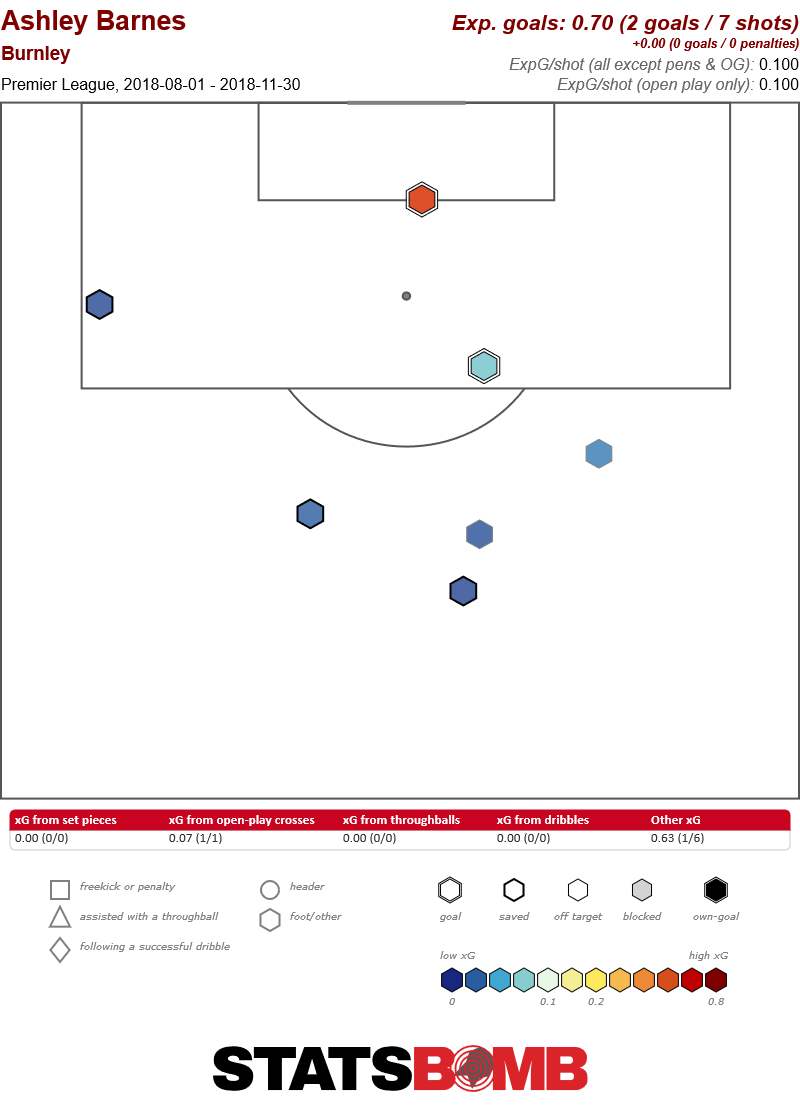 Wingers – Felipe Anderson, Ryan Fraser Ryan Fraser is just an absolute assist machine. His 0.26 expected goals assisted is tops outside the top six and eight overall. He doesn’t do a lot of different stuff, but the thing he does do, is get into lethally good crossing and cutback positions to feed the striker. It’s a skill that is hard to find outside the top six teams.
Wingers – Felipe Anderson, Ryan Fraser Ryan Fraser is just an absolute assist machine. His 0.26 expected goals assisted is tops outside the top six and eight overall. He doesn’t do a lot of different stuff, but the thing he does do, is get into lethally good crossing and cutback positions to feed the striker. It’s a skill that is hard to find outside the top six teams. 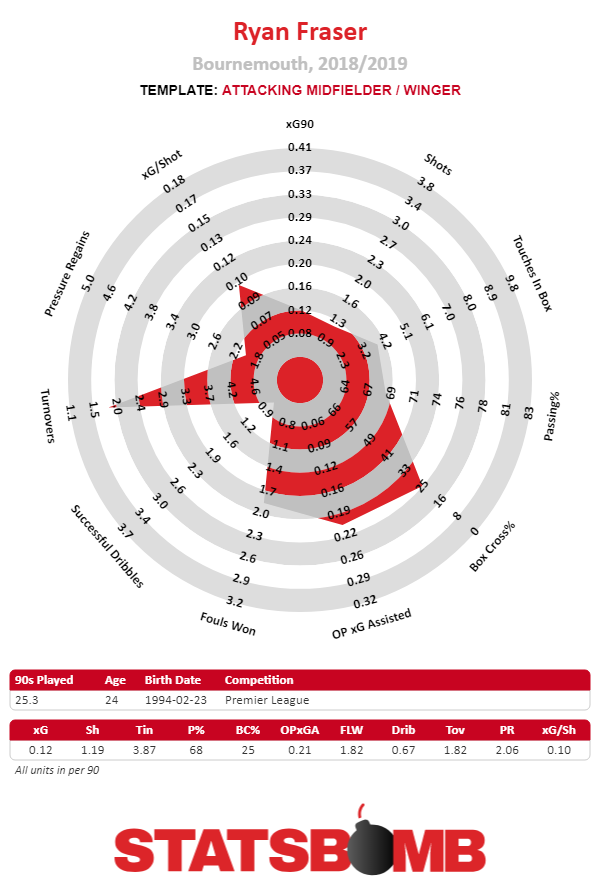 It’s cheating a little bit to put Anderson on the right and Fraser on the left when Anderson has played on the left all season, but I’m doing it anyway. Anderson plays more open play passes into the penalty area than anybody with 2.36 (including the top six only David Silva, Xherdan Shaqiri, Eden Hazard and Kieran Trippier play more). Also Anderson is going to do a little bit (or a lot) of basically everything else on the pitch to make this team good. On a team that’s built to be scrappy (and, like, we’re starting Ashley Barnes up top here, scrappy it is) Anderson’s defensive contributions will be essential. He averages over three combined tackles and interceptions per game. Midfield – Idrissa Gueye, Pascal Groß, Pierre-Emile Højbjerg This three man midfield can do it all. Gueye is the
It’s cheating a little bit to put Anderson on the right and Fraser on the left when Anderson has played on the left all season, but I’m doing it anyway. Anderson plays more open play passes into the penalty area than anybody with 2.36 (including the top six only David Silva, Xherdan Shaqiri, Eden Hazard and Kieran Trippier play more). Also Anderson is going to do a little bit (or a lot) of basically everything else on the pitch to make this team good. On a team that’s built to be scrappy (and, like, we’re starting Ashley Barnes up top here, scrappy it is) Anderson’s defensive contributions will be essential. He averages over three combined tackles and interceptions per game. Midfield – Idrissa Gueye, Pascal Groß, Pierre-Emile Højbjerg This three man midfield can do it all. Gueye is the 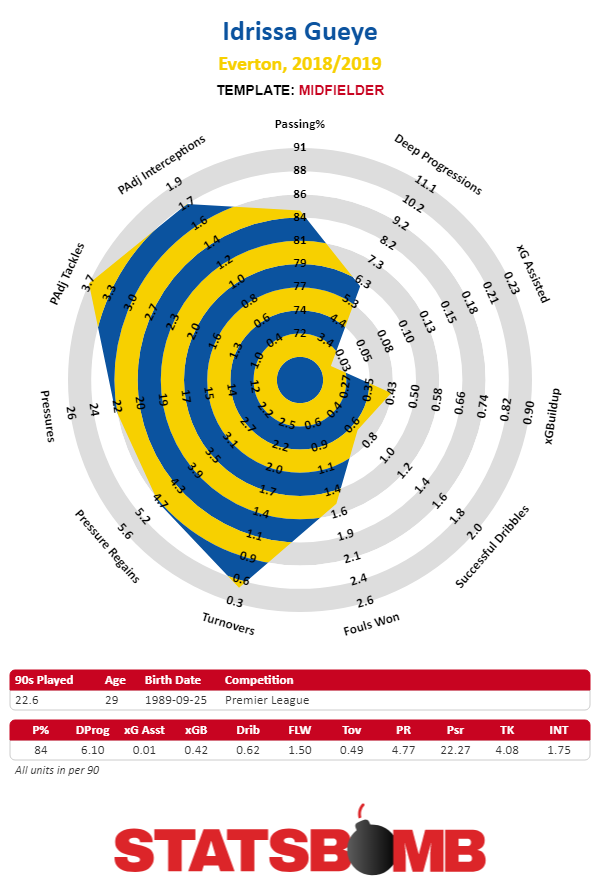 Next to him are two players who are both very effective at applying defensive pressure in midfield and at moving the ball forward. Groß is the more active presser. He’s second in the league with 33.86 pressures per 90. A great number, but one which technically doesn’t qualify him for this team. We get to smuggle him onto the team for his crossing though (which Ashley Barnes will surely be thankful for). He completes 1.77 crosses per 90, the second most in the Premier League (only Kieran Trippier is ahead of him) and he completes them at a 54% clip which is truly impressive. Groß and Juan Mata at Manchester United are the only players completing over 0.75 crosses per 90 who maintain a completion rate of over 50%. But while the crossing is definitely a nice bonus, it’s the pressing that we’re really here for.
Next to him are two players who are both very effective at applying defensive pressure in midfield and at moving the ball forward. Groß is the more active presser. He’s second in the league with 33.86 pressures per 90. A great number, but one which technically doesn’t qualify him for this team. We get to smuggle him onto the team for his crossing though (which Ashley Barnes will surely be thankful for). He completes 1.77 crosses per 90, the second most in the Premier League (only Kieran Trippier is ahead of him) and he completes them at a 54% clip which is truly impressive. Groß and Juan Mata at Manchester United are the only players completing over 0.75 crosses per 90 who maintain a completion rate of over 50%. But while the crossing is definitely a nice bonus, it’s the pressing that we’re really here for. 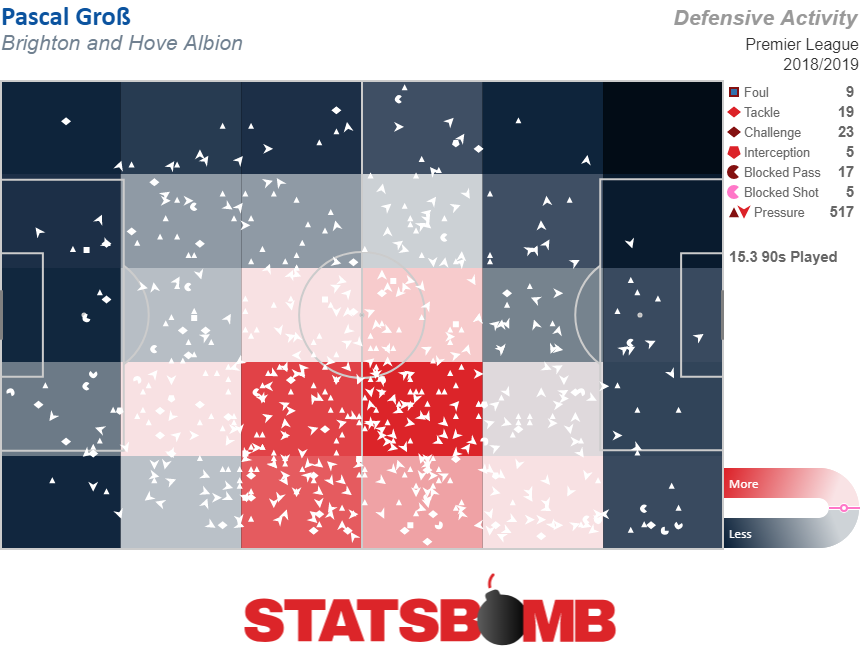 The missing part of the puzzle is how does this team move the ball up the field. Right now it seems like Felipe Anderson is going to be all by himself picking the ball up from defense and trying to wriggle his way up the wing. But, not to fear, that’s where Højbjerg comes in. The vast majority of players who rack up a lot of deep progressions play for the top six teams. Højbjerg is the exception. He leads the non-six group and, along with Huddersfield’s Aaron Mooy is one of only two players outside the big six in the top 20 in the league at progressing the ball up the field from deep. His 8.27 deep progressions per 90, with a healthy assist from Groß who averages 6.42 should provide the team enough creativity on the ball to keep things ticking. Center backs – Michael Keane, Steve Cook Things break down really quickly when trying to do fun but ultimately pointless data experiments with defenders. So here, have Michael Keane and Steve Cook the top two players outside the top six in the league in possession adjusted clearances. They have 5.99 and 5.92 clearances apiece. Does that make them good? Probably not. Does that qualify them for this silly little team? You bet. Fullbacks – Lucas Digne, Florent Hadergjonaj As with center backs, fullbacks are simply impossible to actually evaluate statistically. So who knows if this will work at all. Lucas Digne has seemed mostly fine with Everton this season and he’s a big part of their attacking approach. He’s right behind Groß in completed crosses per 90 with 1.55 completed crosses per 90, so…yay? And speaking of crossing! A whole 73% of Florent Hadergjonaj’s passes in the final third are crosses, that’s the highest in the league, so please welcome your new right back.
The missing part of the puzzle is how does this team move the ball up the field. Right now it seems like Felipe Anderson is going to be all by himself picking the ball up from defense and trying to wriggle his way up the wing. But, not to fear, that’s where Højbjerg comes in. The vast majority of players who rack up a lot of deep progressions play for the top six teams. Højbjerg is the exception. He leads the non-six group and, along with Huddersfield’s Aaron Mooy is one of only two players outside the big six in the top 20 in the league at progressing the ball up the field from deep. His 8.27 deep progressions per 90, with a healthy assist from Groß who averages 6.42 should provide the team enough creativity on the ball to keep things ticking. Center backs – Michael Keane, Steve Cook Things break down really quickly when trying to do fun but ultimately pointless data experiments with defenders. So here, have Michael Keane and Steve Cook the top two players outside the top six in the league in possession adjusted clearances. They have 5.99 and 5.92 clearances apiece. Does that make them good? Probably not. Does that qualify them for this silly little team? You bet. Fullbacks – Lucas Digne, Florent Hadergjonaj As with center backs, fullbacks are simply impossible to actually evaluate statistically. So who knows if this will work at all. Lucas Digne has seemed mostly fine with Everton this season and he’s a big part of their attacking approach. He’s right behind Groß in completed crosses per 90 with 1.55 completed crosses per 90, so…yay? And speaking of crossing! A whole 73% of Florent Hadergjonaj’s passes in the final third are crosses, that’s the highest in the league, so please welcome your new right back. 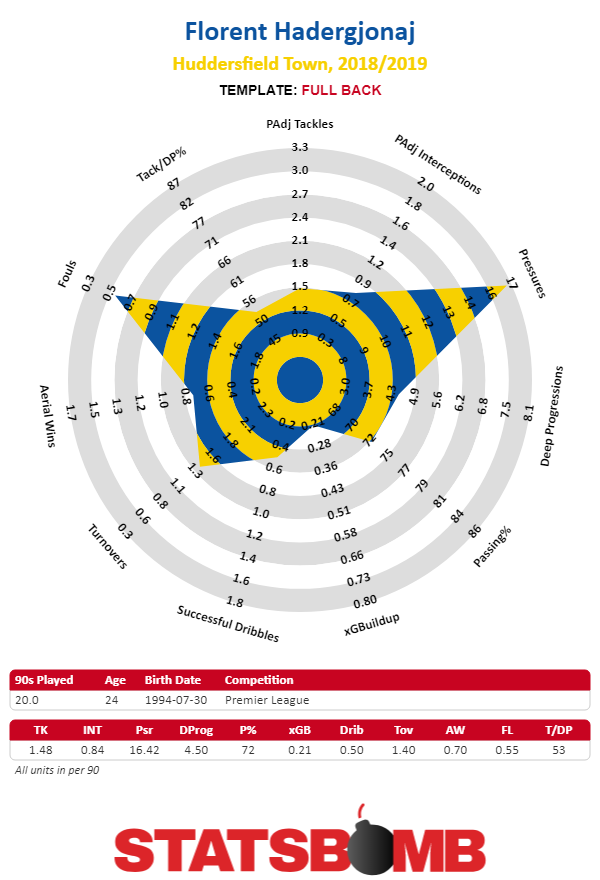 Put it all together and what we’ve got is a starting 11 which emphasizes denying the opposition control of the midfield, moving the ball upfield quickly and then crossing smartly. Also, there are a couple of defenders. It’s all so crazy it just might work.
Put it all together and what we’ve got is a starting 11 which emphasizes denying the opposition control of the midfield, moving the ball upfield quickly and then crossing smartly. Also, there are a couple of defenders. It’s all so crazy it just might work.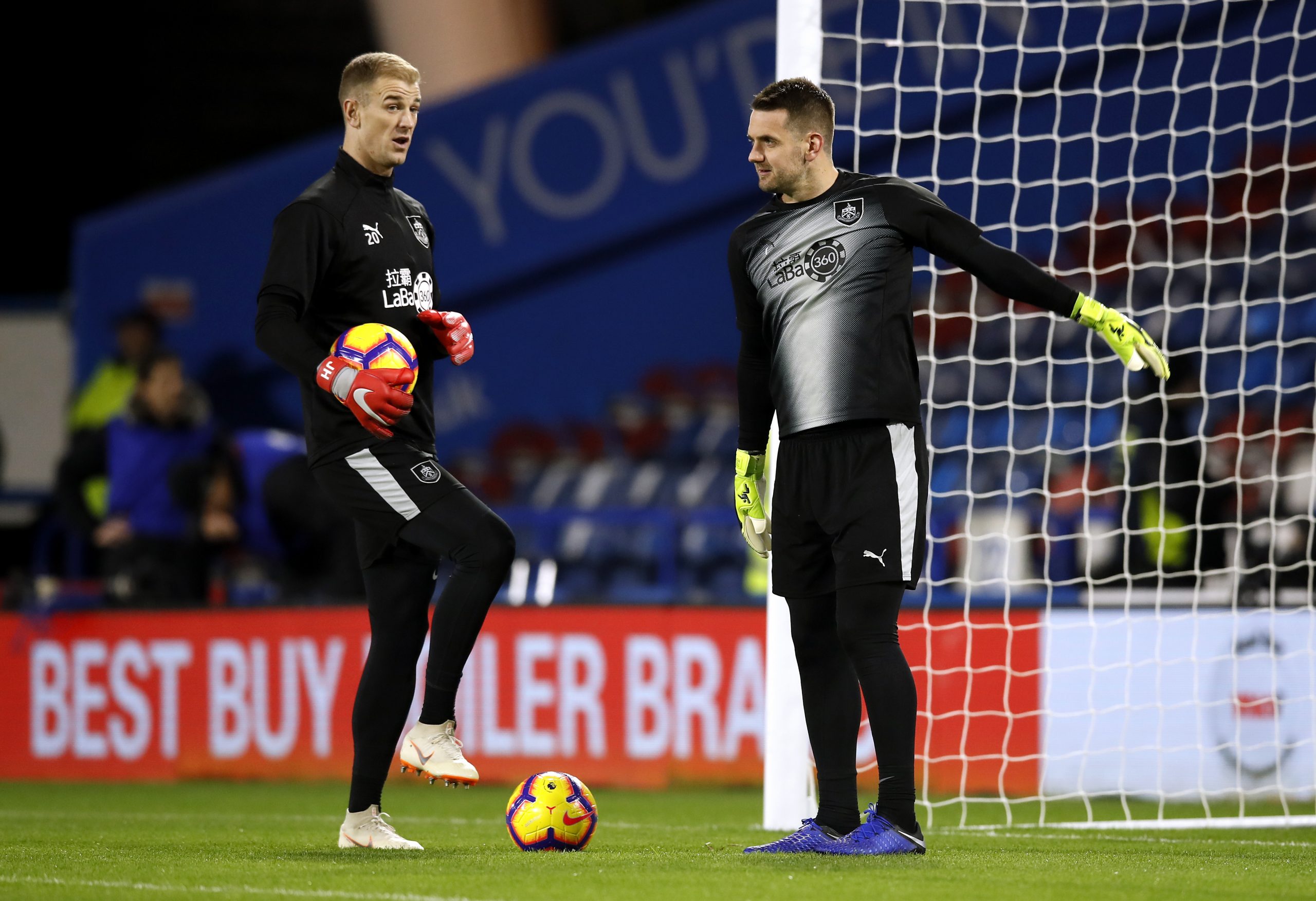
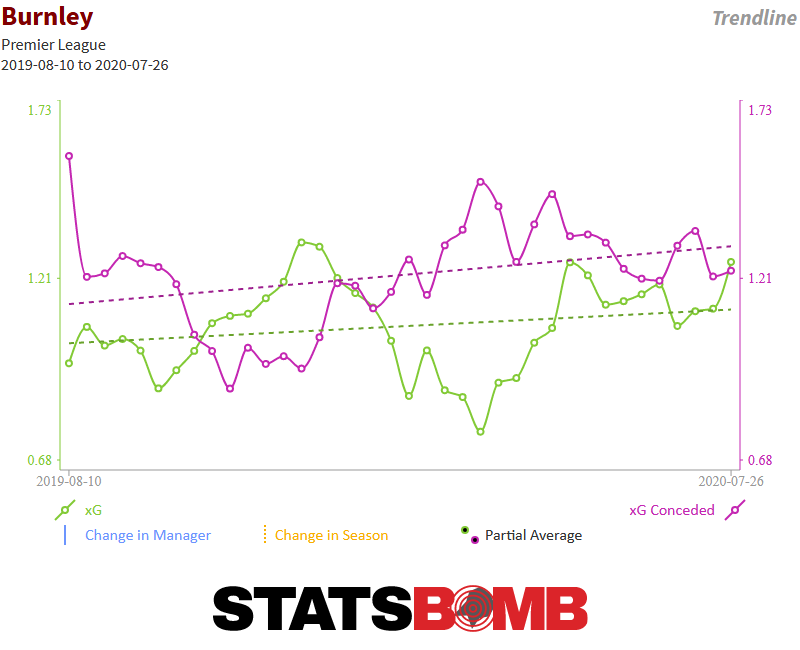 The vaunted Burnley defense had simply utterly collapsed over the first half of the year. The most plausible story of Burnley’s success (at least the most plausible won’t that wasn’t based on them being a cosmic joke instigated by the soccer gods on evil number wizards everywhere) was that Dyche’s teams did something in defense that tricked expected goals models. Somehow they turned modest defensive success into nearly unparalleled defensive solidity. Of course none of that really matters if instead of putting together defensive numbers indicative of modest success, the team is out there dumpster fire-ing every week. And that’s more or less what going on for the first half of this season. But then, something happened. Burnley changed keepers. Seven games ago Tom Heaton stepped back between the posts, and Burnley changed. The relationship between a keeper and his defense is difficult to untangle. There are things like shotstopping which are almost entirely within a keeper’s purview which we can measure, but other things get more complicated. The kinds of shots the opposition is taking for example are often a complicated mix of decisions made by attackers, defenders and defenses. So, it’s important to be cautious about making bold claims about causality. But, what’s absolutely clear is that Burnley’s defense when they play in front of Heaton looks totally different than when they play in front of Hart. Let’s start with the easiest stuff though. Heaton has been much better at stopping the shots he’s faced this season than Hart was. In 19 games this season, Hart gave up roughly four more goals than expected. Not great.
The vaunted Burnley defense had simply utterly collapsed over the first half of the year. The most plausible story of Burnley’s success (at least the most plausible won’t that wasn’t based on them being a cosmic joke instigated by the soccer gods on evil number wizards everywhere) was that Dyche’s teams did something in defense that tricked expected goals models. Somehow they turned modest defensive success into nearly unparalleled defensive solidity. Of course none of that really matters if instead of putting together defensive numbers indicative of modest success, the team is out there dumpster fire-ing every week. And that’s more or less what going on for the first half of this season. But then, something happened. Burnley changed keepers. Seven games ago Tom Heaton stepped back between the posts, and Burnley changed. The relationship between a keeper and his defense is difficult to untangle. There are things like shotstopping which are almost entirely within a keeper’s purview which we can measure, but other things get more complicated. The kinds of shots the opposition is taking for example are often a complicated mix of decisions made by attackers, defenders and defenses. So, it’s important to be cautious about making bold claims about causality. But, what’s absolutely clear is that Burnley’s defense when they play in front of Heaton looks totally different than when they play in front of Hart. Let’s start with the easiest stuff though. Heaton has been much better at stopping the shots he’s faced this season than Hart was. In 19 games this season, Hart gave up roughly four more goals than expected. Not great. 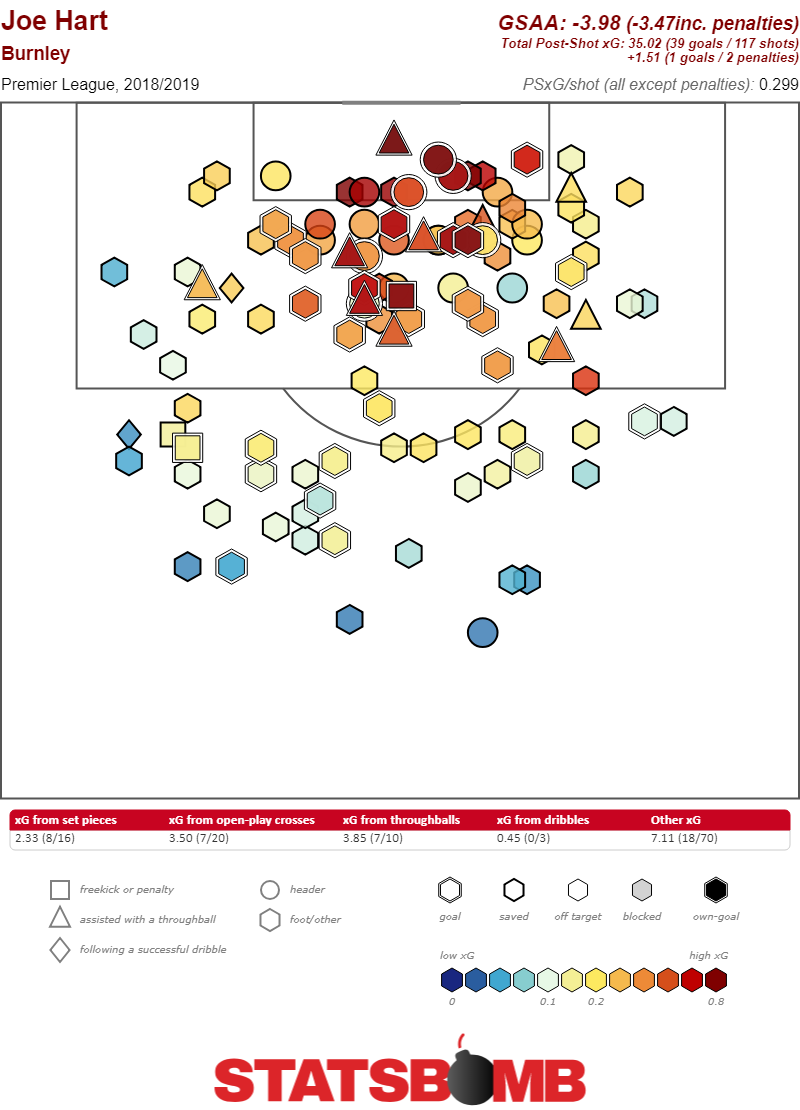 The difference between his save percentage of 66.7% and his expected save percentage of 70.1% is negative 3.4%. Of the 24 keepers who have played more than 600 minutes this year only five have a larger negative difference. Heaton, on the other hand, has been fantastic.
The difference between his save percentage of 66.7% and his expected save percentage of 70.1% is negative 3.4%. Of the 24 keepers who have played more than 600 minutes this year only five have a larger negative difference. Heaton, on the other hand, has been fantastic. 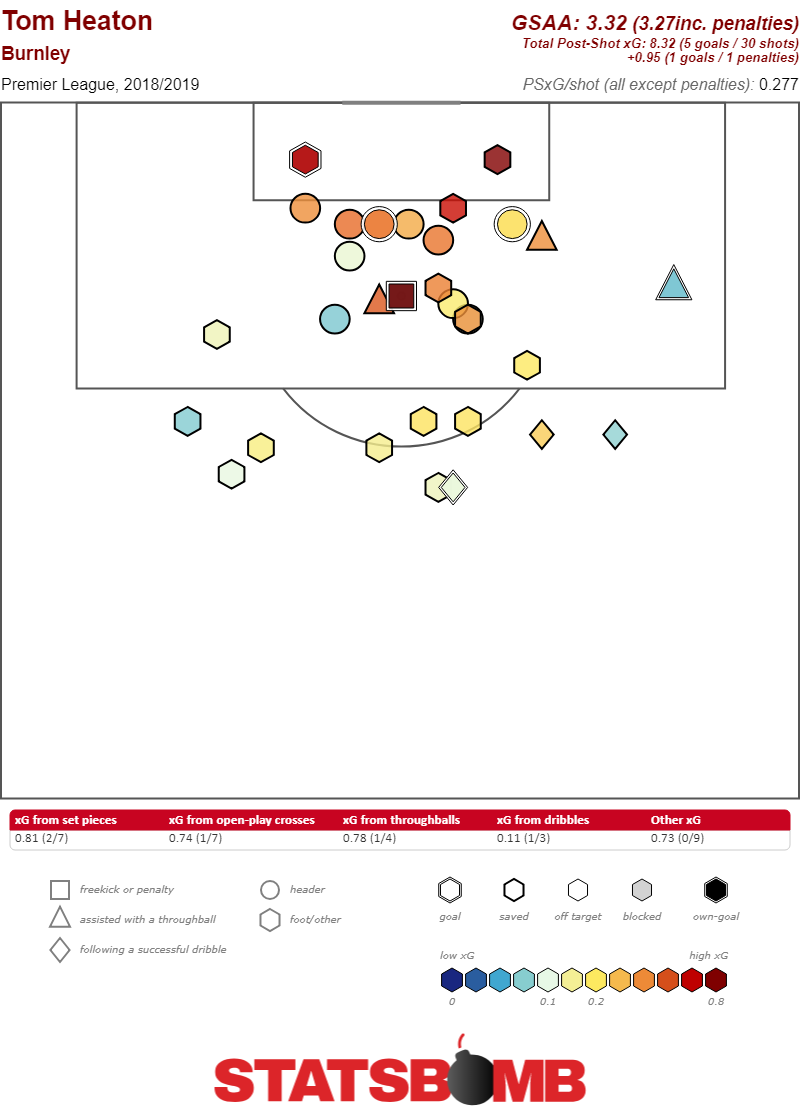 He’s already saved 3.32 more goals than an average keeper would. His save percentage of 83.3% is not only the highest in the league, it’s 11.1% higher than his expected save percentage. That gap is also the highest in the league. He’s been absolutely phenomenal. So, one thing that’s going on is that Heaton is just saving a lot more goals than Hart was and that makes a big difference. But, there’s more. Because Burnley’s defense is absolutely also playing better. With Hart in goal, Burnley gave up a whopping 19.58 shots per game and an xG per shot of 0.10. With Heaton those numbers have both improved. The side is currently conceding 13.57 shots per game at 0.08 xG per shot. They’ve both improved in terms of the volume and the quality they’re giving up. Some of that probably has something to do with the level of competition Burnley are facing. Their recent hot streak has come against West Ham, Huddersfield, Fulham, Watford, Manchester United, Southampton, and Brighton. There’s only one potent attacking team in that mix. But, even against that backdrop the defensive improvement is stark, and it’s worth investigating how the two keepers might be influencing it. No Burnley keeper is ever going to come across as aggressive. The conservative style the team plays means that a keeper’s job is to mostly stay at home on his line while defenders deal with things in front of him. Accordingly, Heaton has only attempted to claim 12 balls in the seven matches he’s played, when the StatsBomb model expects average keeper to come for just over 21. However, that conservatism is only evident in balls that are relatively unlikely for any keeper to claim. He’s claimed only five balls that the model suggests have a 20% chance or less of a keeper collecting, while an average keeper might collect 14. On the mode dangerous balls, the ones that keepers collect 30% of the time or more, Heaton is much closer to expectations. He’s attempted seven claims on 16 balls, right in line with what the model predicts. He’s succeeded on six of those seven attempts.
He’s already saved 3.32 more goals than an average keeper would. His save percentage of 83.3% is not only the highest in the league, it’s 11.1% higher than his expected save percentage. That gap is also the highest in the league. He’s been absolutely phenomenal. So, one thing that’s going on is that Heaton is just saving a lot more goals than Hart was and that makes a big difference. But, there’s more. Because Burnley’s defense is absolutely also playing better. With Hart in goal, Burnley gave up a whopping 19.58 shots per game and an xG per shot of 0.10. With Heaton those numbers have both improved. The side is currently conceding 13.57 shots per game at 0.08 xG per shot. They’ve both improved in terms of the volume and the quality they’re giving up. Some of that probably has something to do with the level of competition Burnley are facing. Their recent hot streak has come against West Ham, Huddersfield, Fulham, Watford, Manchester United, Southampton, and Brighton. There’s only one potent attacking team in that mix. But, even against that backdrop the defensive improvement is stark, and it’s worth investigating how the two keepers might be influencing it. No Burnley keeper is ever going to come across as aggressive. The conservative style the team plays means that a keeper’s job is to mostly stay at home on his line while defenders deal with things in front of him. Accordingly, Heaton has only attempted to claim 12 balls in the seven matches he’s played, when the StatsBomb model expects average keeper to come for just over 21. However, that conservatism is only evident in balls that are relatively unlikely for any keeper to claim. He’s claimed only five balls that the model suggests have a 20% chance or less of a keeper collecting, while an average keeper might collect 14. On the mode dangerous balls, the ones that keepers collect 30% of the time or more, Heaton is much closer to expectations. He’s attempted seven claims on 16 balls, right in line with what the model predicts. He’s succeeded on six of those seven attempts. 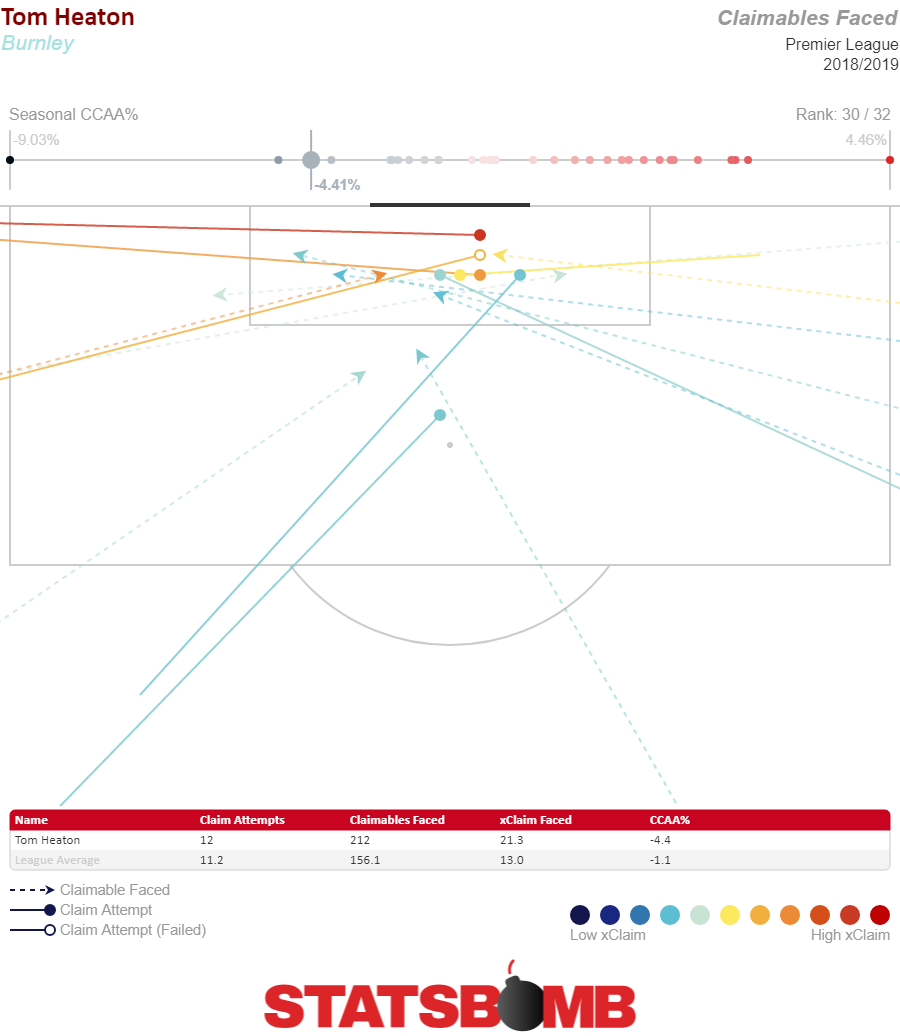 Hart is similarly conservative overall, attempting to claim 21 balls when the model expects he’d have gone for 33, but the distribution of his conservatism is different. In his 19 games he’s faced 20 total balls that the model expects a keeper to claim at least 30% of the time. He’s come for five of them (and was successful four out of five times), when the model predicts a keeper would come on average 9.5% of the time. Over the course of the season Hart has shown to be unable to prevent teams from putting high value crosses right on his doorstep.
Hart is similarly conservative overall, attempting to claim 21 balls when the model expects he’d have gone for 33, but the distribution of his conservatism is different. In his 19 games he’s faced 20 total balls that the model expects a keeper to claim at least 30% of the time. He’s come for five of them (and was successful four out of five times), when the model predicts a keeper would come on average 9.5% of the time. Over the course of the season Hart has shown to be unable to prevent teams from putting high value crosses right on his doorstep. 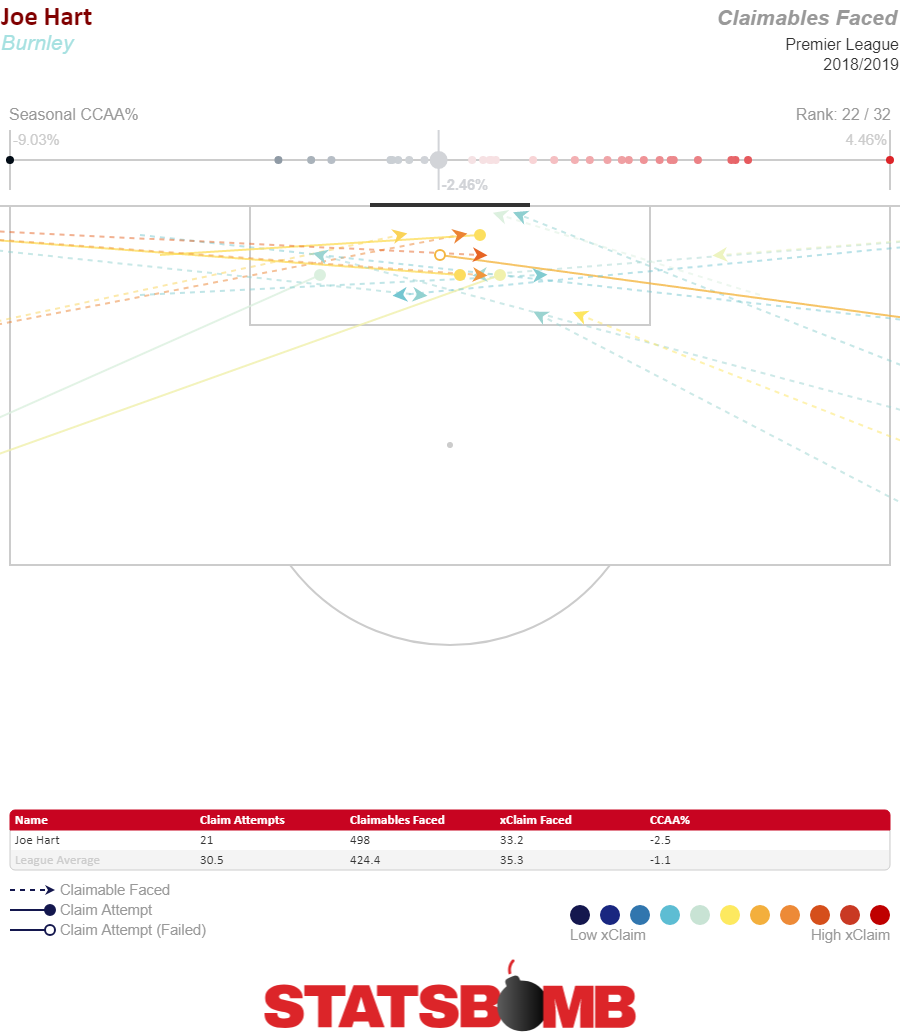 Now, let’s zoom out to the team level again, equipped with the knowledge that Hart has a tendency not to come for balls played into areas where many keepers attempt to collect them. Here are all the shots Burnley gave up within 12 yards of the goal with Hart as keeper.
Now, let’s zoom out to the team level again, equipped with the knowledge that Hart has a tendency not to come for balls played into areas where many keepers attempt to collect them. Here are all the shots Burnley gave up within 12 yards of the goal with Hart as keeper. 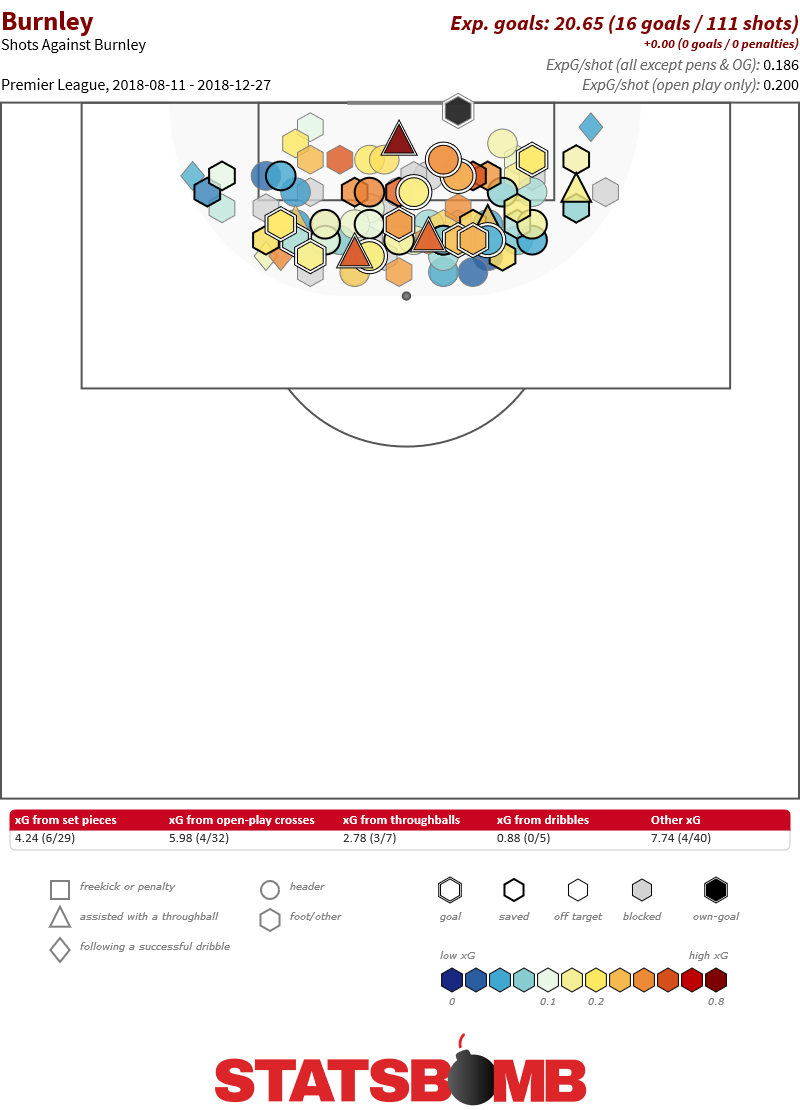 That works out to 5.84 shots per match at a 0.19 xG per shot. Now, let’s look at Heaton.
That works out to 5.84 shots per match at a 0.19 xG per shot. Now, let’s look at Heaton. 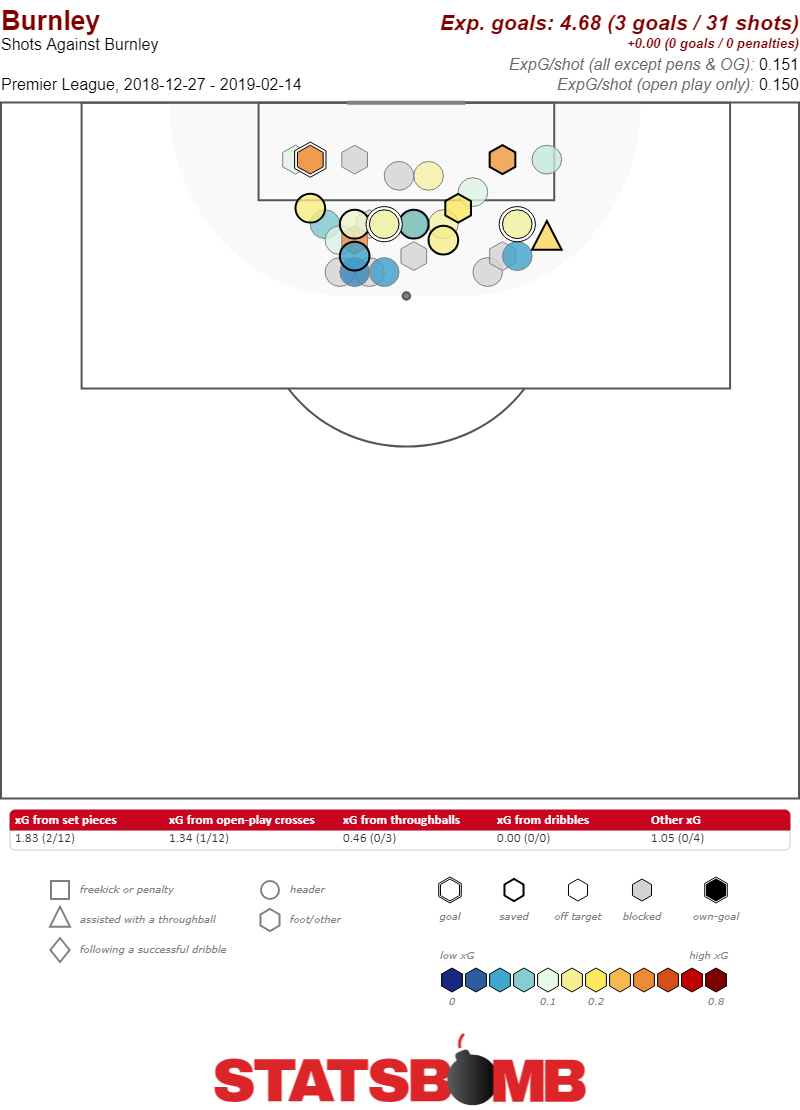 That works out to 4.42 shots per match and an xG per shot of 0.15. That’s a pretty huge difference, like half an expected goal per match difference. Even if we allow that the difference is probably fairly exaggerated by the level of competition it seems quite clear that when Heaton came back into the side it all of a sudden became harder for Burnley’s opponents to generate shots closer to goal. All this keeper data is new, and because of that it’s always worth remembering that using it is a bit of a high wire act. It’s possible that all this Heaton performance is just dumb luck and he’s come plummeting back to earth. It’s possible that we should look at Hart’s failure to come for crosses as not necessarily indicative of his abilities. It’s possible that Burnley will go back to conceding shots close to goal against tomorrow. None of this is proof. What it is is circumstantial evidence. And boy is there a lot of it. Burnley’s performances suddenly turned around when they removed Hart from goal and replaced him with Heaton. Their defense suddenly stopped conceding as many chances close to their keeper. Their keepers have dramatically different records both when it comes to stopping shots and when it comes to claiming balls in their area. Put it all together and it makes a powerful case that the reason Burnley’s season has turned around is that Joe Hart is bad and Tom Heaton is good. Keepers, it turns out, might just be important.
That works out to 4.42 shots per match and an xG per shot of 0.15. That’s a pretty huge difference, like half an expected goal per match difference. Even if we allow that the difference is probably fairly exaggerated by the level of competition it seems quite clear that when Heaton came back into the side it all of a sudden became harder for Burnley’s opponents to generate shots closer to goal. All this keeper data is new, and because of that it’s always worth remembering that using it is a bit of a high wire act. It’s possible that all this Heaton performance is just dumb luck and he’s come plummeting back to earth. It’s possible that we should look at Hart’s failure to come for crosses as not necessarily indicative of his abilities. It’s possible that Burnley will go back to conceding shots close to goal against tomorrow. None of this is proof. What it is is circumstantial evidence. And boy is there a lot of it. Burnley’s performances suddenly turned around when they removed Hart from goal and replaced him with Heaton. Their defense suddenly stopped conceding as many chances close to their keeper. Their keepers have dramatically different records both when it comes to stopping shots and when it comes to claiming balls in their area. Put it all together and it makes a powerful case that the reason Burnley’s season has turned around is that Joe Hart is bad and Tom Heaton is good. Keepers, it turns out, might just be important.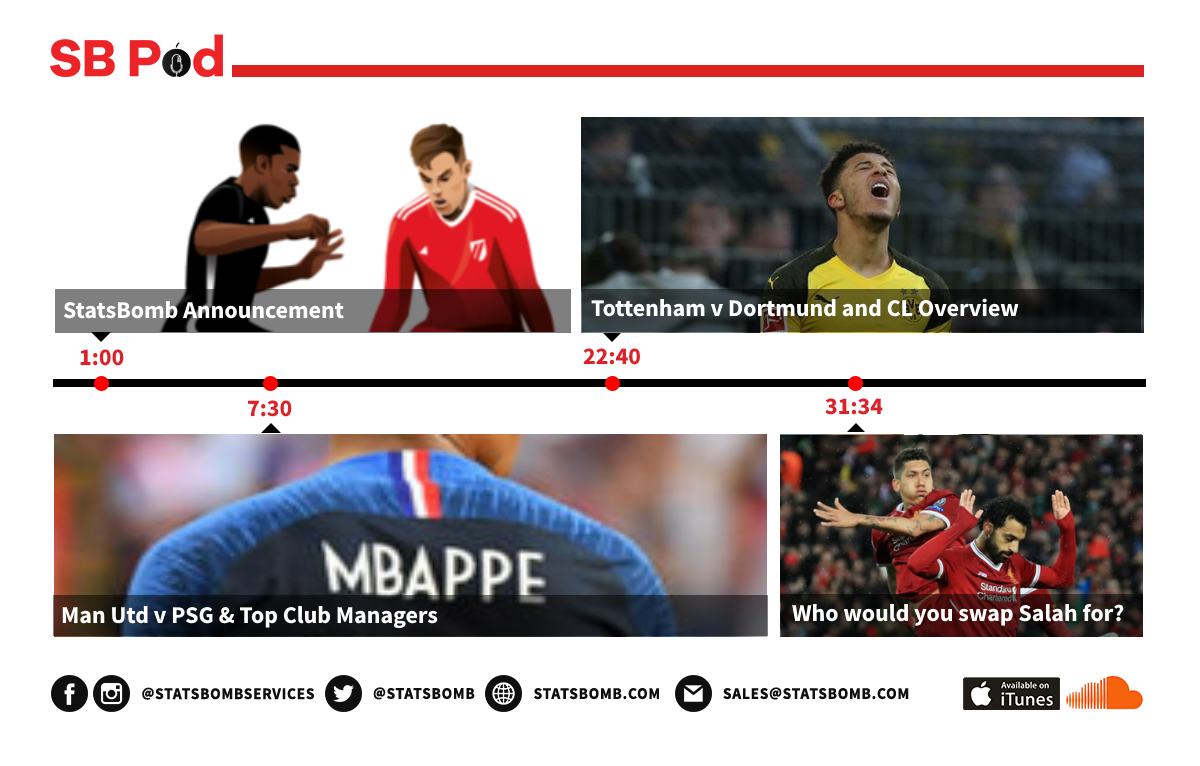
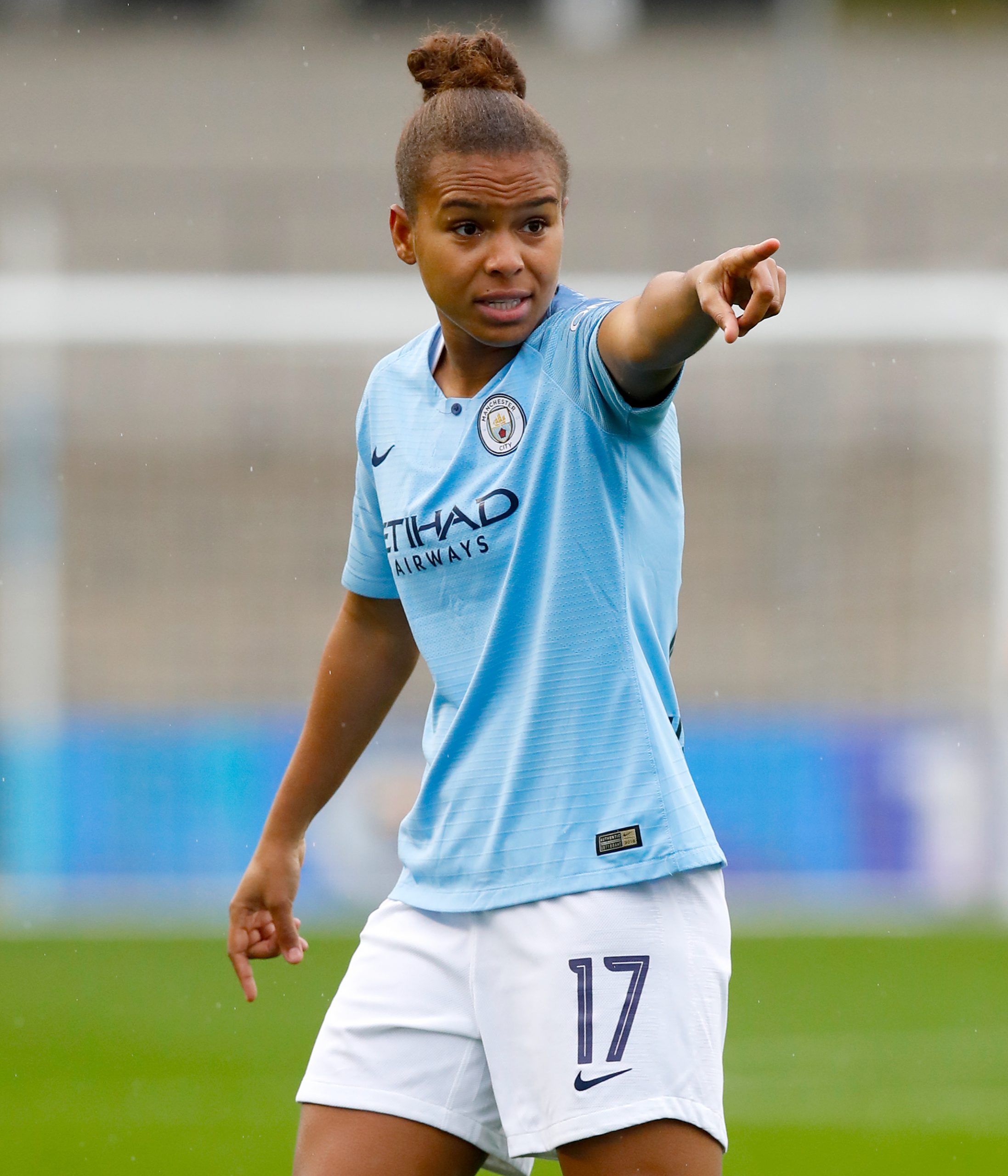
 One of the main reasons why City might pip Arsenal to top spot is the form of Nikita Parris. While most media attention has been focused on the goal scoring prowess of Arsenal’s Vivianne Miedema (rightly so as she has smashed many records this season), one should not neglect the contribution that Nikita Parris has made to last season’s runners up. Parris is Manchester City’s top scorer in the league with 14 goals (11 from open play and 3 from the penalty spot) with her xG numbers from open play being quite similar. Only Miedema at Arsenal has scored more goals than her in the league with 16. When looking at her shot map, it’s clear that she shoots consistently in high value areas. She takes high quality shots, with a lot of attempts inside of the 6-yard box (with both head and feet). She's only taken two shots from outside of the penalty area.
One of the main reasons why City might pip Arsenal to top spot is the form of Nikita Parris. While most media attention has been focused on the goal scoring prowess of Arsenal’s Vivianne Miedema (rightly so as she has smashed many records this season), one should not neglect the contribution that Nikita Parris has made to last season’s runners up. Parris is Manchester City’s top scorer in the league with 14 goals (11 from open play and 3 from the penalty spot) with her xG numbers from open play being quite similar. Only Miedema at Arsenal has scored more goals than her in the league with 16. When looking at her shot map, it’s clear that she shoots consistently in high value areas. She takes high quality shots, with a lot of attempts inside of the 6-yard box (with both head and feet). She's only taken two shots from outside of the penalty area. 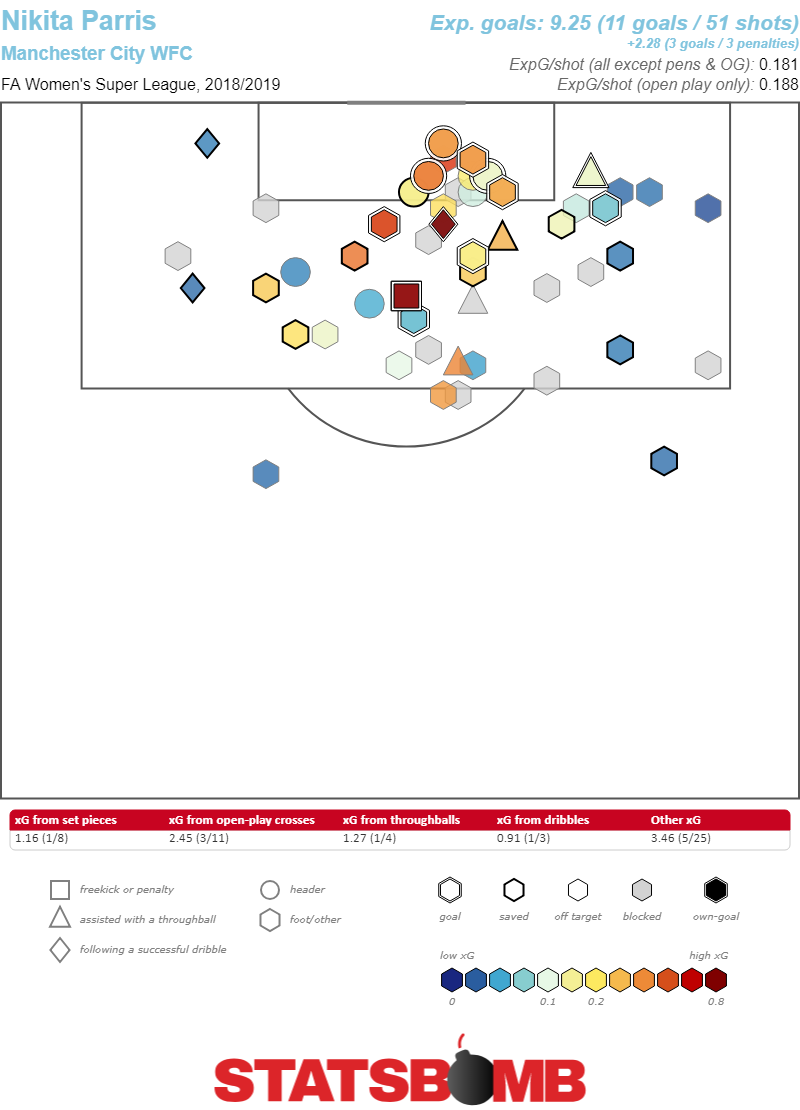 That is almost the opposite of City’s second top scorer, Georgia Stanway. Her expected goals numbers are half of her actual goal numbers, due to many shots from outside of the penalty area and non-central positions inside of the 18 yard-box. Stanway's goals might be flashier, but it's Parris's that are more likely to continue.
That is almost the opposite of City’s second top scorer, Georgia Stanway. Her expected goals numbers are half of her actual goal numbers, due to many shots from outside of the penalty area and non-central positions inside of the 18 yard-box. Stanway's goals might be flashier, but it's Parris's that are more likely to continue. 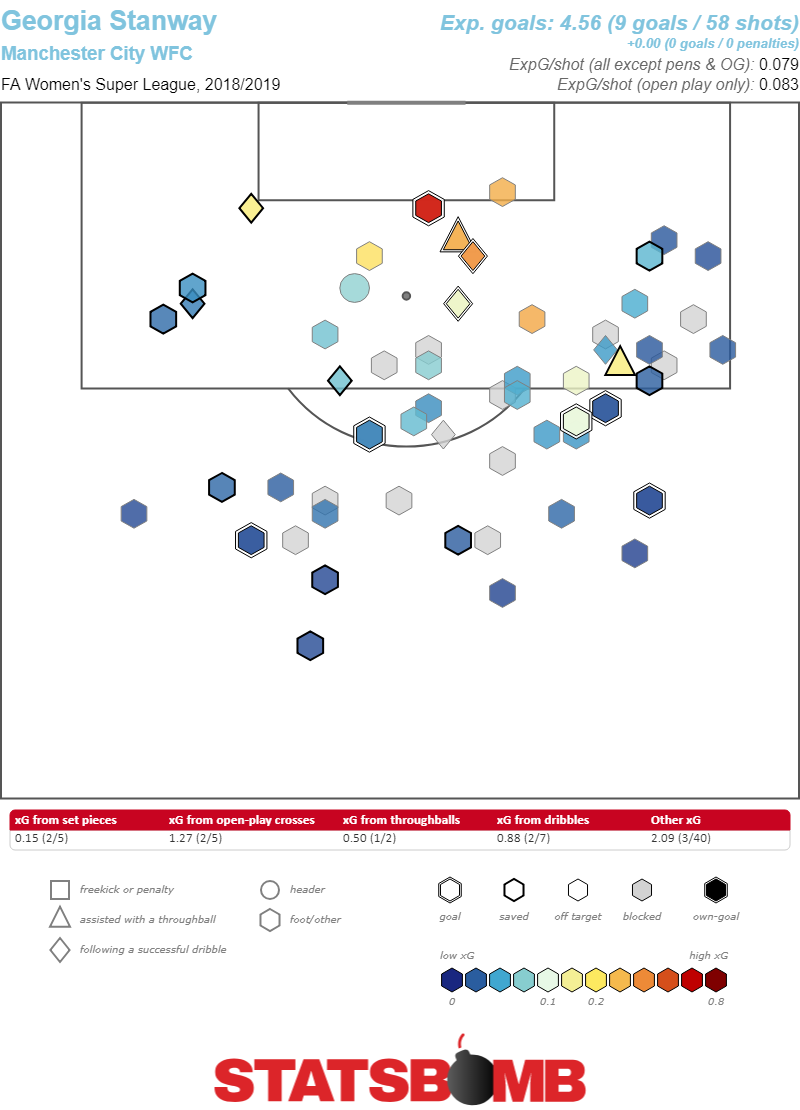 From looking at Parris’ radar below, what is impressive is that beyond offensive output, she has excellent defensive numbers, constantly pressuring the ball and winning it back.
From looking at Parris’ radar below, what is impressive is that beyond offensive output, she has excellent defensive numbers, constantly pressuring the ball and winning it back. 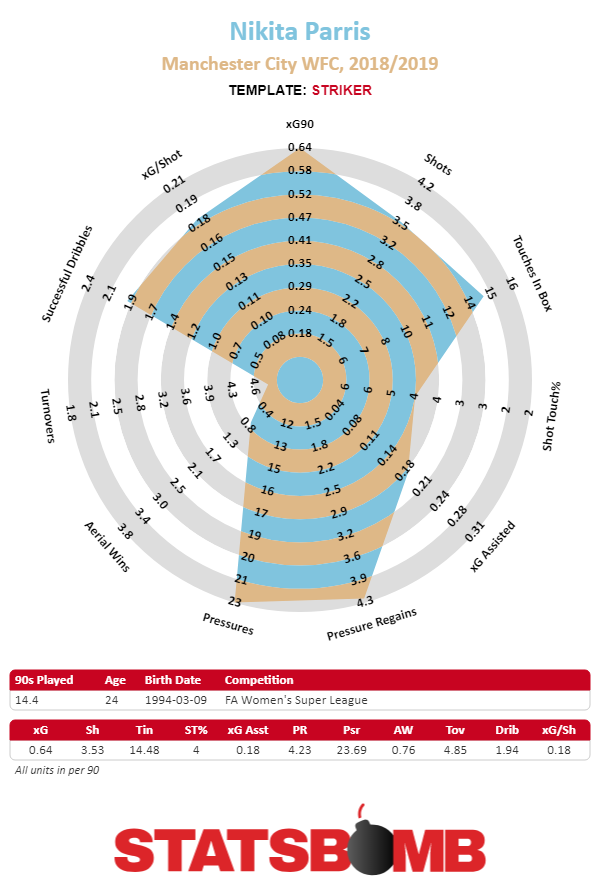 It’s easy to see why Nick Cushing has played her more centrally this season. With Manchester City looking to put opponents under pressure as high up the pitch as possible, Parris’ pace, work rate and pressing qualities are vital in order to box in opponents and start attacks close to the opponent’s penalty area. Parris's ability to lead a press has been key to Manchester City's counterpressing attacking style this season with her defensive contributions keying quick attacks. Parris haunts opponents just outside their own penalty area.
It’s easy to see why Nick Cushing has played her more centrally this season. With Manchester City looking to put opponents under pressure as high up the pitch as possible, Parris’ pace, work rate and pressing qualities are vital in order to box in opponents and start attacks close to the opponent’s penalty area. Parris's ability to lead a press has been key to Manchester City's counterpressing attacking style this season with her defensive contributions keying quick attacks. Parris haunts opponents just outside their own penalty area. 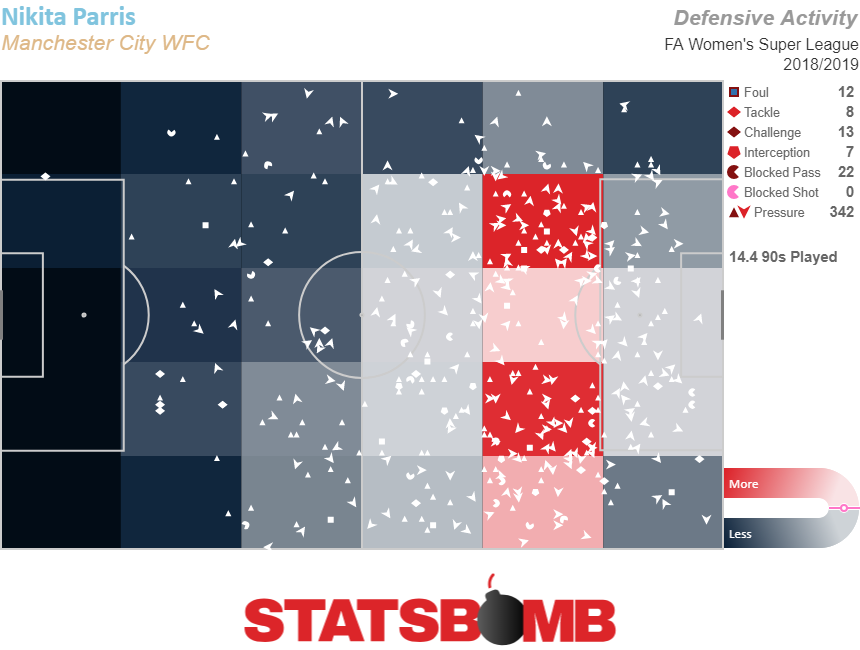 And the rest of the City squad follows suit.
And the rest of the City squad follows suit. 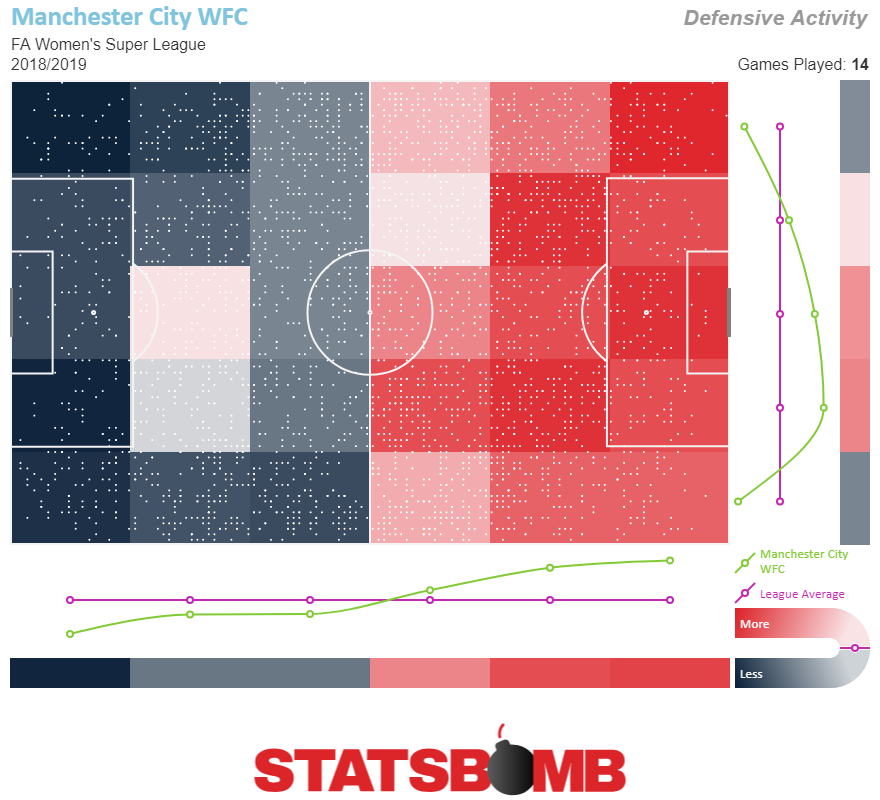 By unsettling opponents high up the pitch, City is able to create chances quickly and effectively. Parris is part of that process too. In addition to her scoring and defending contributions, she is second in the team in expected goals assisted from open play.
By unsettling opponents high up the pitch, City is able to create chances quickly and effectively. Parris is part of that process too. In addition to her scoring and defending contributions, she is second in the team in expected goals assisted from open play. 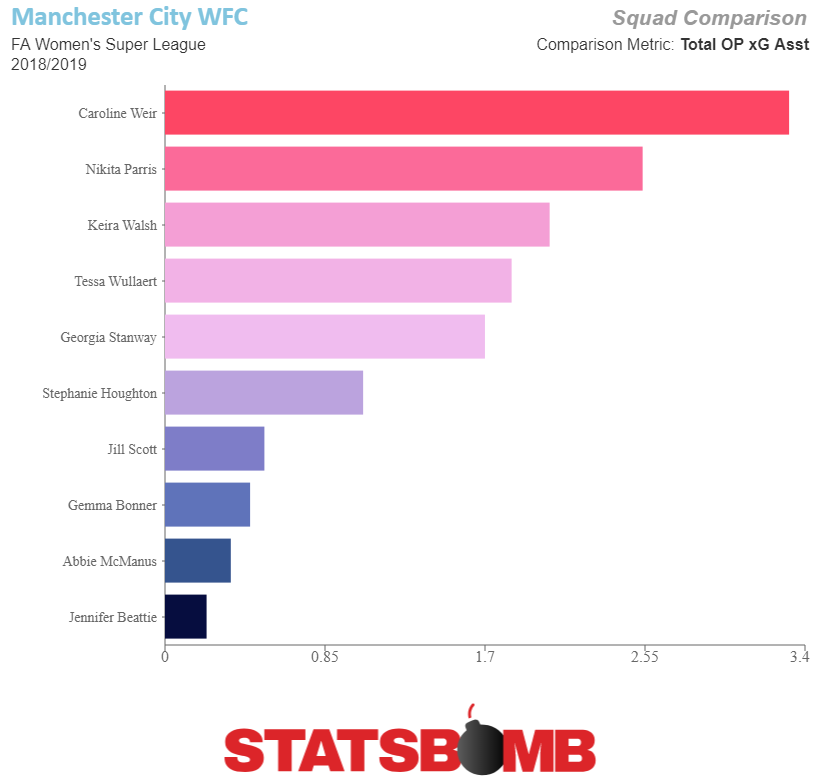 Parris is a top contributor for City in every phase of play. Her disruptive pressing wins the ball back, her passing helps others take advantage of those opportunities and her goal scoring his second to none. The combination of her stellar overall play with Weir's creative contributions and Stanway's sharp shooting is a potent mix that opposing defenses simply have not been able to stop. But, beyond just City, Parris's contributions bode well for the England's chances this summer at the World Cup. Her versatility in attack suggests that Phil Neville could depend on her to fill any number of roles if necessary. She could either facilitate the rest of England's talented attacking score, or do the bulk of the shooting and scoring herself depending on what is required. A player who is an elite attacking force, an elite defender from the front, and a stellar creator is the kind of luxury any manager dreams of being able to deploy. Parris is in an exciting battle with Miedema for the golden boot, one in which, like the title itself, could be decided on in a winner takes all heavyweight clash in May at Meadow Park. With the Continental Cup final between the two sides later on this month, Manchester City’s chances of silverware depend a lot on Parris maintaining her impressive form with and without the ball. If she can do that, and then replicate that form all summer, Parris will literally have the world at her feet. Header image courtesy of the Press Association
Parris is a top contributor for City in every phase of play. Her disruptive pressing wins the ball back, her passing helps others take advantage of those opportunities and her goal scoring his second to none. The combination of her stellar overall play with Weir's creative contributions and Stanway's sharp shooting is a potent mix that opposing defenses simply have not been able to stop. But, beyond just City, Parris's contributions bode well for the England's chances this summer at the World Cup. Her versatility in attack suggests that Phil Neville could depend on her to fill any number of roles if necessary. She could either facilitate the rest of England's talented attacking score, or do the bulk of the shooting and scoring herself depending on what is required. A player who is an elite attacking force, an elite defender from the front, and a stellar creator is the kind of luxury any manager dreams of being able to deploy. Parris is in an exciting battle with Miedema for the golden boot, one in which, like the title itself, could be decided on in a winner takes all heavyweight clash in May at Meadow Park. With the Continental Cup final between the two sides later on this month, Manchester City’s chances of silverware depend a lot on Parris maintaining her impressive form with and without the ball. If she can do that, and then replicate that form all summer, Parris will literally have the world at her feet. Header image courtesy of the Press Association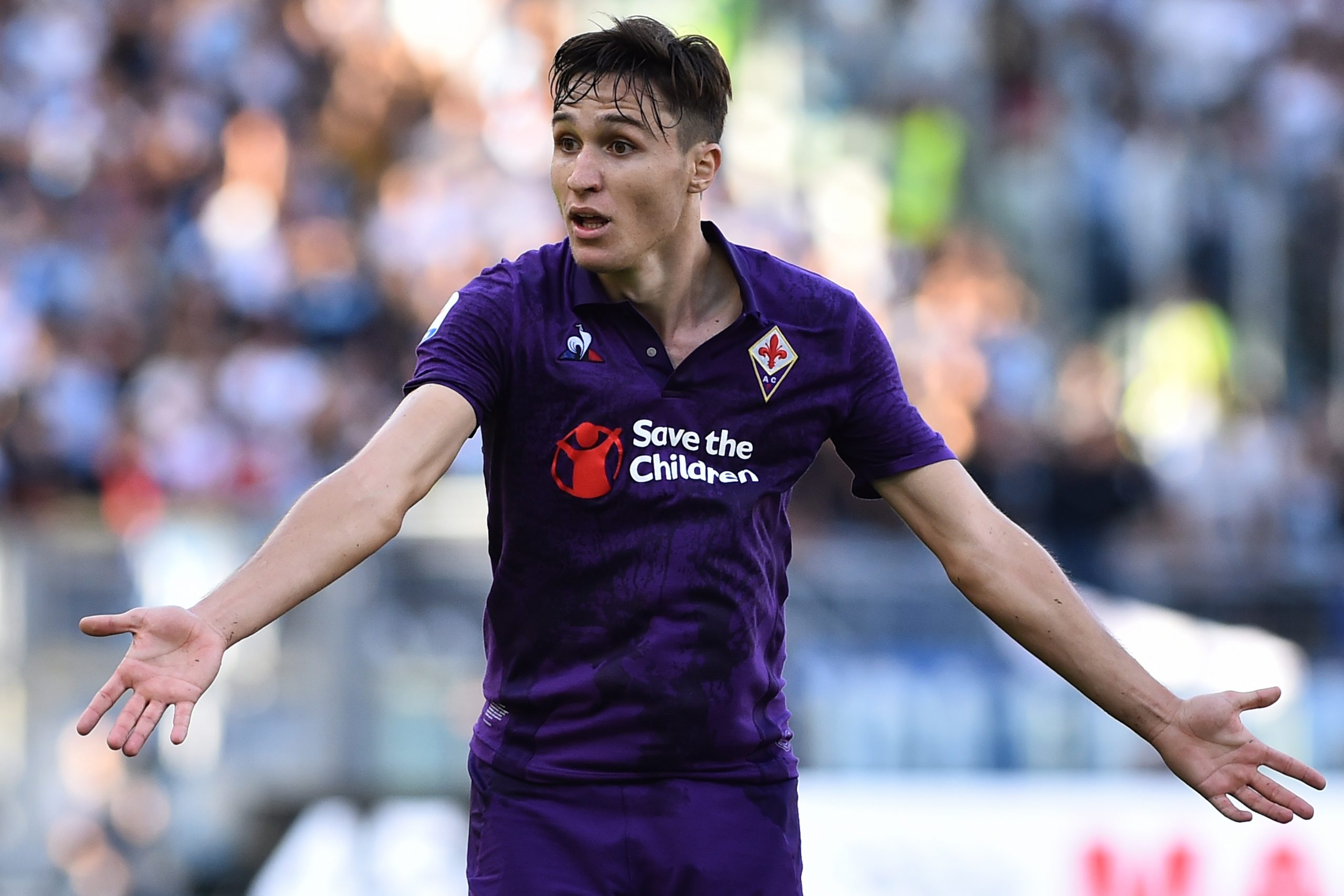
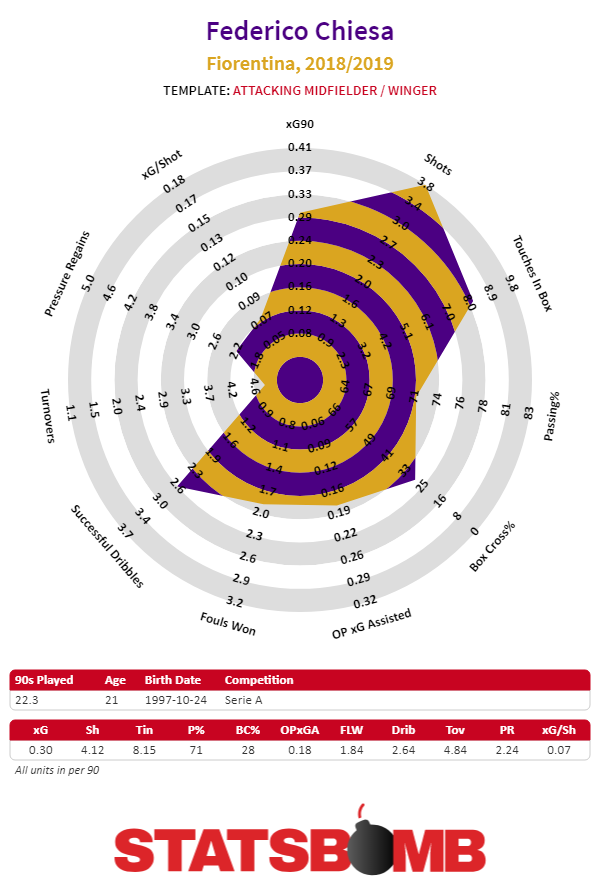
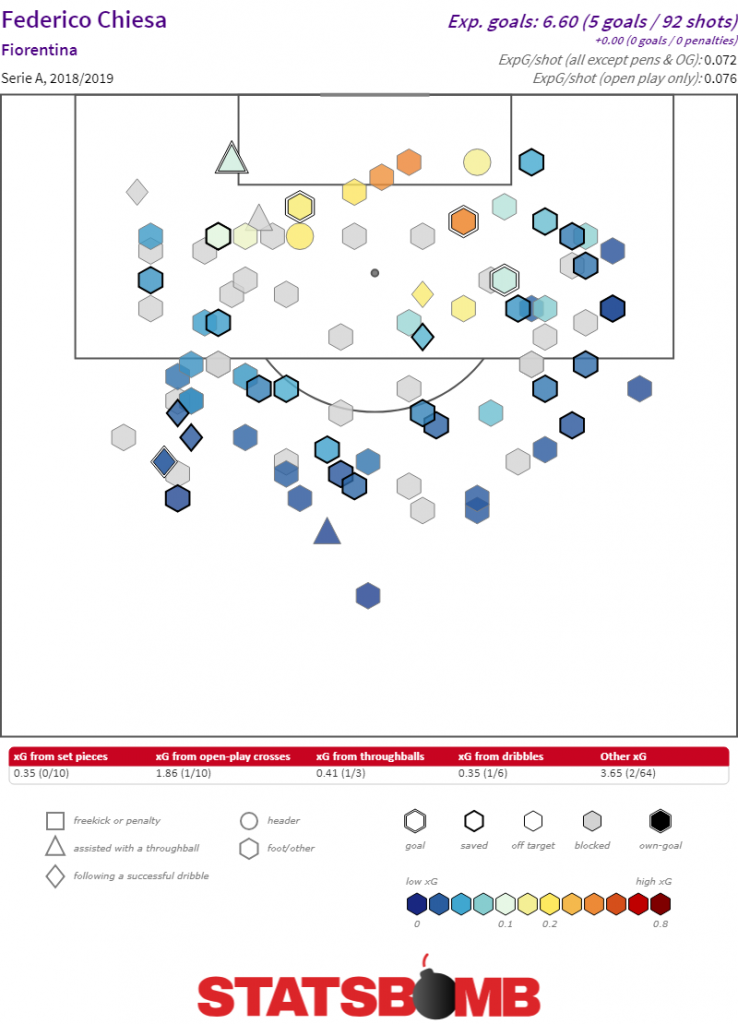
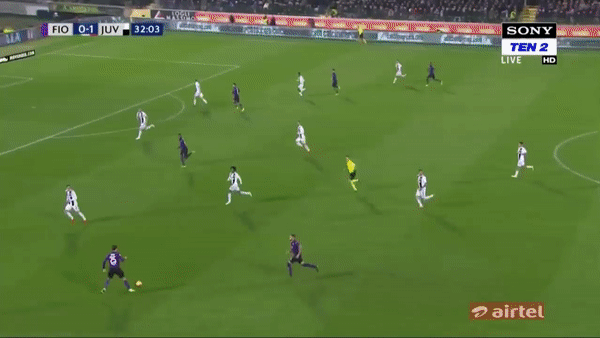

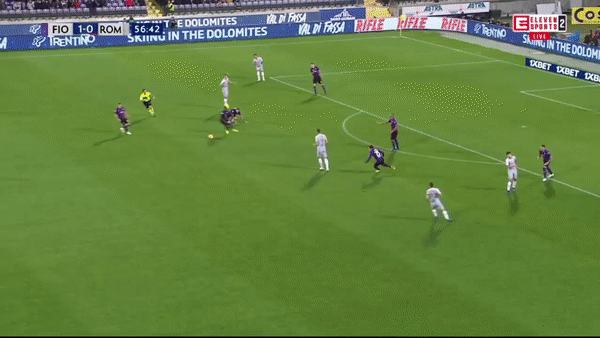
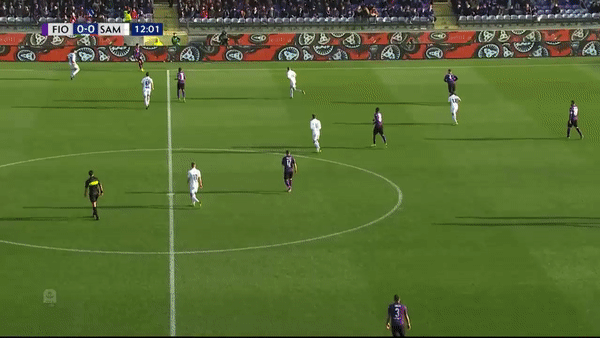
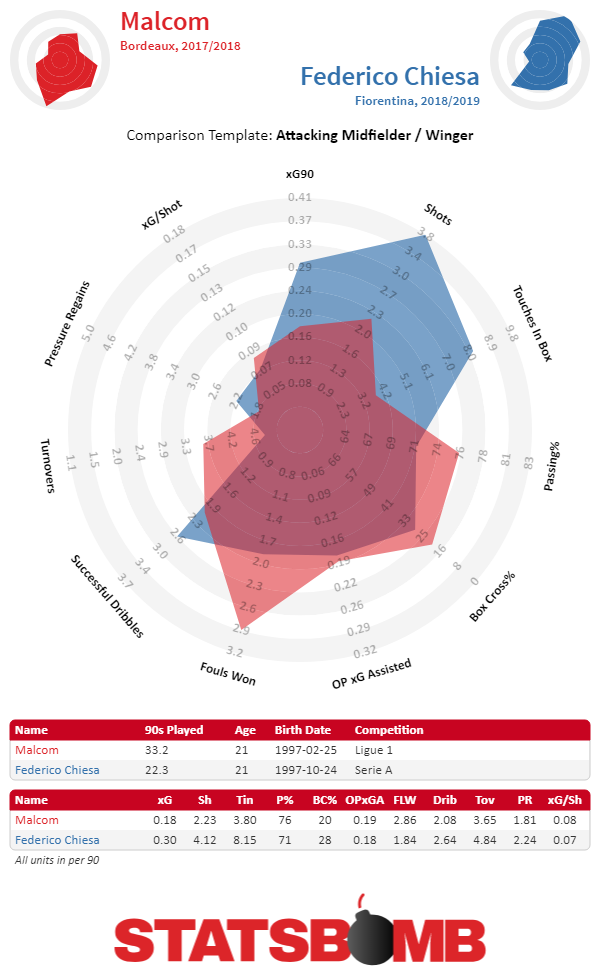 Malcom serves as a bit of a cautionary tale for Chiesa. While Malcom was good enough that bigger clubs around Europe were wise to think hard about acquiring him last summer, there was nothing to suggest that he was ready make the leap to a superclub like Barcelona and get consistent game time, and now it looks like he's going to lose an entire year of development as a result. Young talents in general need ample minutes for their development, and that especially applies to prominent youngsters like Malcom or Ruben Loftus-Cheek as another example. Chiesa would be best off finding a CL level side that he could feel reasonably confident in getting at least 1500 league minutes in a season. There have been reports that Chiesa's future transfer fee will be upwards of £60m, which would be a rather staggering amount for a young player that's a net positive contributor but not necessarily one that's shown to be an unambiguous star talent. Paying close to that fee as a club would be betting that there's a fully realized version waiting to come to the surface, that his shot selection will get better over time. Everton's acquisition of Richarlison last summer was an example of a club spending a premium on a young talent that they judged to be a future star, and to this point that transfer looks to be more of a mixed bag than an undeniable success. While Chiesa is perhaps better than Richarlison, spending £60m or more on him would come with similar downside risk. The outline of a star player is there with Federico Chiesa, whether that turns into something more substantive is anyone's guess. Header image courtesy of the Press Association
Malcom serves as a bit of a cautionary tale for Chiesa. While Malcom was good enough that bigger clubs around Europe were wise to think hard about acquiring him last summer, there was nothing to suggest that he was ready make the leap to a superclub like Barcelona and get consistent game time, and now it looks like he's going to lose an entire year of development as a result. Young talents in general need ample minutes for their development, and that especially applies to prominent youngsters like Malcom or Ruben Loftus-Cheek as another example. Chiesa would be best off finding a CL level side that he could feel reasonably confident in getting at least 1500 league minutes in a season. There have been reports that Chiesa's future transfer fee will be upwards of £60m, which would be a rather staggering amount for a young player that's a net positive contributor but not necessarily one that's shown to be an unambiguous star talent. Paying close to that fee as a club would be betting that there's a fully realized version waiting to come to the surface, that his shot selection will get better over time. Everton's acquisition of Richarlison last summer was an example of a club spending a premium on a young talent that they judged to be a future star, and to this point that transfer looks to be more of a mixed bag than an undeniable success. While Chiesa is perhaps better than Richarlison, spending £60m or more on him would come with similar downside risk. The outline of a star player is there with Federico Chiesa, whether that turns into something more substantive is anyone's guess. Header image courtesy of the Press Association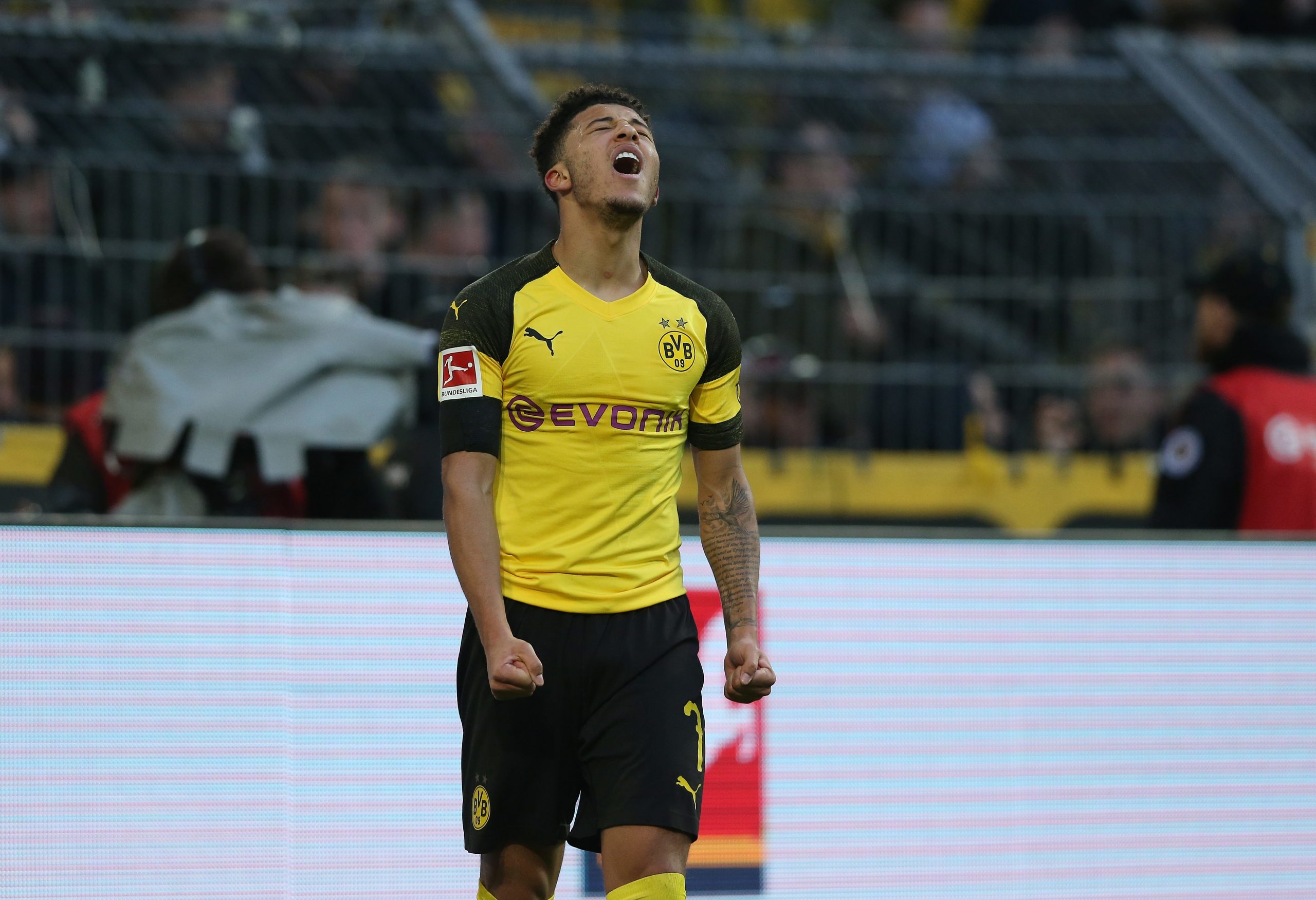

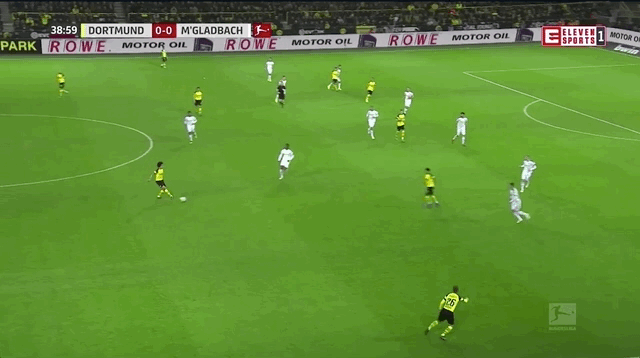
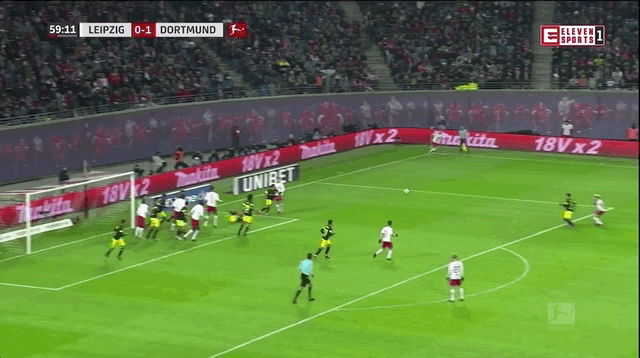
 “Players on the ball have two options,” Lancaster said. “They have the soft option and the hard option. We always try and encourage players to get the ball and face the player up. So, you might receive it so you are facing the defender immediately, which is great, you can go one-on-one. Or if your back is towards the defender, sometimes people just take the soft option and pass it back. Jadon wasn’t happy with that. It was turn and go at this player... If he did turn, and he did attack, that was helping us defensively. He’s now progressed the ball 20 yards up the pitch. If he loses it 20 yards up the pitch, we’re 20 yards further from our goal. So it was all complementary in transitional phases.”
“Players on the ball have two options,” Lancaster said. “They have the soft option and the hard option. We always try and encourage players to get the ball and face the player up. So, you might receive it so you are facing the defender immediately, which is great, you can go one-on-one. Or if your back is towards the defender, sometimes people just take the soft option and pass it back. Jadon wasn’t happy with that. It was turn and go at this player... If he did turn, and he did attack, that was helping us defensively. He’s now progressed the ball 20 yards up the pitch. If he loses it 20 yards up the pitch, we’re 20 yards further from our goal. So it was all complementary in transitional phases.” 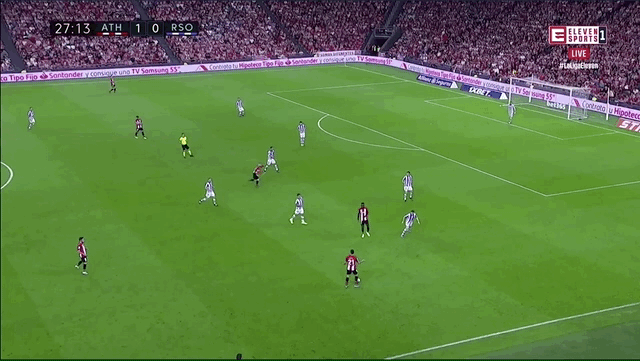
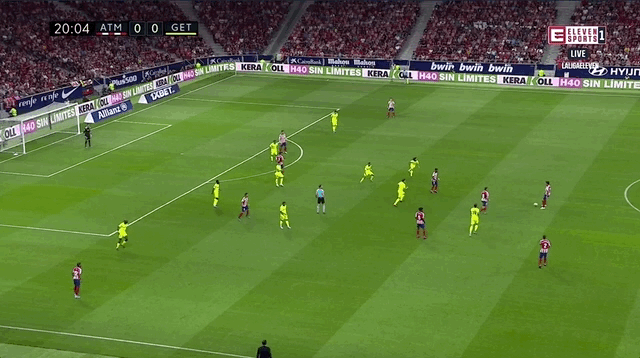
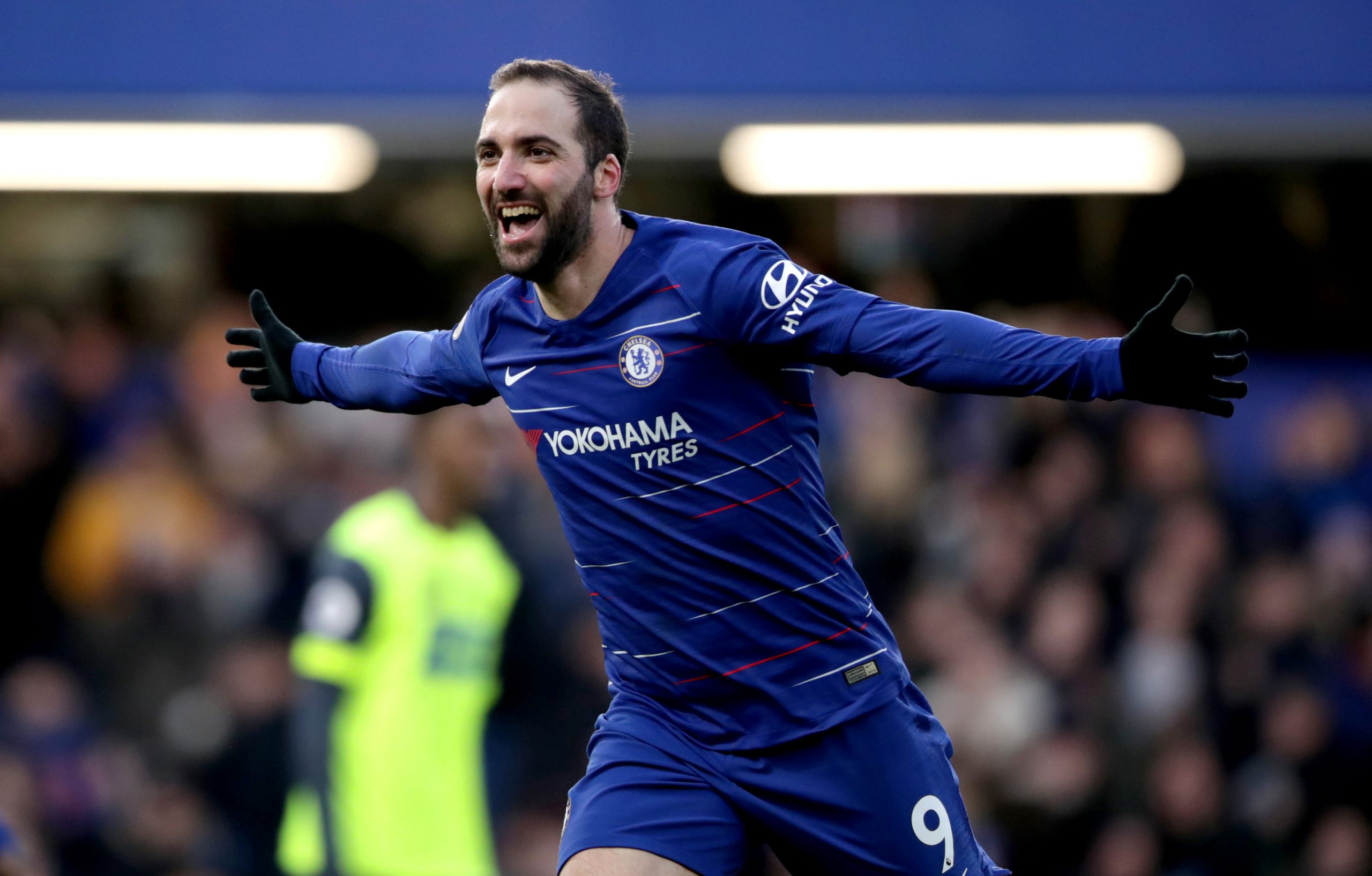
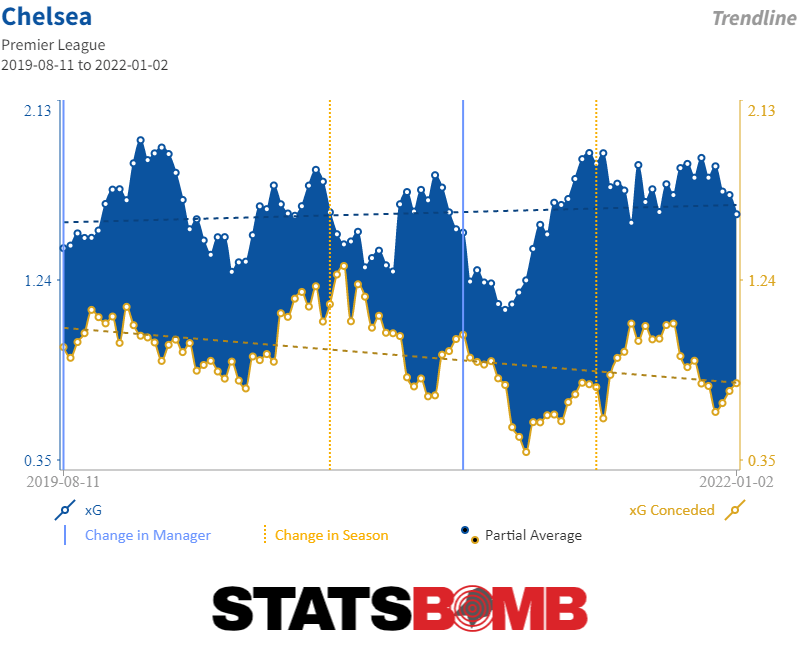
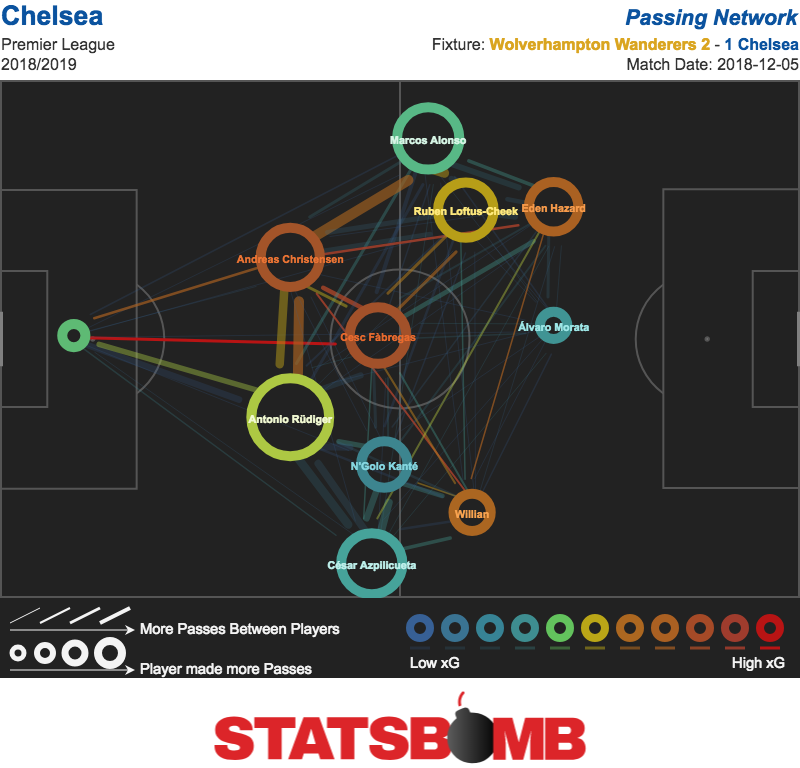

 Let’s be charitable for a second. Let’s say that Higuaín’s numbers declined at Juventus not due to what he was doing but because Massimiliano Allegri’s side are built to defend first and rely on the attack only when they really need it. And let’s say that his issues at Milan were about the Rossoneri being such a mess more than anything else. Thus Higuaín should be fine at 31 now that he’s playing attacking football under a manager who knows exactly how to use him. It’s a stretch, but one you have to believe completely to say this signing will work out.
Let’s be charitable for a second. Let’s say that Higuaín’s numbers declined at Juventus not due to what he was doing but because Massimiliano Allegri’s side are built to defend first and rely on the attack only when they really need it. And let’s say that his issues at Milan were about the Rossoneri being such a mess more than anything else. Thus Higuaín should be fine at 31 now that he’s playing attacking football under a manager who knows exactly how to use him. It’s a stretch, but one you have to believe completely to say this signing will work out. 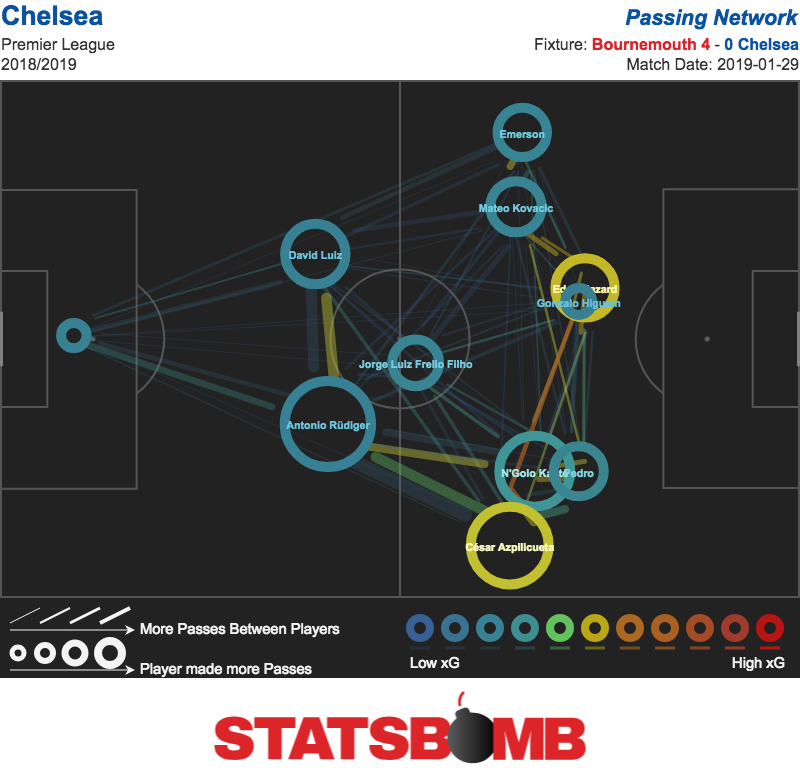
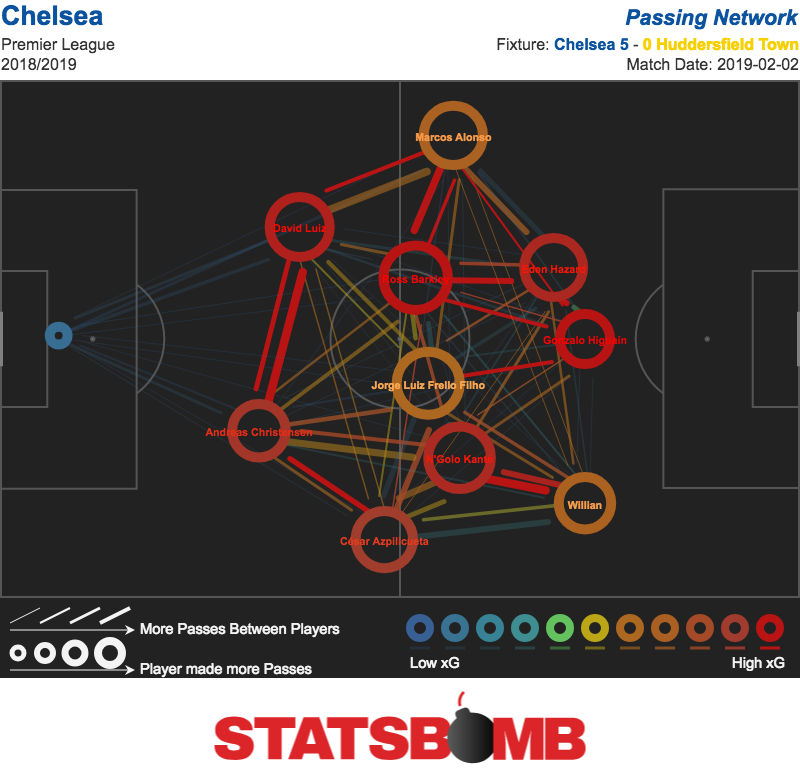
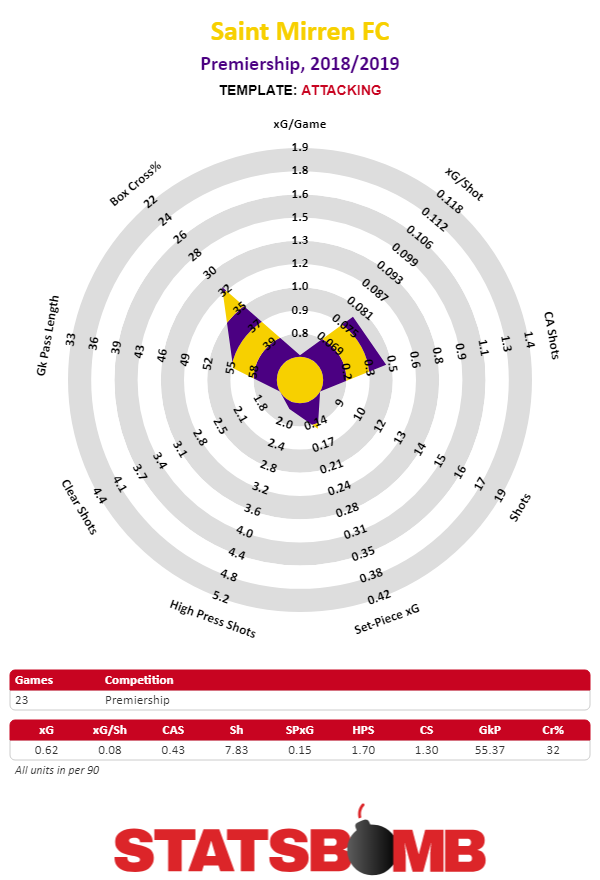
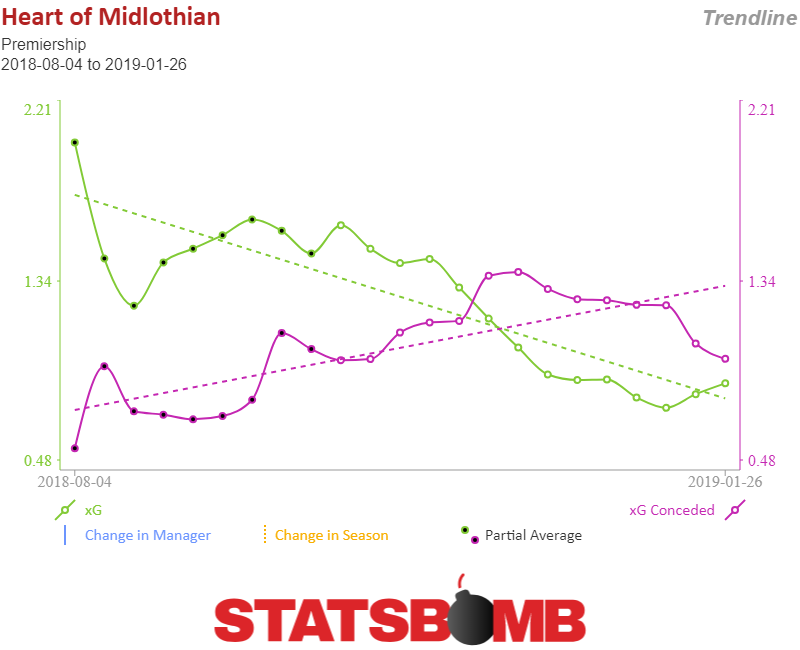 Hearts had a spell from the start of November to Christmas Day during which they lost six of eight games and two of those defeats were by 5-0 scorelines. As noted this was a period when their squad was depleted. Injuries to center back pairing Christophe Berra and John Souttar robbed them of a complementary duo as both can deal with high balls and the former contributes aggressive clearances while the latter can seek out teammates with good long balls. Uche Ikpeazu finally returned to first team action this week and his high volume of shooting, dribbling and aerial wins has been missed. Steven Naismith was out for eight league matches and he was a loss for his goal threat and ability to set standards for others. Since the eight week marker Hearts are taking fewer shots and, although when they do shoot they're now doing it from slightly higher xG situations, they are generating less xG per match on average. Their underlying numbers have been heading in worrying directions at both ends of the pitch.
Hearts had a spell from the start of November to Christmas Day during which they lost six of eight games and two of those defeats were by 5-0 scorelines. As noted this was a period when their squad was depleted. Injuries to center back pairing Christophe Berra and John Souttar robbed them of a complementary duo as both can deal with high balls and the former contributes aggressive clearances while the latter can seek out teammates with good long balls. Uche Ikpeazu finally returned to first team action this week and his high volume of shooting, dribbling and aerial wins has been missed. Steven Naismith was out for eight league matches and he was a loss for his goal threat and ability to set standards for others. Since the eight week marker Hearts are taking fewer shots and, although when they do shoot they're now doing it from slightly higher xG situations, they are generating less xG per match on average. Their underlying numbers have been heading in worrying directions at both ends of the pitch. 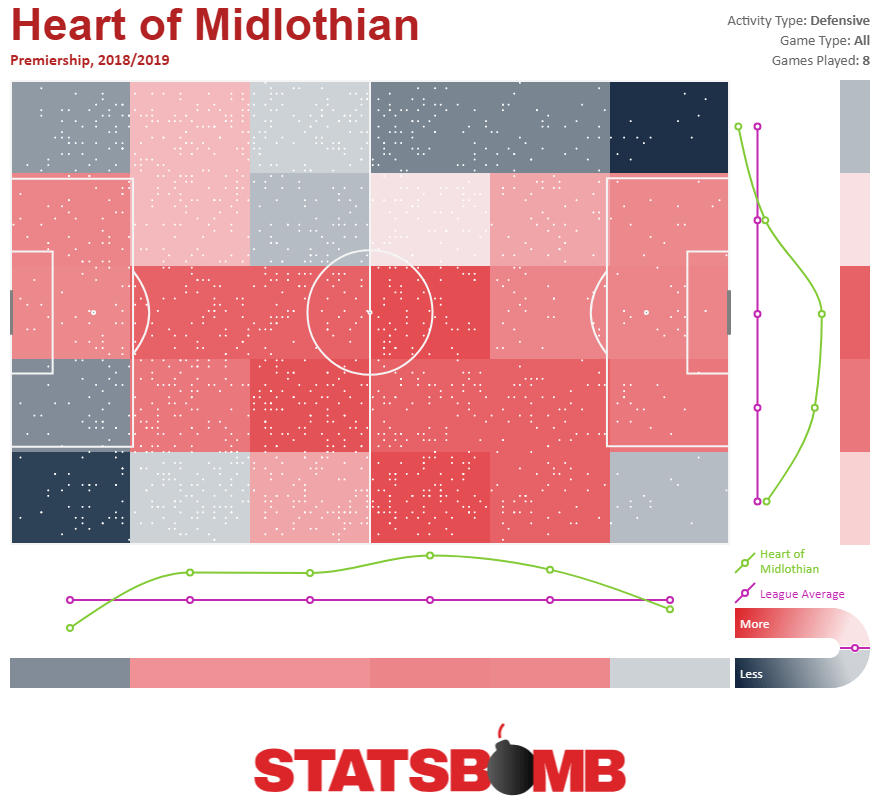
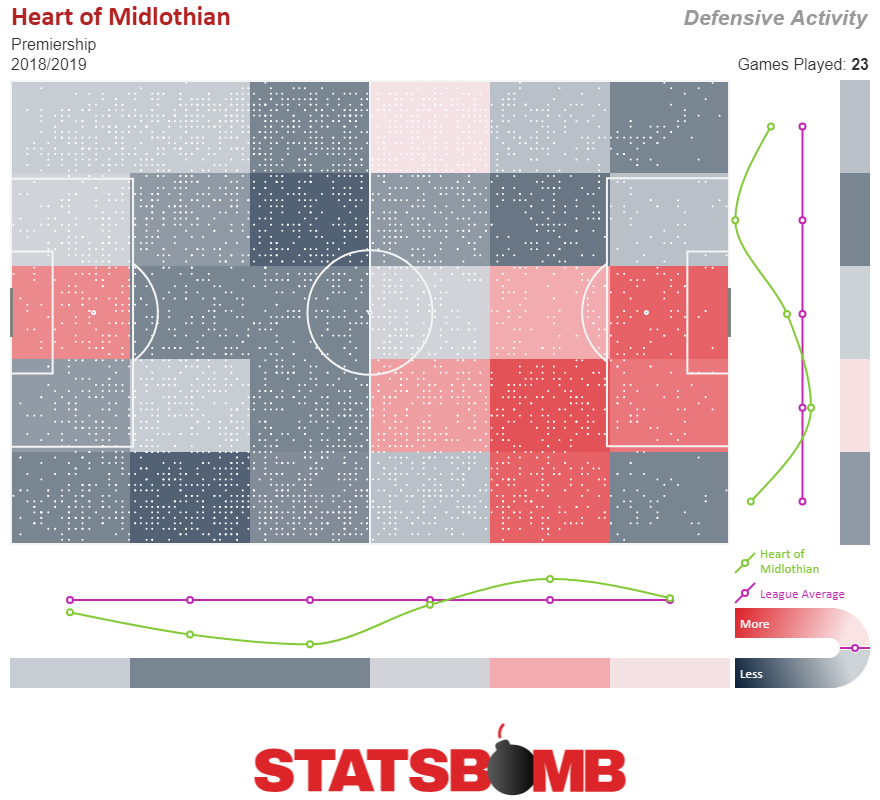
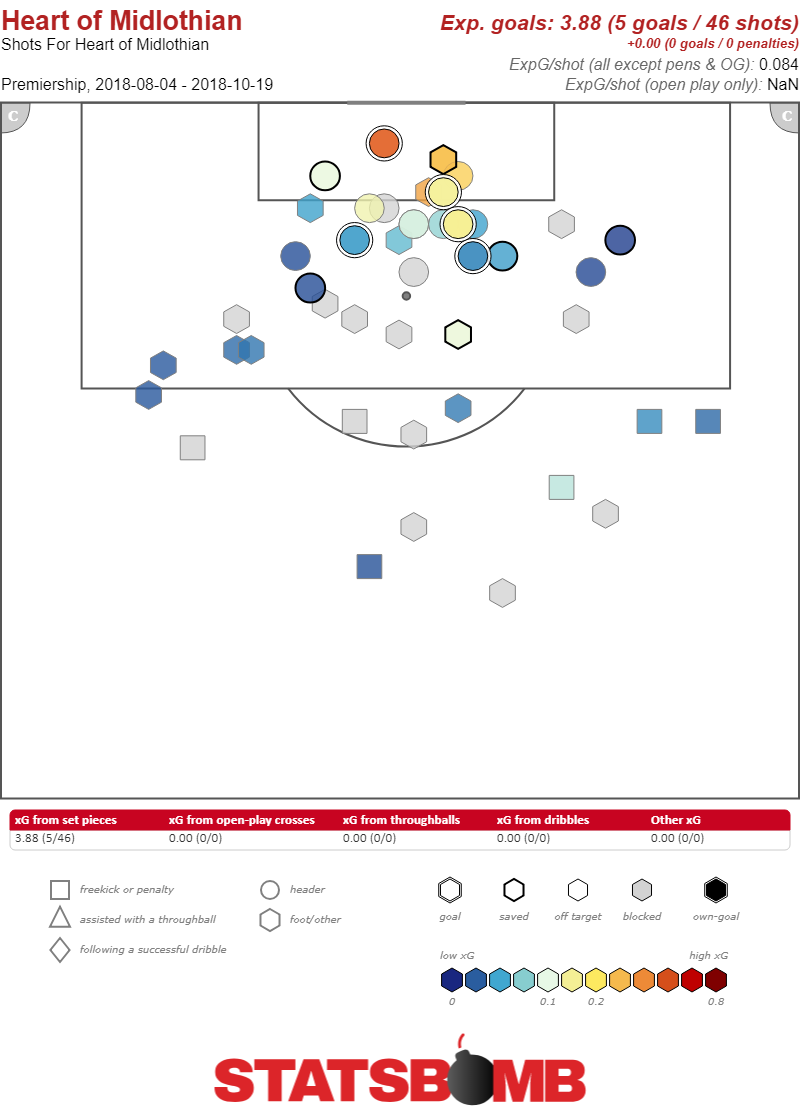
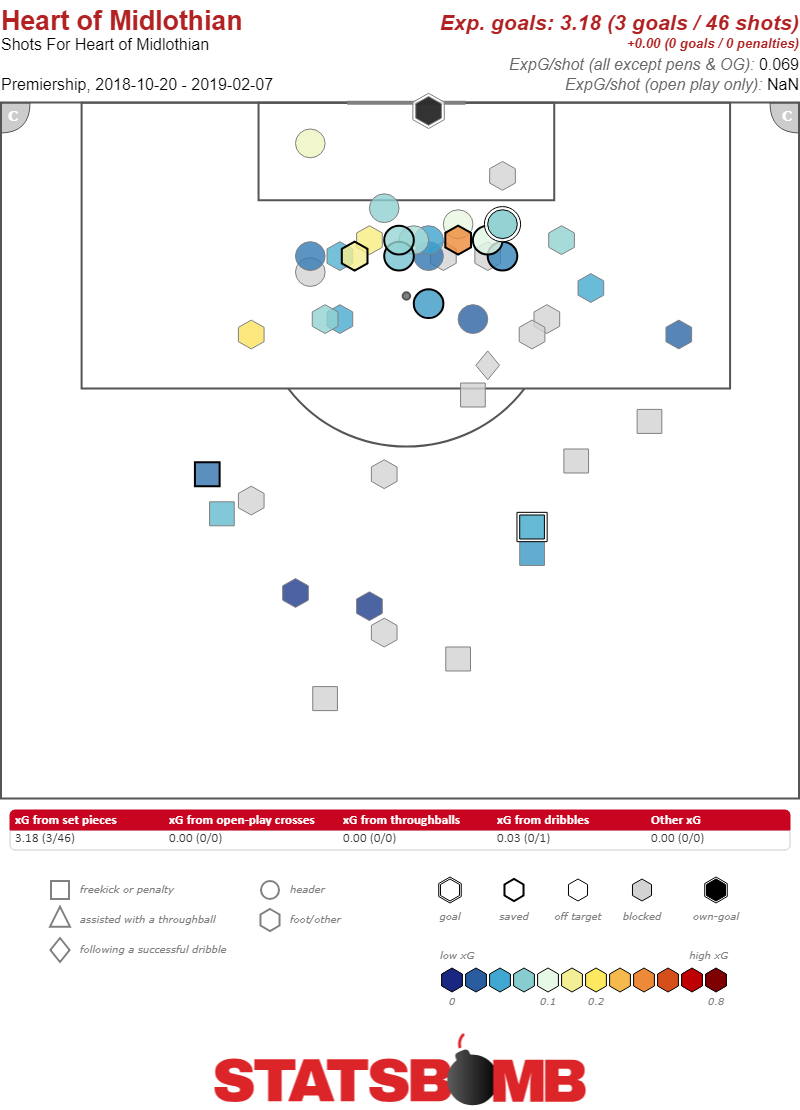 During this period Hearts lost a great deal of intensity and aggression in midfield and also experienced a serious change in their performance from set pieces. After eight weeks of the season they had conceded the lowest xG from set pieces in the league but they have now conceded the fifth highest amount. In the fifteen weeks since that eight week marker they have only been able to double the number of shots from set pieces they had taken. And that more recent set of set piece shots are poorer quality too. Not a shock that a decline in a couple of the areas so key to the Jam Tarts' early success has led to a drop off in results.
During this period Hearts lost a great deal of intensity and aggression in midfield and also experienced a serious change in their performance from set pieces. After eight weeks of the season they had conceded the lowest xG from set pieces in the league but they have now conceded the fifth highest amount. In the fifteen weeks since that eight week marker they have only been able to double the number of shots from set pieces they had taken. And that more recent set of set piece shots are poorer quality too. Not a shock that a decline in a couple of the areas so key to the Jam Tarts' early success has led to a drop off in results. 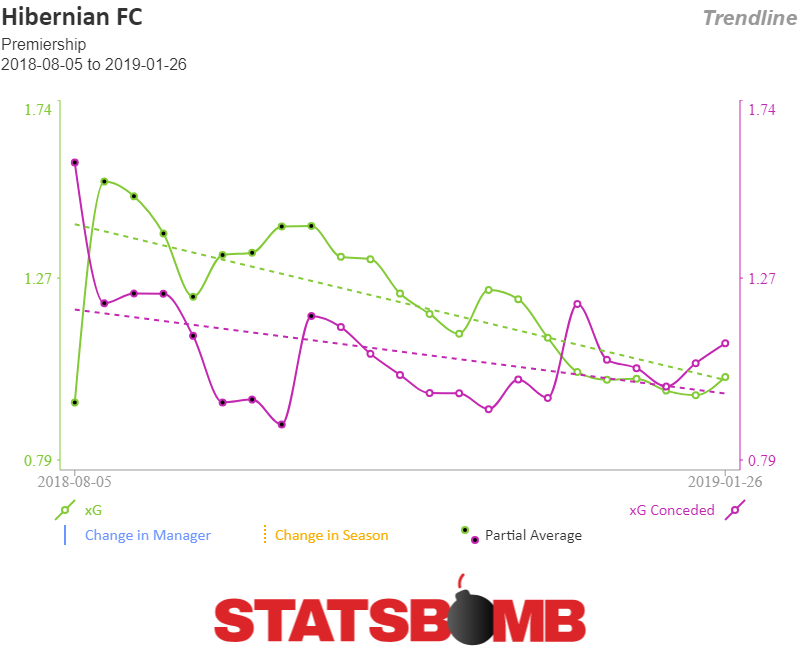 The drop off has been even more pronounced for rivals Hibs. They are now managerless and eleven points behind Hearts. The loss of the entirety of last season's midfield, especially John McGinn's unique blend of grit and glitter, has caught up with them. Add in the departure of ball playing center back Efe Ambrose, the loss of defensive starlet Ryan Porteous to serious injury, rumors of training ground bust-ups and it has been a tough few months.
The drop off has been even more pronounced for rivals Hibs. They are now managerless and eleven points behind Hearts. The loss of the entirety of last season's midfield, especially John McGinn's unique blend of grit and glitter, has caught up with them. Add in the departure of ball playing center back Efe Ambrose, the loss of defensive starlet Ryan Porteous to serious injury, rumors of training ground bust-ups and it has been a tough few months. 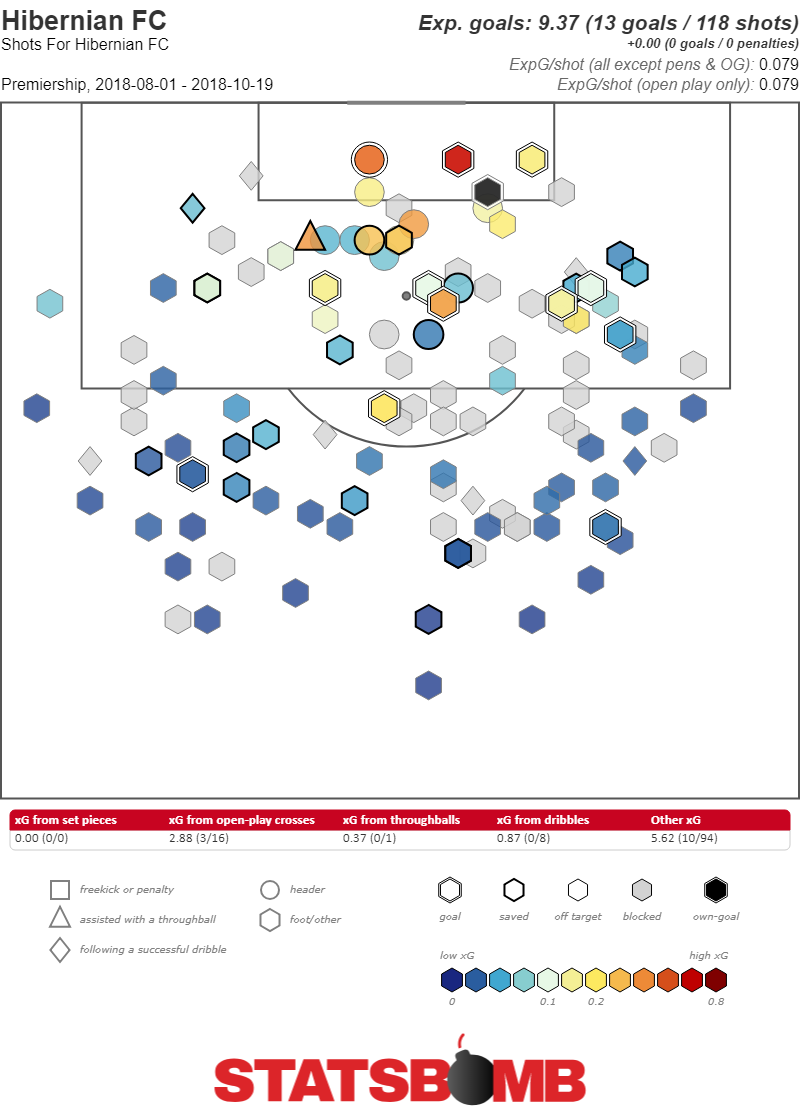
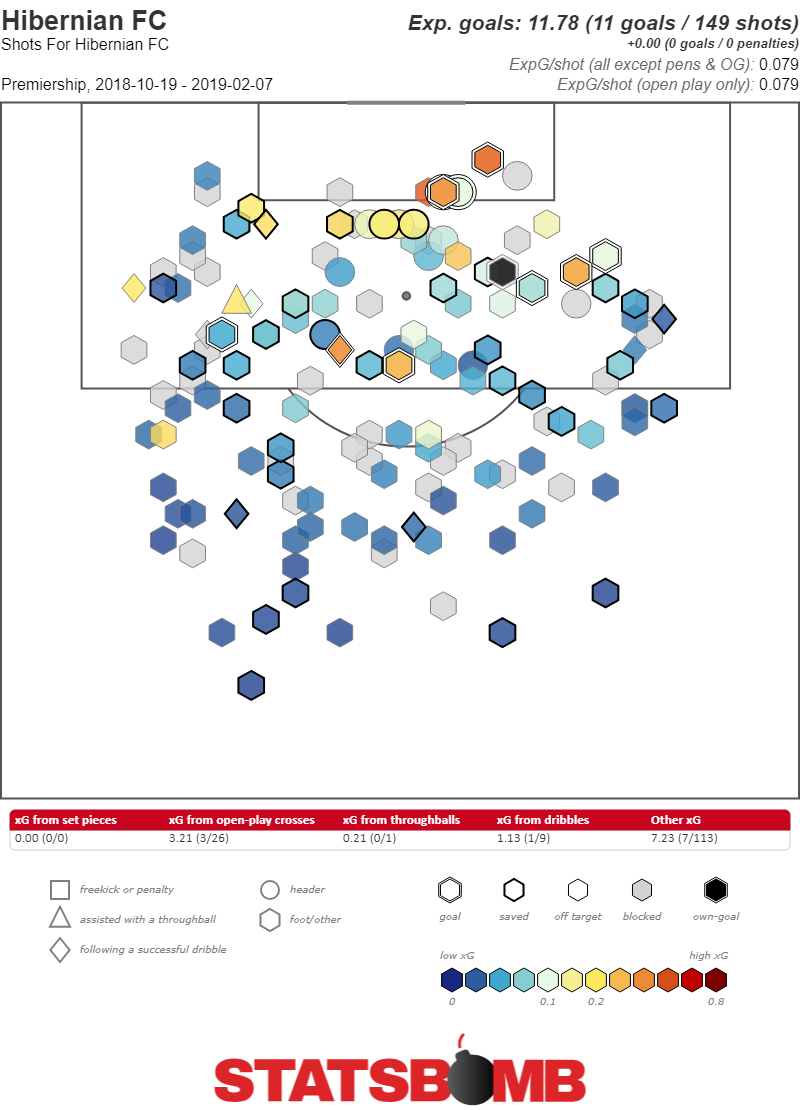 Hibs have been taking fairly mediocre shots from the outset of the season and some early luck in front of goal has dried up. Well, in front of goal is perhaps a little incorrect given the distance that Stevie Mallan attempts pot shots from. In fact, the average distance of a Hibs shot is the third furthest from goal in the league and they take the most shots from outside the box per match.
Hibs have been taking fairly mediocre shots from the outset of the season and some early luck in front of goal has dried up. Well, in front of goal is perhaps a little incorrect given the distance that Stevie Mallan attempts pot shots from. In fact, the average distance of a Hibs shot is the third furthest from goal in the league and they take the most shots from outside the box per match. 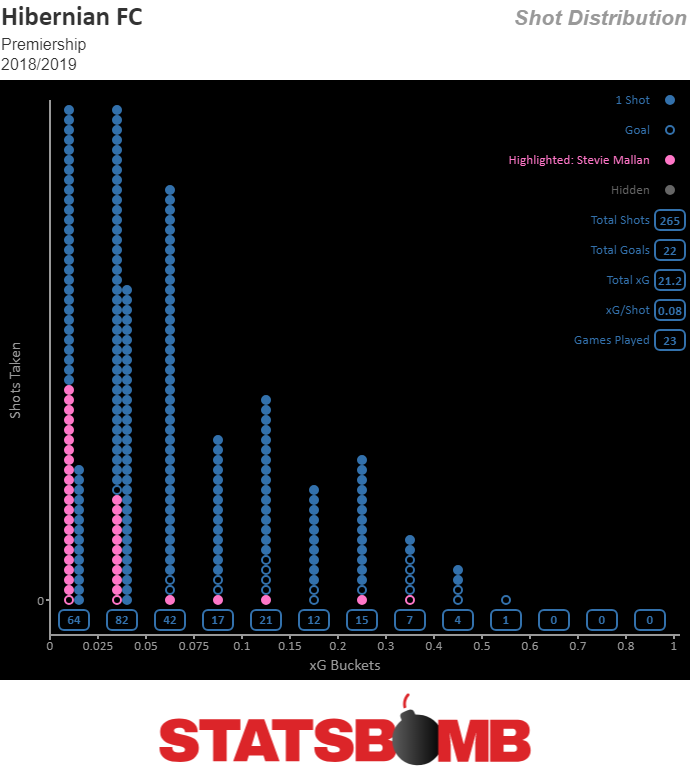 In addition, fewer of their shots since that eight week marker are clear ones at goal or ones straight after winning the ball back in a high press. They're really quite poor at creating good opportunities to score; even their set pieces generate the eighth least xG in the twelve team division. Add in the fact that they are now conceding more shots and significantly more xG on average and it is clear that there is a real lack of sunshine on Leith. While Hearts appear to have turned a corner, are even showing signs of life at set pieces and could be considered to be entering a third act of their season Hibs have lost four of their last five matches and desperately need the renewed sense of direction and fresh tactical ideas a new managerial appointment might bring.
In addition, fewer of their shots since that eight week marker are clear ones at goal or ones straight after winning the ball back in a high press. They're really quite poor at creating good opportunities to score; even their set pieces generate the eighth least xG in the twelve team division. Add in the fact that they are now conceding more shots and significantly more xG on average and it is clear that there is a real lack of sunshine on Leith. While Hearts appear to have turned a corner, are even showing signs of life at set pieces and could be considered to be entering a third act of their season Hibs have lost four of their last five matches and desperately need the renewed sense of direction and fresh tactical ideas a new managerial appointment might bring. 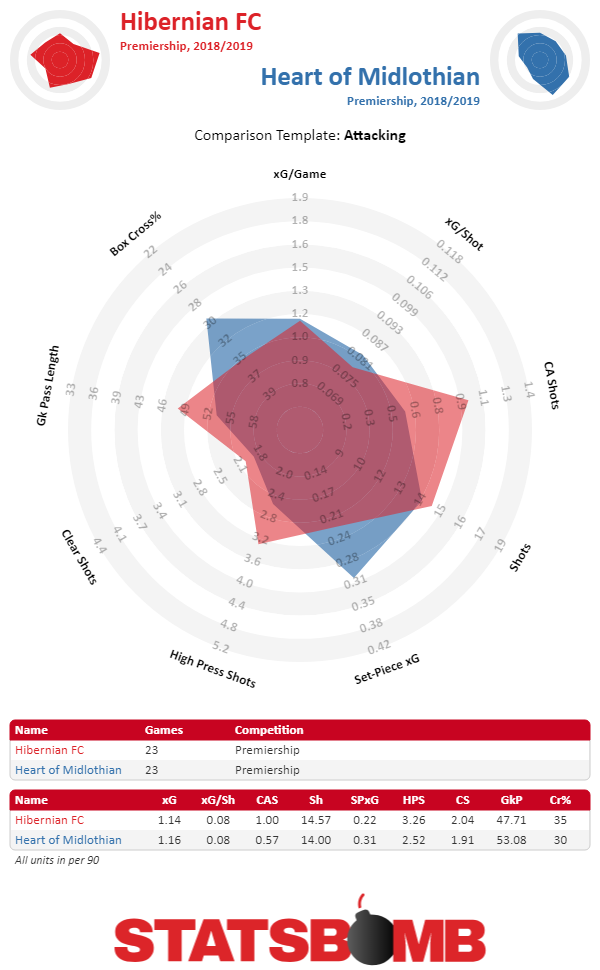
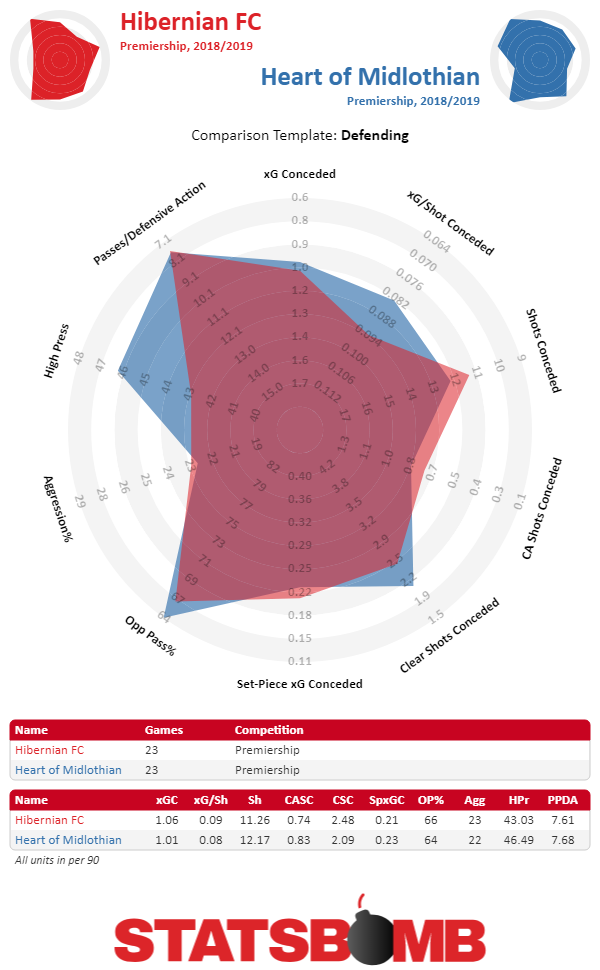
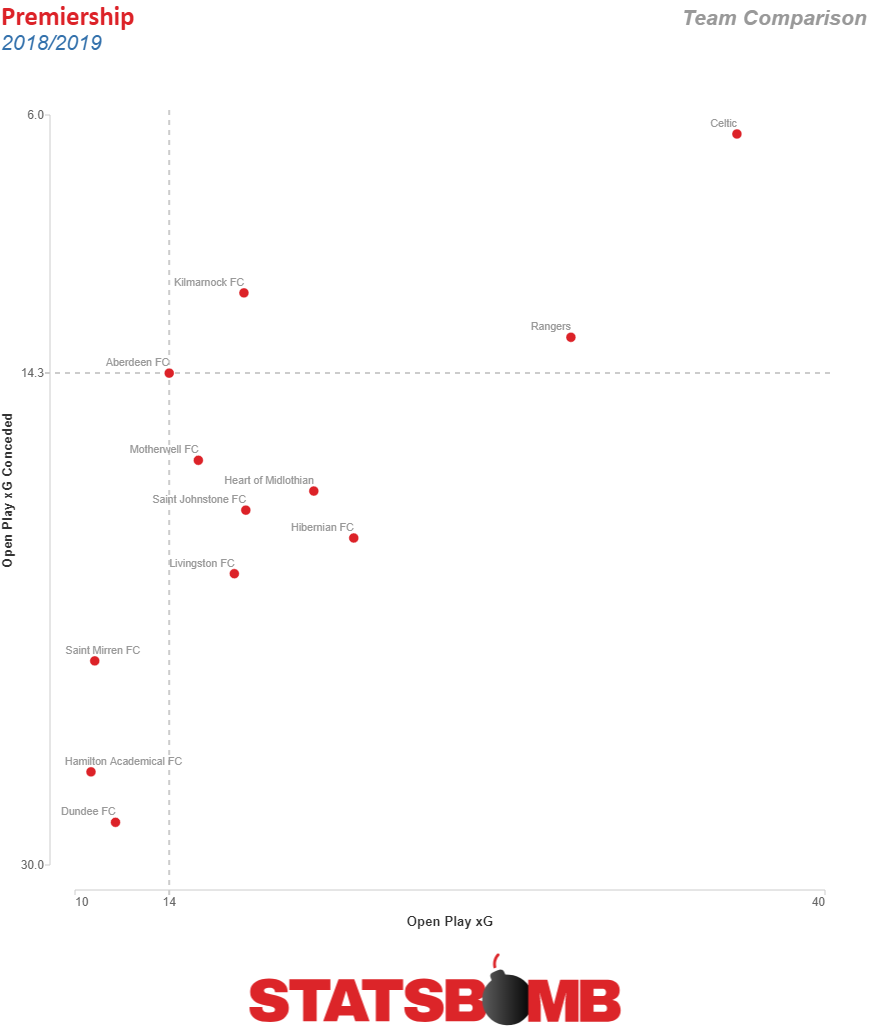 Hamilton have moved into tenth place after a draw and a win in new manager Brian Rice's first two matches. Previous boss Martin Canning had managed the team for four years and if last season's finish outside the relegation spots only on goal difference wasn't a sign that it might be time to move on then the underlying numbers so far this time around certainly were. The Accies take the fewest shots and generate the lowest xG per match in the league. They also concede the most shots, the most xG from set pieces and the second most overall xG per match.
Hamilton have moved into tenth place after a draw and a win in new manager Brian Rice's first two matches. Previous boss Martin Canning had managed the team for four years and if last season's finish outside the relegation spots only on goal difference wasn't a sign that it might be time to move on then the underlying numbers so far this time around certainly were. The Accies take the fewest shots and generate the lowest xG per match in the league. They also concede the most shots, the most xG from set pieces and the second most overall xG per match. 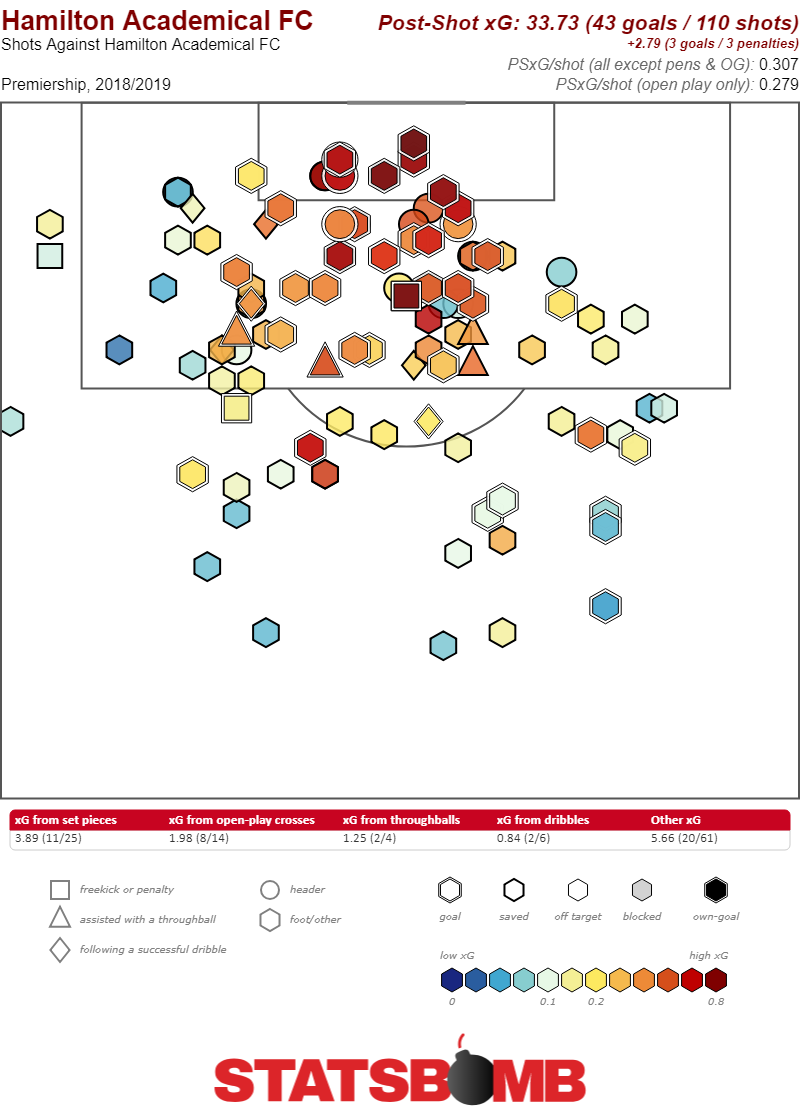
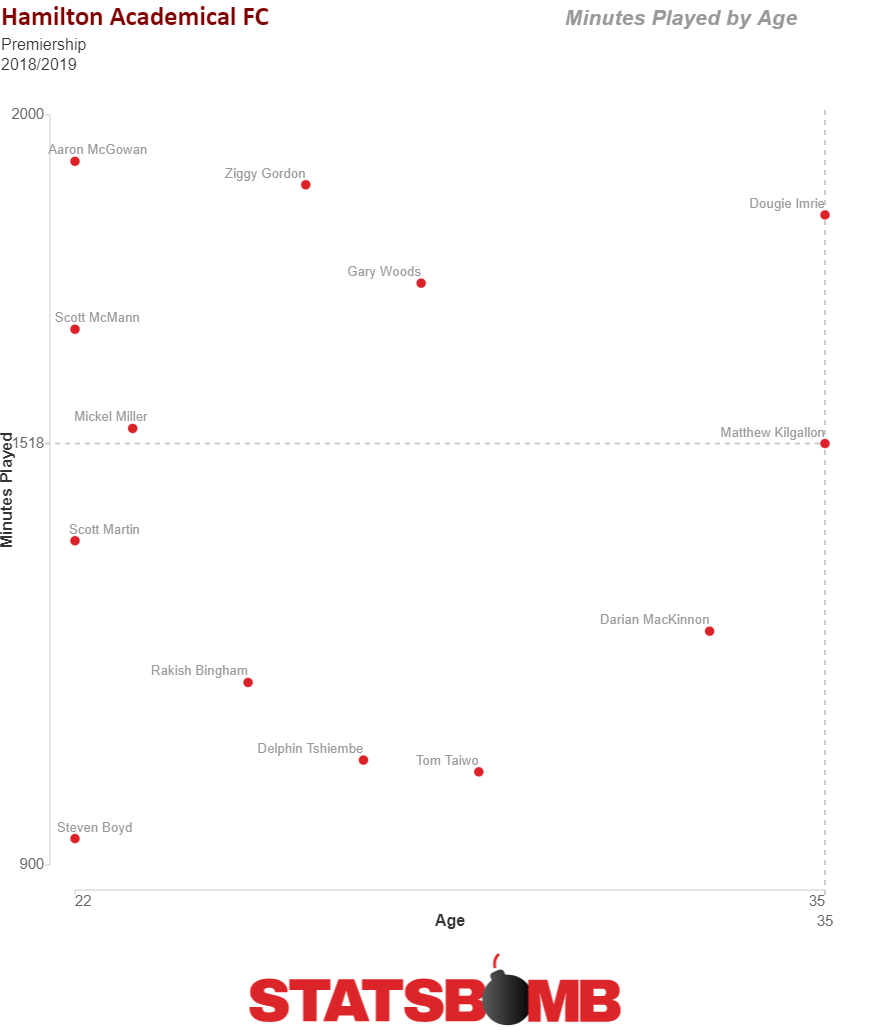 This is a team with real issues all over the pitch. One contributory factor could be the age profile of the squad as an alarmingly low number of minutes have been given to peak age outfield footballers. Hamilton might have had a small upturn in form under their new manager but there is certainly no guarantee their issues are fixed. Their stadium is sponsored by a local medicinal cannabis oil firm and fans might still need hand outs of their chronic pain relief products to get them through the remainder of the season.
This is a team with real issues all over the pitch. One contributory factor could be the age profile of the squad as an alarmingly low number of minutes have been given to peak age outfield footballers. Hamilton might have had a small upturn in form under their new manager but there is certainly no guarantee their issues are fixed. Their stadium is sponsored by a local medicinal cannabis oil firm and fans might still need hand outs of their chronic pain relief products to get them through the remainder of the season. 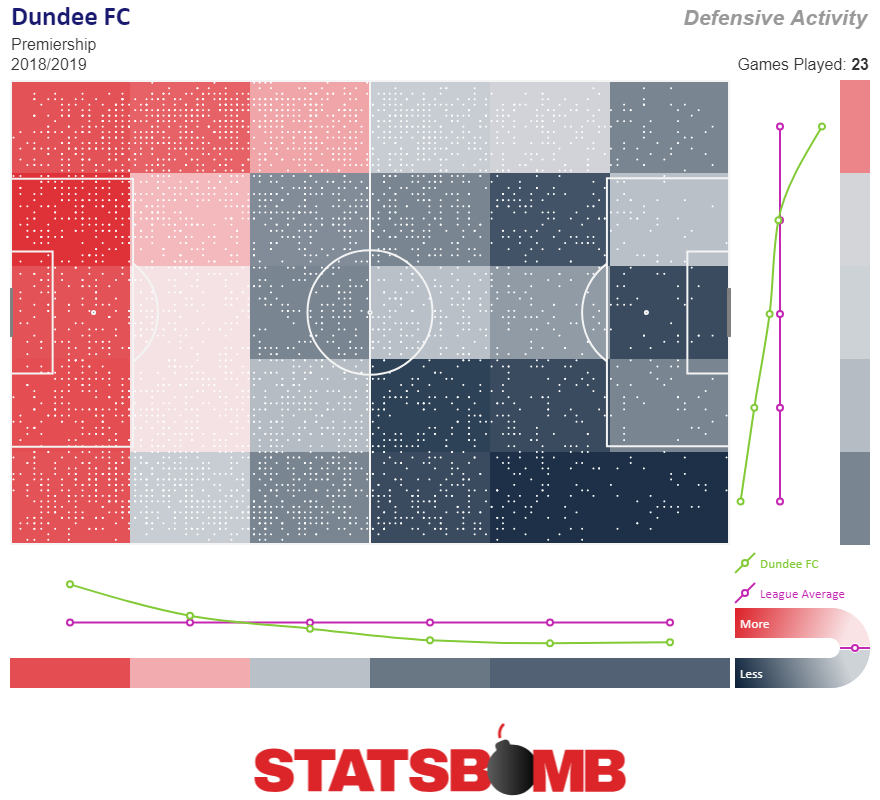 Jim McIntyre may have replaced Neil McCann as Dundee FC manager but they are yet to fully shake off their former boss's style of play. The eleventh placed team make almost twenty fewer aggressive actions than their relegation rivals each match. That lack of aggression until it is too late leads to, no surprise, conceding the second most shots, allowing the highest average xG per shot and giving up the most xG per game in the league. The Dee average 49% of the possession in their matches but having a reasonable share of the ball doesn't seem to help them where it matters. They take the third fewest shots and generate the third lowest xG per match. This team gives up really good chances and just don't have the talent to walk it into the goal at the other end.
Jim McIntyre may have replaced Neil McCann as Dundee FC manager but they are yet to fully shake off their former boss's style of play. The eleventh placed team make almost twenty fewer aggressive actions than their relegation rivals each match. That lack of aggression until it is too late leads to, no surprise, conceding the second most shots, allowing the highest average xG per shot and giving up the most xG per game in the league. The Dee average 49% of the possession in their matches but having a reasonable share of the ball doesn't seem to help them where it matters. They take the third fewest shots and generate the third lowest xG per match. This team gives up really good chances and just don't have the talent to walk it into the goal at the other end. 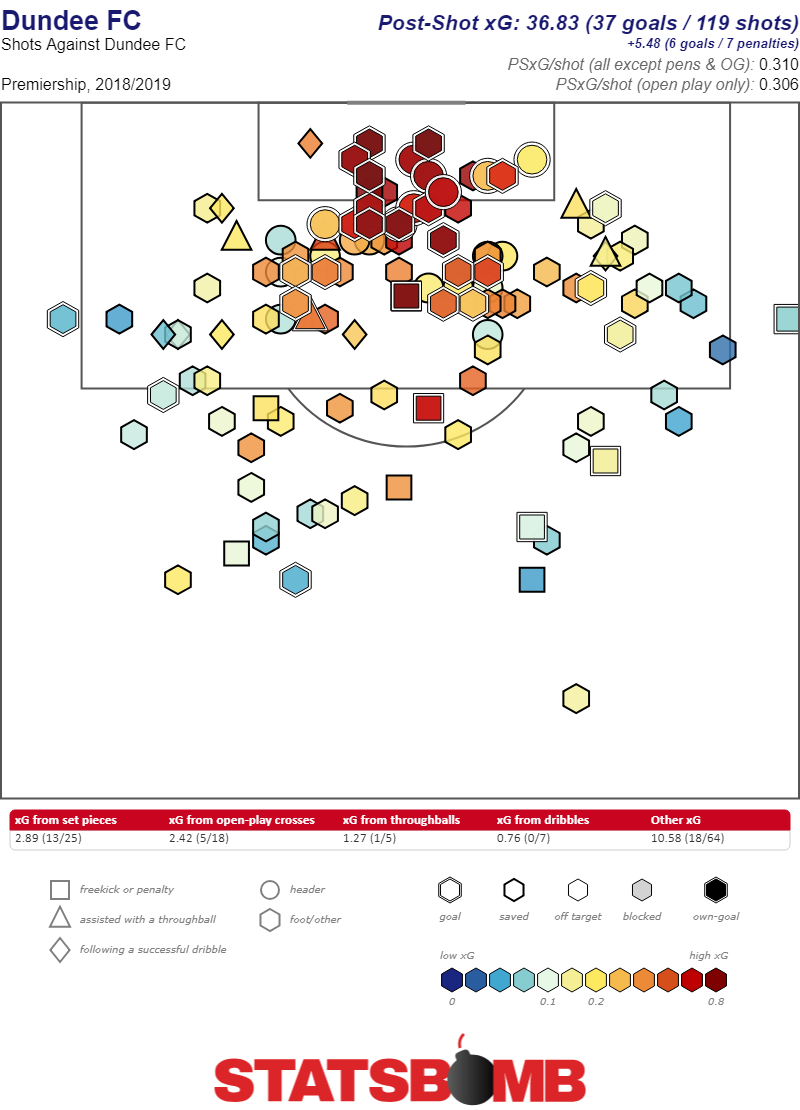 The January additions of goalkeeper Seny Dieng and striker Andrew Nelson could help change Dundee FC's fortunes but fans of the club must be looking at their city's new Victoria and Albert design museum's facade, built to represent Scotland's eastern cliff edges, and picturing their club's precipitous descent to the division below. Dundee may be the city of jute, jam and journalism but Paisley, home to St Mirren, is famous for another kind of print. Paisley Pattern print. The iconic, Kashmiri influenced clothing design features an abstract motif. Is it a fig leaf? An almond? No, come on, those are tear drops. This season St Mirren are on their second manager, their fourth goalkeeper and their fans must have lost track of the number of teeth gnashed, fists clenched, angry words said and, fittingly, tears shed.
The January additions of goalkeeper Seny Dieng and striker Andrew Nelson could help change Dundee FC's fortunes but fans of the club must be looking at their city's new Victoria and Albert design museum's facade, built to represent Scotland's eastern cliff edges, and picturing their club's precipitous descent to the division below. Dundee may be the city of jute, jam and journalism but Paisley, home to St Mirren, is famous for another kind of print. Paisley Pattern print. The iconic, Kashmiri influenced clothing design features an abstract motif. Is it a fig leaf? An almond? No, come on, those are tear drops. This season St Mirren are on their second manager, their fourth goalkeeper and their fans must have lost track of the number of teeth gnashed, fists clenched, angry words said and, fittingly, tears shed. 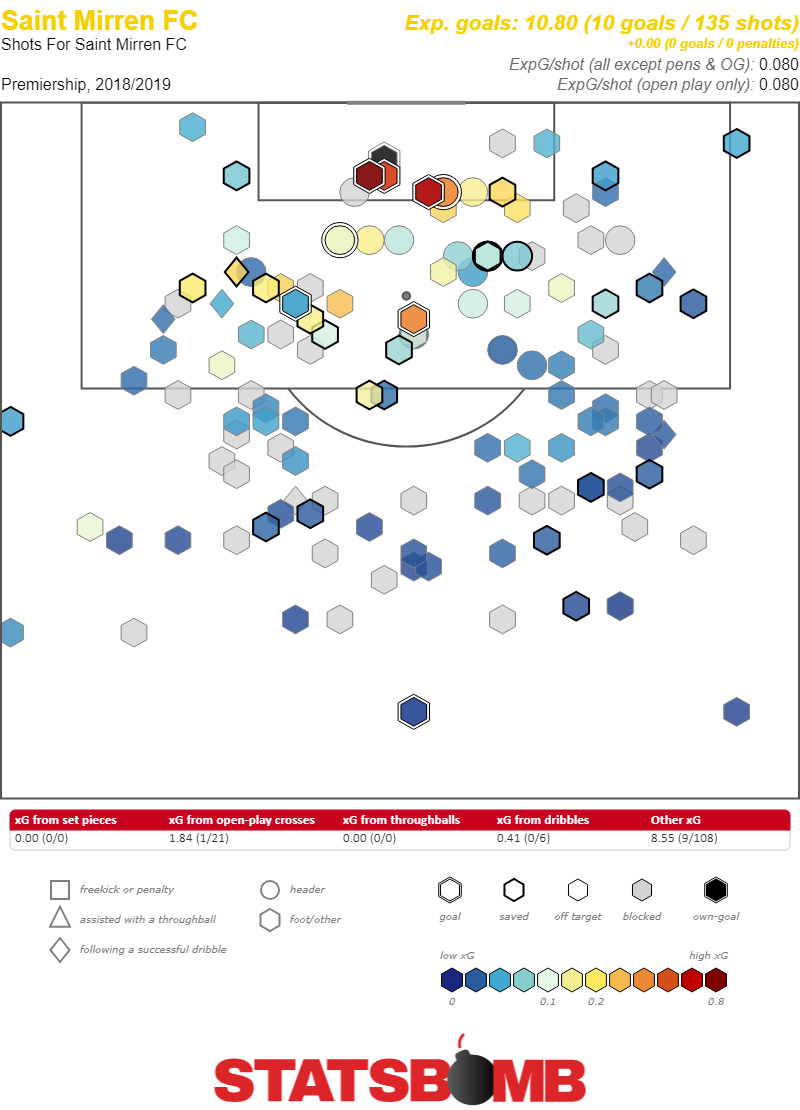 The Buddies concede the fourth most shots per match and the third most xG on average. While this is better than their relegation rivals there has been a lack of any sort of improvement in those underlying numbers throughout the season whereas Dundee FC and Hamilton have shown a capability to do better at times. Unless some of St Mirren's January transfer window additions can make a major difference, and keep in mind that they have already tried out forty different players this season, automatic relegation seems likely. More Paisley pattern shaped tears are yet to come. My feeling is that Dundee FC will rise to tenth and Hamilton will land in the play off spot.
The Buddies concede the fourth most shots per match and the third most xG on average. While this is better than their relegation rivals there has been a lack of any sort of improvement in those underlying numbers throughout the season whereas Dundee FC and Hamilton have shown a capability to do better at times. Unless some of St Mirren's January transfer window additions can make a major difference, and keep in mind that they have already tried out forty different players this season, automatic relegation seems likely. More Paisley pattern shaped tears are yet to come. My feeling is that Dundee FC will rise to tenth and Hamilton will land in the play off spot. 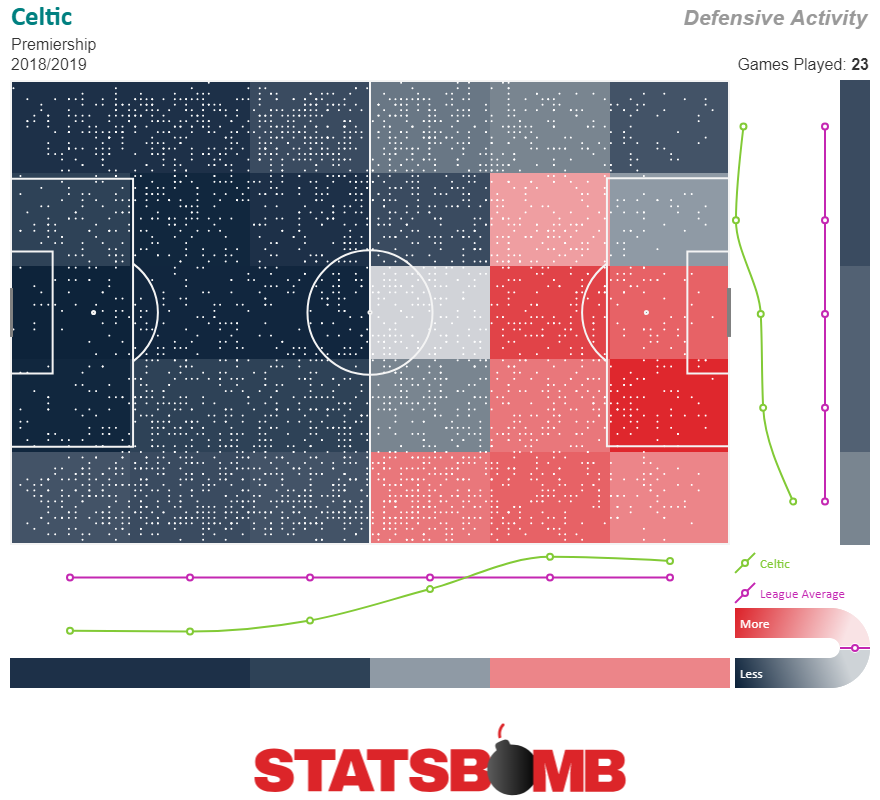
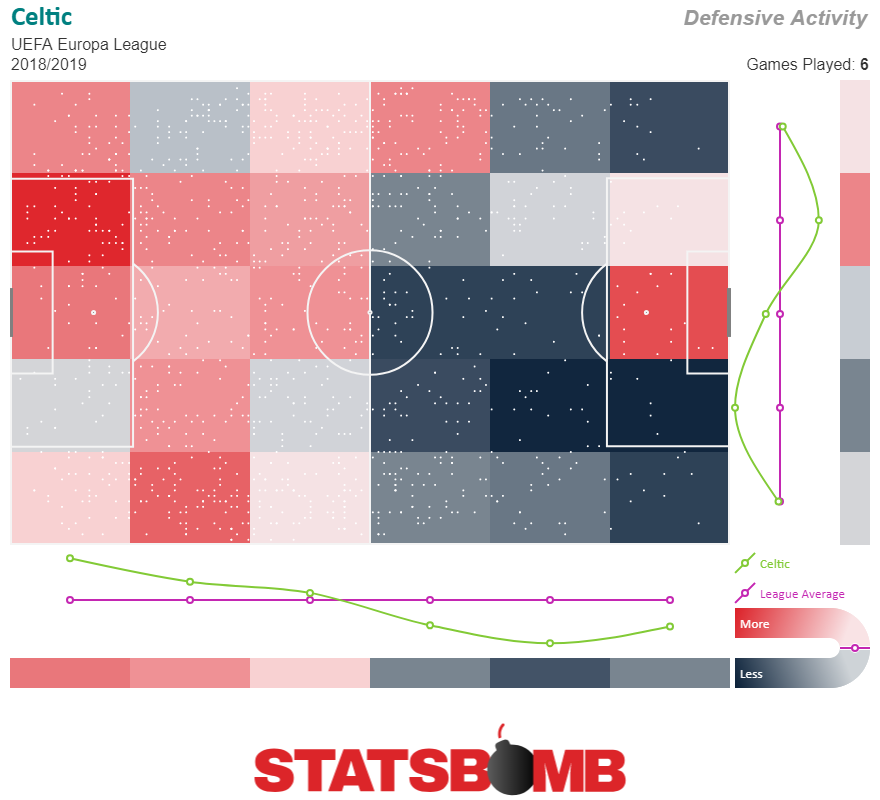 Europe has, naturally, been a different and tougher proposition for Celtic. Just look at the contrast between those defensive activity maps. In their Europa League group they were pressed smartly and aggressively by Red Bull Salzburg and RB Leipzig, in a way they just don't experience in Scotland. Celtic managed an average of just ten shots per match and finished the group stage with a negative xG difference on average. However, they made it through - underlying stats be damned - thanks in part to a Rosenberg victory over RB Leipzig on the final match day. Next week the Glasgow club face Valencia CF in the first leg of the round of 32.
Europe has, naturally, been a different and tougher proposition for Celtic. Just look at the contrast between those defensive activity maps. In their Europa League group they were pressed smartly and aggressively by Red Bull Salzburg and RB Leipzig, in a way they just don't experience in Scotland. Celtic managed an average of just ten shots per match and finished the group stage with a negative xG difference on average. However, they made it through - underlying stats be damned - thanks in part to a Rosenberg victory over RB Leipzig on the final match day. Next week the Glasgow club face Valencia CF in the first leg of the round of 32. 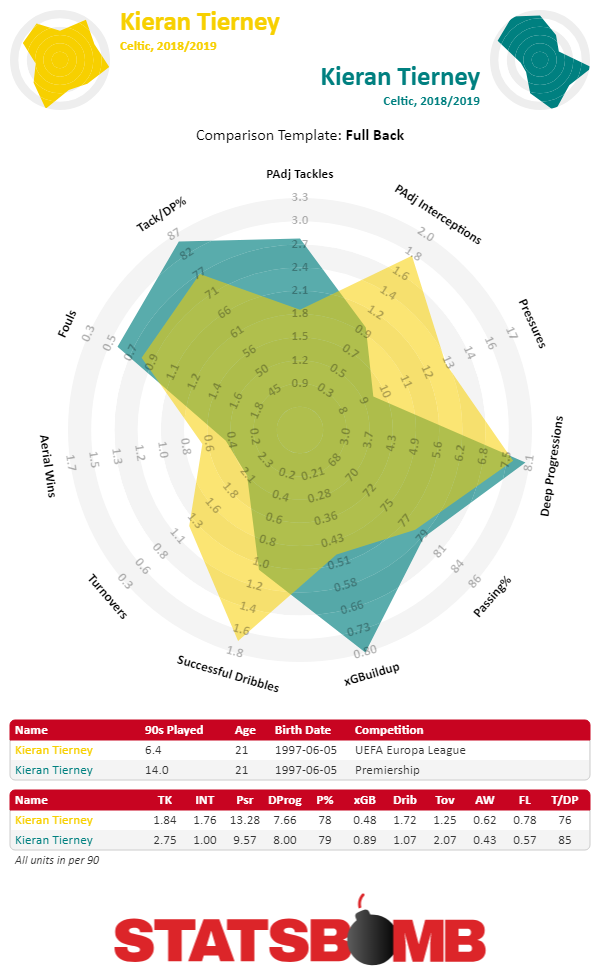 Celtic are in the midst of a bit of an injury crisis with Filip Benkovic, Olivier Ntcham, Odsonne Edouard, Tom Rogic, James Forrest and Kieran Tierney sidelined. Manager Brendan Rodgers was optimistic after the midweek victory against Hibernian that a few of those players would be available for the Valencia match and, despite that lengthy queue at the treatment table, there is a groundswell of optimism around Celtic Park. Five wins with five clean sheets in a row will do that for you. There's also been the small matter of some exciting January transfer window incomings. Timothy Weah and Oliver Burke have added pace, directness, pressing and goals while the arrival of Jeremy Toljan on loan from Borrusia Dortmund adds, well, a right back that can do normal right back things: get forward at speed, stretch defenses to create chances and not add unduly to Scott Brown's defensive workload. He might not be the long term replacement for Mikael Lustig that Celtic desperately need but he could be a game changer for the remainder of this season.
Celtic are in the midst of a bit of an injury crisis with Filip Benkovic, Olivier Ntcham, Odsonne Edouard, Tom Rogic, James Forrest and Kieran Tierney sidelined. Manager Brendan Rodgers was optimistic after the midweek victory against Hibernian that a few of those players would be available for the Valencia match and, despite that lengthy queue at the treatment table, there is a groundswell of optimism around Celtic Park. Five wins with five clean sheets in a row will do that for you. There's also been the small matter of some exciting January transfer window incomings. Timothy Weah and Oliver Burke have added pace, directness, pressing and goals while the arrival of Jeremy Toljan on loan from Borrusia Dortmund adds, well, a right back that can do normal right back things: get forward at speed, stretch defenses to create chances and not add unduly to Scott Brown's defensive workload. He might not be the long term replacement for Mikael Lustig that Celtic desperately need but he could be a game changer for the remainder of this season. 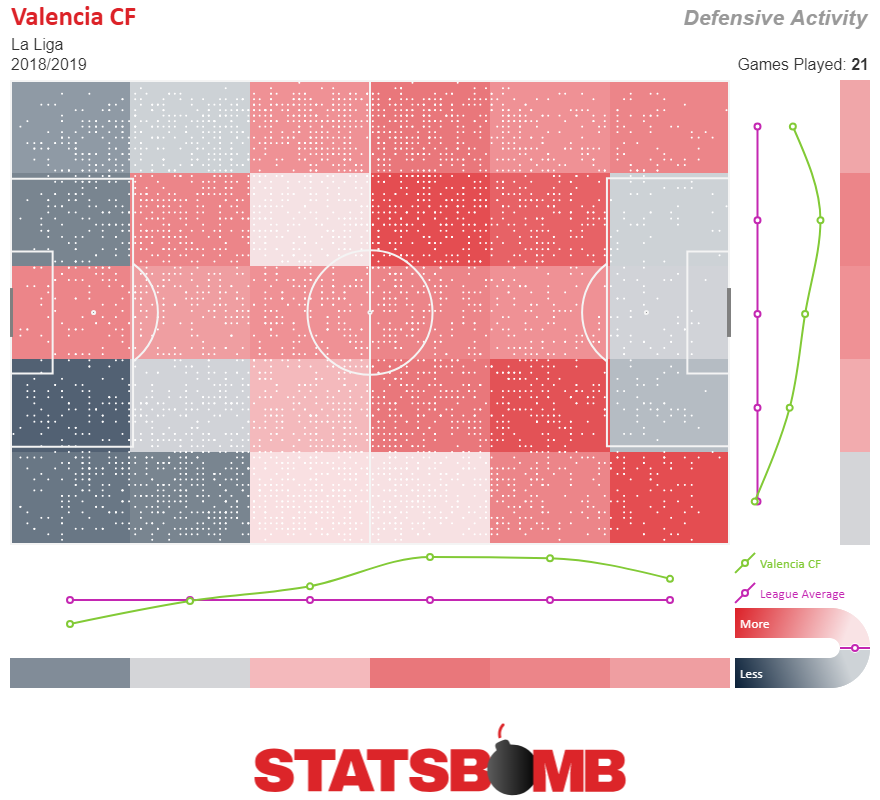 Celtic's fullbacks could be very important against Valencia given the Spanish side's normal approach is to deploy a 4-4-2 formation and apply pressure high up on both flanks. On the right Carlos Soler has added a great deal of industry to his game this season and is making almost six pressure regains every match. Further danger to Celtic could arise from center forward Rodrigo Moreno, a capable dribbler with good shot locations, and playmaker captain Dani Parejo who makes almost ten deep progressions each game. Santi Mina is another dangerman, particularly when he is inspired to play aggressively, but he does lose the ball fairly often and Celtic could pinpoint these turnovers as a starting point for counter attacks. Scotland's champions might also find that, although Valencia do not give away many clear shots at goal, they may be able to exploit space behind center back Ezequiel Garay if he is drawn forward and win high balls against the less aerially dominant Mouctar Diakhaby.
Celtic's fullbacks could be very important against Valencia given the Spanish side's normal approach is to deploy a 4-4-2 formation and apply pressure high up on both flanks. On the right Carlos Soler has added a great deal of industry to his game this season and is making almost six pressure regains every match. Further danger to Celtic could arise from center forward Rodrigo Moreno, a capable dribbler with good shot locations, and playmaker captain Dani Parejo who makes almost ten deep progressions each game. Santi Mina is another dangerman, particularly when he is inspired to play aggressively, but he does lose the ball fairly often and Celtic could pinpoint these turnovers as a starting point for counter attacks. Scotland's champions might also find that, although Valencia do not give away many clear shots at goal, they may be able to exploit space behind center back Ezequiel Garay if he is drawn forward and win high balls against the less aerially dominant Mouctar Diakhaby. 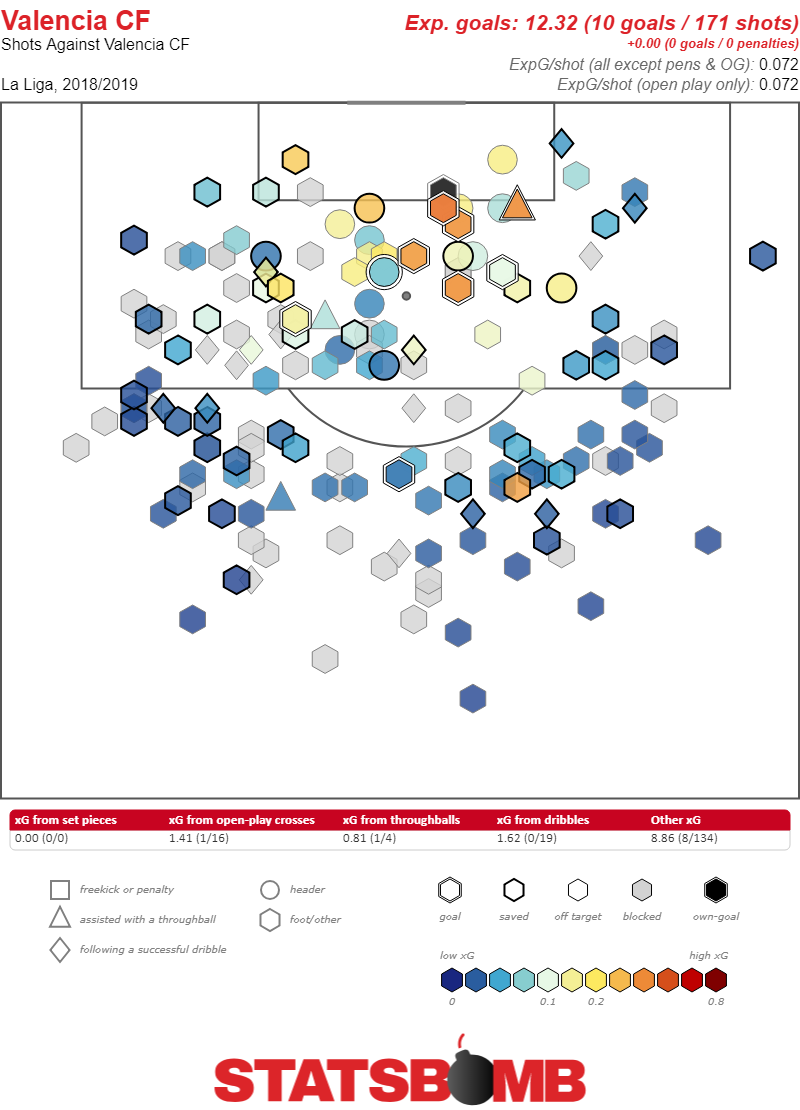 Valencia have had a strange season in La Liga. They had only won four games by the start of January and even now are down in eight place. So far things haven't quite worked out in front of goal; they have only scored fifteen times from open play whereas they've created an open play xG of 24. They have been accused of not seizing the initiative in games and manager Marcelino has faced criticism for not being able to evolve the team successfully from last season. However, they create the second highest average xG and concede the lowest average xG per match and have the second best average xG difference in the league!
Valencia have had a strange season in La Liga. They had only won four games by the start of January and even now are down in eight place. So far things haven't quite worked out in front of goal; they have only scored fifteen times from open play whereas they've created an open play xG of 24. They have been accused of not seizing the initiative in games and manager Marcelino has faced criticism for not being able to evolve the team successfully from last season. However, they create the second highest average xG and concede the lowest average xG per match and have the second best average xG difference in the league! 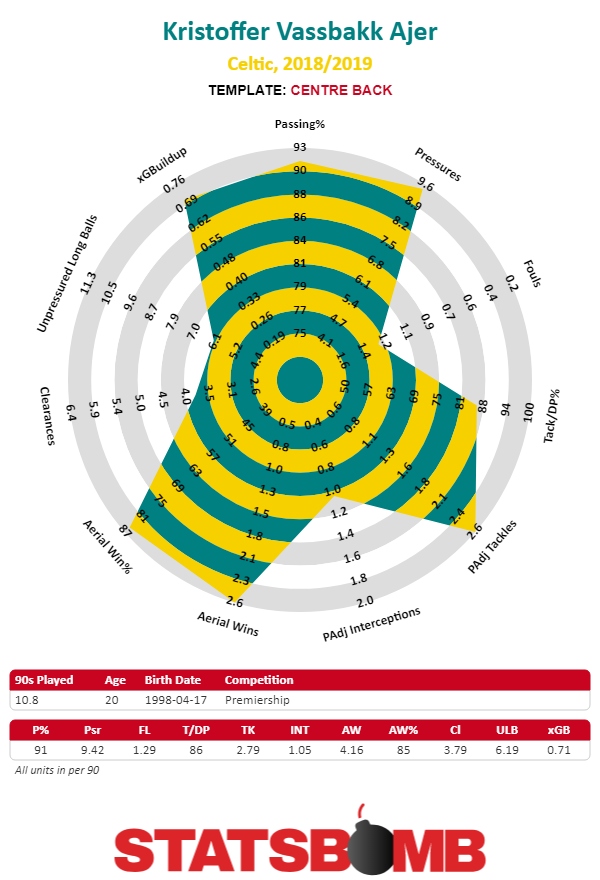 All those underlying stats underline the fact that Los Che are high quality opposition for Celtic to face. If Rodgers continues with the selection of Scott Bain instead of Craig Gordon in goal his superior ability with the ball at his feet should assist the Hoops backline in coping with Valencia's pressure. In addition, Kristoffer Ajer will need to move on quickly from the red card he received after being caught in possession against St Johnstone and be ready to evade the press with passes and dribbles out of defense. Add the electric, in form, Weah to the mix and this match, one of the few remaining ones likely to challenge Celtic this season, could be yet another historic European victory for the Hoops.
All those underlying stats underline the fact that Los Che are high quality opposition for Celtic to face. If Rodgers continues with the selection of Scott Bain instead of Craig Gordon in goal his superior ability with the ball at his feet should assist the Hoops backline in coping with Valencia's pressure. In addition, Kristoffer Ajer will need to move on quickly from the red card he received after being caught in possession against St Johnstone and be ready to evade the press with passes and dribbles out of defense. Add the electric, in form, Weah to the mix and this match, one of the few remaining ones likely to challenge Celtic this season, could be yet another historic European victory for the Hoops.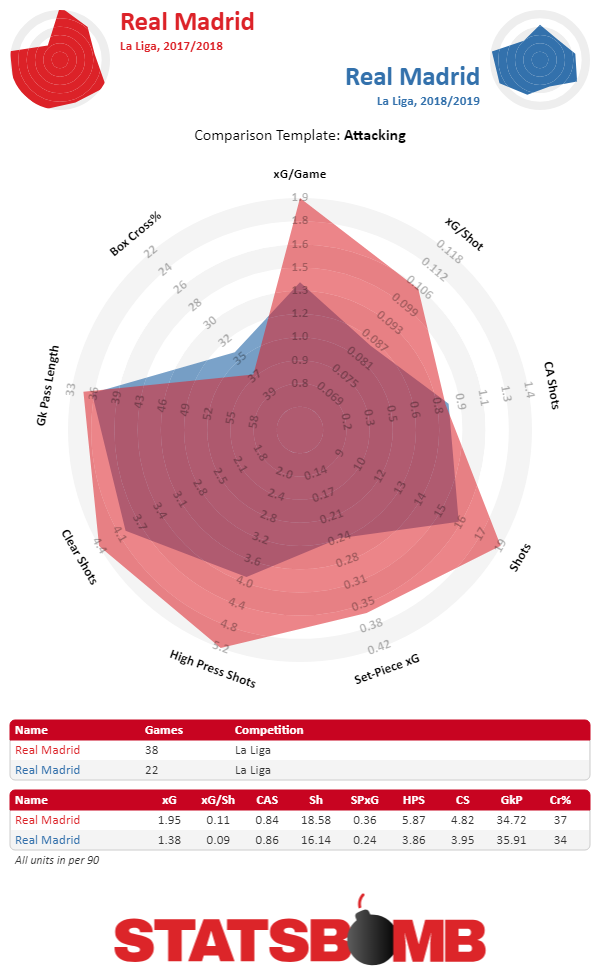
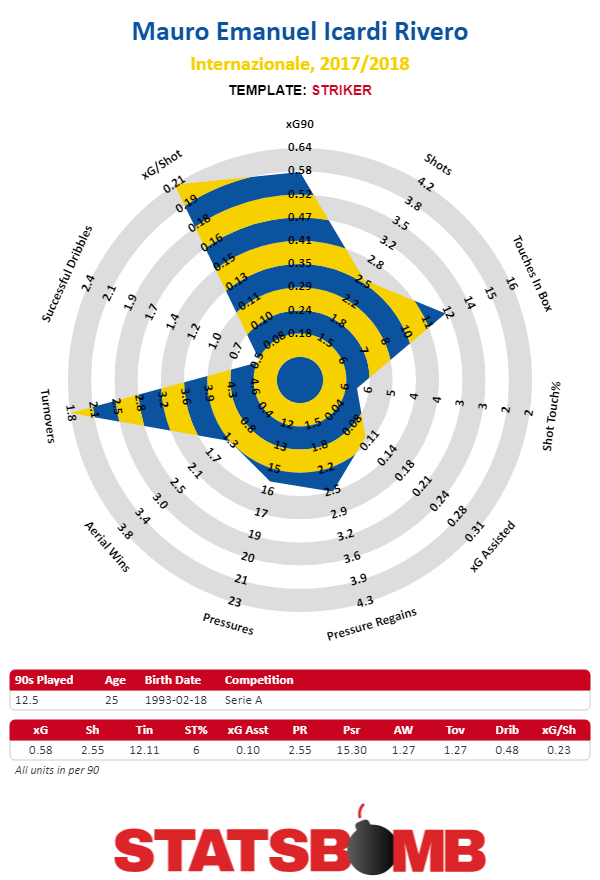 The case for Icardi is that while Benzema is proving himself unable to provide quite enough thrust as the main option, Icardi’s whole career has been about him being the central scorer for his team. There’s a real chance Icardi’s production in the box would increase dramatically as he played for a Madrid side with superstars feeding him the ball on a regular basis as opposed to working in Inter’s heavily cross based system. The concern of course is that while Benzema’s scoring comes with really good creative work, Icardi’s does not. But, Real Madrid don’t need a center forward who can facilitate somebody else, they need one who can score goals. If Icardi’s shooting volume goes up as he gets a higher level of service, he could end up as a mainstay of Madrid’s attack for the next five years. But, let’s say that Madrid are wary of Icardi’s relatively low shot totals. They don’t want to pay a hefty price for a forward that might not give them more goal scoring than the one they’ve got. Sure Icardi looks likely to thrive in front of Madrid’s midfield but it’s not a sure thing. Well, there are plenty of other options. Timo Werner stars for RB Leipzig. He’s taken 3.57 shots per 90 and averages 0.52 xG per 90. He’s much closer to a traditional shot machine. Icardi has tendencies to lurk around and then pop up for a great shot. Werner just shoots a lot.
The case for Icardi is that while Benzema is proving himself unable to provide quite enough thrust as the main option, Icardi’s whole career has been about him being the central scorer for his team. There’s a real chance Icardi’s production in the box would increase dramatically as he played for a Madrid side with superstars feeding him the ball on a regular basis as opposed to working in Inter’s heavily cross based system. The concern of course is that while Benzema’s scoring comes with really good creative work, Icardi’s does not. But, Real Madrid don’t need a center forward who can facilitate somebody else, they need one who can score goals. If Icardi’s shooting volume goes up as he gets a higher level of service, he could end up as a mainstay of Madrid’s attack for the next five years. But, let’s say that Madrid are wary of Icardi’s relatively low shot totals. They don’t want to pay a hefty price for a forward that might not give them more goal scoring than the one they’ve got. Sure Icardi looks likely to thrive in front of Madrid’s midfield but it’s not a sure thing. Well, there are plenty of other options. Timo Werner stars for RB Leipzig. He’s taken 3.57 shots per 90 and averages 0.52 xG per 90. He’s much closer to a traditional shot machine. Icardi has tendencies to lurk around and then pop up for a great shot. Werner just shoots a lot. 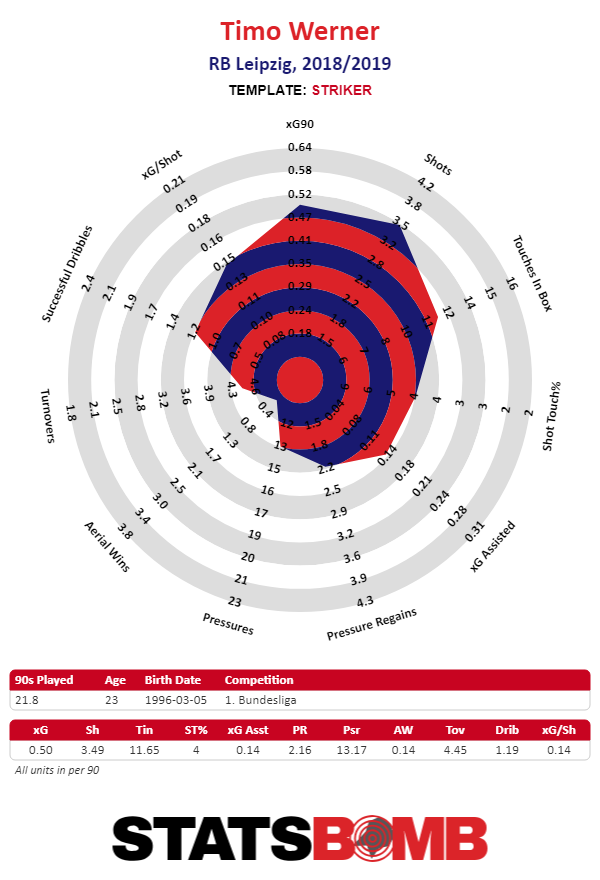 It’s not the best shot map. He lets fly from odd angles and doesn’t necessarily camp out in the center of the box, although Leipzig play a style that is more about getting Werner the ball in space than creating opportunities to pop up in the box after sustained possession. But you can’t knock the production. But, maybe the difference in styles spooks Madrid. They’d want to be confident that his game could adjust to a situation where he was playing in front of a team with lots of possession, rather than one looking to break all the time, Sure he’s only 22 and puts up huge numbers, but Bayern Munich are also likely to want him. Who wants to get into a bidding war over a striker that may not even be a stylistic fit. Not to worry there are still plenty more options. If Madrid wanted to take an ambitious swing there’s always Luka Jovic. At 21 he’s even younger than Werner. At Eintracht Frankfurt he plays on a worse team than Werner, but he puts up numbers that are just as big. Dude literally does nothing but sit in the box and score goals.
It’s not the best shot map. He lets fly from odd angles and doesn’t necessarily camp out in the center of the box, although Leipzig play a style that is more about getting Werner the ball in space than creating opportunities to pop up in the box after sustained possession. But you can’t knock the production. But, maybe the difference in styles spooks Madrid. They’d want to be confident that his game could adjust to a situation where he was playing in front of a team with lots of possession, rather than one looking to break all the time, Sure he’s only 22 and puts up huge numbers, but Bayern Munich are also likely to want him. Who wants to get into a bidding war over a striker that may not even be a stylistic fit. Not to worry there are still plenty more options. If Madrid wanted to take an ambitious swing there’s always Luka Jovic. At 21 he’s even younger than Werner. At Eintracht Frankfurt he plays on a worse team than Werner, but he puts up numbers that are just as big. Dude literally does nothing but sit in the box and score goals. 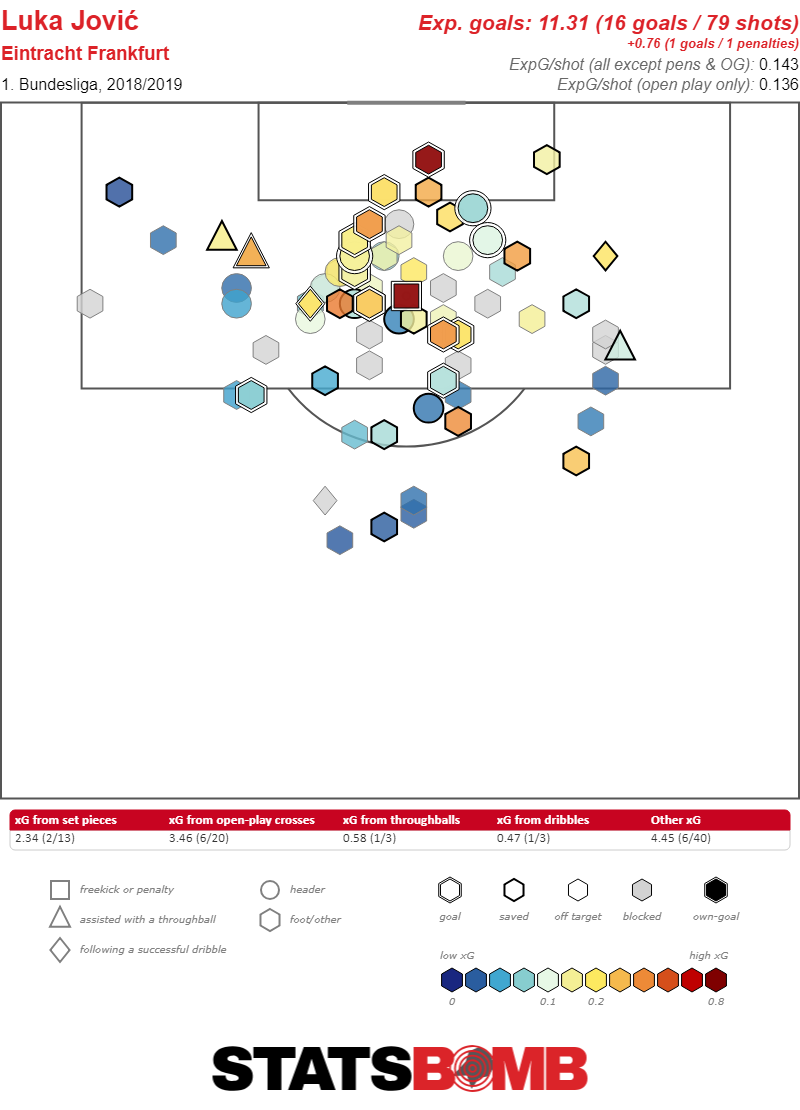 While Werner creates for himself with the ball at his feet, Jovic does not. Jovic gets himself into the middle of the box, sees ball, thwaps ball. Rinse, repeat. There are some teams where that might be a concern. Some teams might struggle to get Jovic the ball enough to take advantage of his skills in the box. Madrid certainly aren’t one of those teams. Stylistically he certainly seems like he’d be a fit for a team like Madrid. The concern here is that going from Frankfurt to Madrid is a major jump. Madrid would be gambling that he’d be able to perform not only week in and week out in the league but also that he’d be able to lead the line in the Champions League, that he’d be good enough to go toe to toe with the best defenders in the world and provide enough attacking thrust to come out ahead. It’s reasonable to think that he has that ability, but playing at Frankfurt he certainly hasn’t had the ability to show it yet. If Madrid don’t want to take any of those risks they could always look for a slightly better bargain in Arkadiusz Milik. Milik is only 24 and already has one catastrophic knee injury in his past. He’s also absolutely killing it this season for Napoli.
While Werner creates for himself with the ball at his feet, Jovic does not. Jovic gets himself into the middle of the box, sees ball, thwaps ball. Rinse, repeat. There are some teams where that might be a concern. Some teams might struggle to get Jovic the ball enough to take advantage of his skills in the box. Madrid certainly aren’t one of those teams. Stylistically he certainly seems like he’d be a fit for a team like Madrid. The concern here is that going from Frankfurt to Madrid is a major jump. Madrid would be gambling that he’d be able to perform not only week in and week out in the league but also that he’d be able to lead the line in the Champions League, that he’d be good enough to go toe to toe with the best defenders in the world and provide enough attacking thrust to come out ahead. It’s reasonable to think that he has that ability, but playing at Frankfurt he certainly hasn’t had the ability to show it yet. If Madrid don’t want to take any of those risks they could always look for a slightly better bargain in Arkadiusz Milik. Milik is only 24 and already has one catastrophic knee injury in his past. He’s also absolutely killing it this season for Napoli. 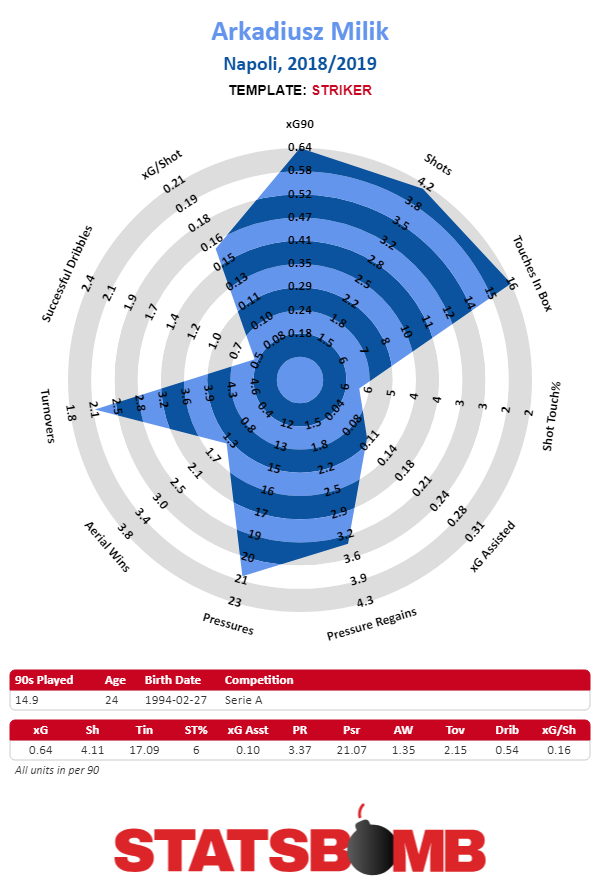 A 24 year-old player putting up these numbers without Milik’s history of tissue-paper knees would command a gigantic fee. The list for players who take four shots per 90 and also average over 0.15 xG per shot is exceedingly small. Across the big five leagues this season it’s Sergio Aguero, Kylian Mbappe, Milik, and Paco Alcazar. That’s it, that’s the list. Milik will likely come cheaper than his numbers this season indicate, which is justified because knees are important, and his may not exist. But, Real Madrid have the luxury of not necessarily needing Milik to be healthy forever. If they can buy him and get three good years out of him, and then he’s shot at 27, that’s a scenario that works out just fine to a team that has the resources to go replace him. When you’re operating at Madrid’s level there are very few perfect transfers. But, slightly below the can’t miss superstar level there are endless options that have different kinds of risks associated with them. Madrid’s focus should be on evaluating those risks and choosing which one makes the most sense. Instead, if Eden Hazard is to be believed (and who knows if he should be) they’re just avoiding trying to fix their main problem altogether.
A 24 year-old player putting up these numbers without Milik’s history of tissue-paper knees would command a gigantic fee. The list for players who take four shots per 90 and also average over 0.15 xG per shot is exceedingly small. Across the big five leagues this season it’s Sergio Aguero, Kylian Mbappe, Milik, and Paco Alcazar. That’s it, that’s the list. Milik will likely come cheaper than his numbers this season indicate, which is justified because knees are important, and his may not exist. But, Real Madrid have the luxury of not necessarily needing Milik to be healthy forever. If they can buy him and get three good years out of him, and then he’s shot at 27, that’s a scenario that works out just fine to a team that has the resources to go replace him. When you’re operating at Madrid’s level there are very few perfect transfers. But, slightly below the can’t miss superstar level there are endless options that have different kinds of risks associated with them. Madrid’s focus should be on evaluating those risks and choosing which one makes the most sense. Instead, if Eden Hazard is to be believed (and who knows if he should be) they’re just avoiding trying to fix their main problem altogether.